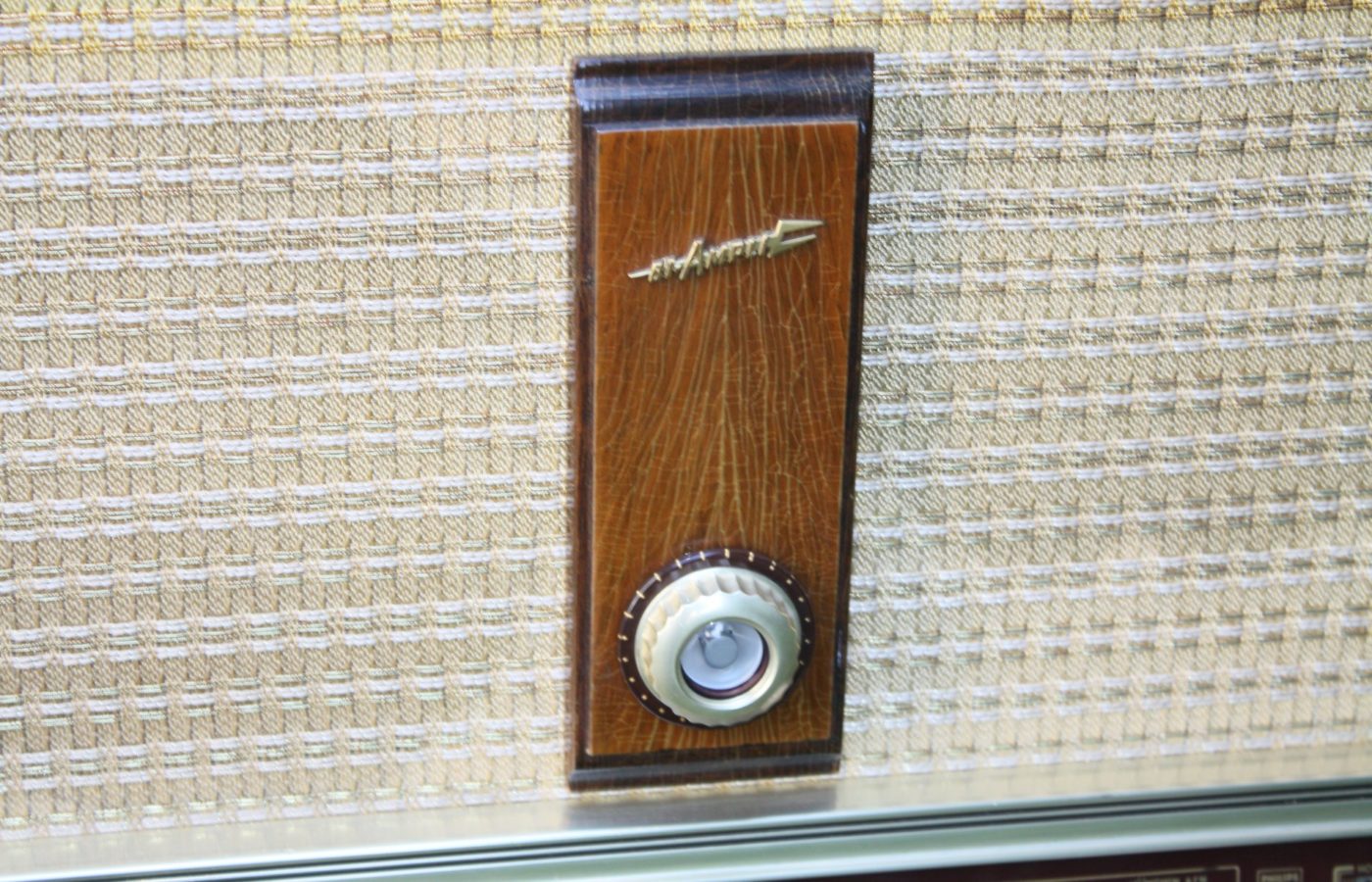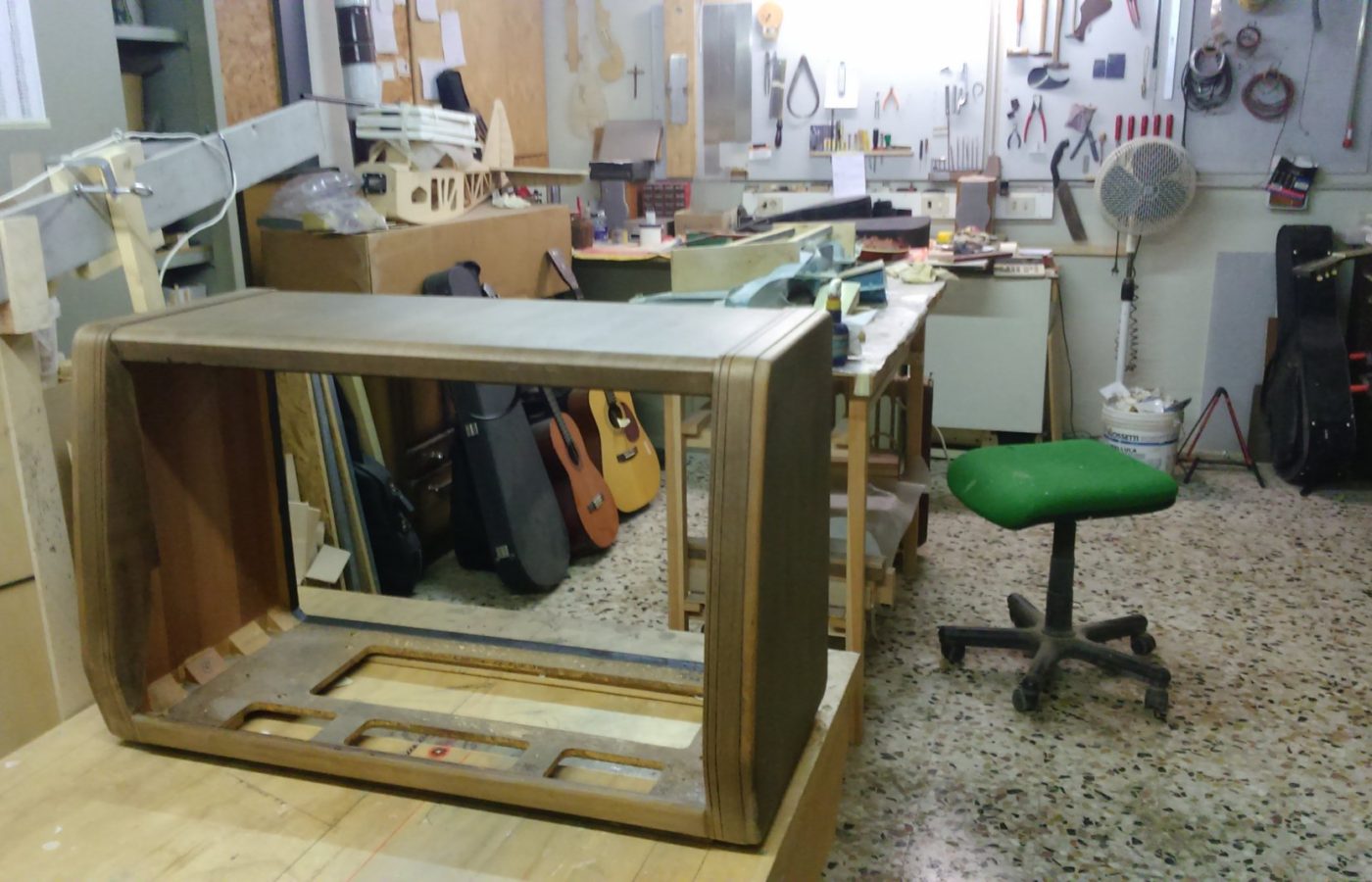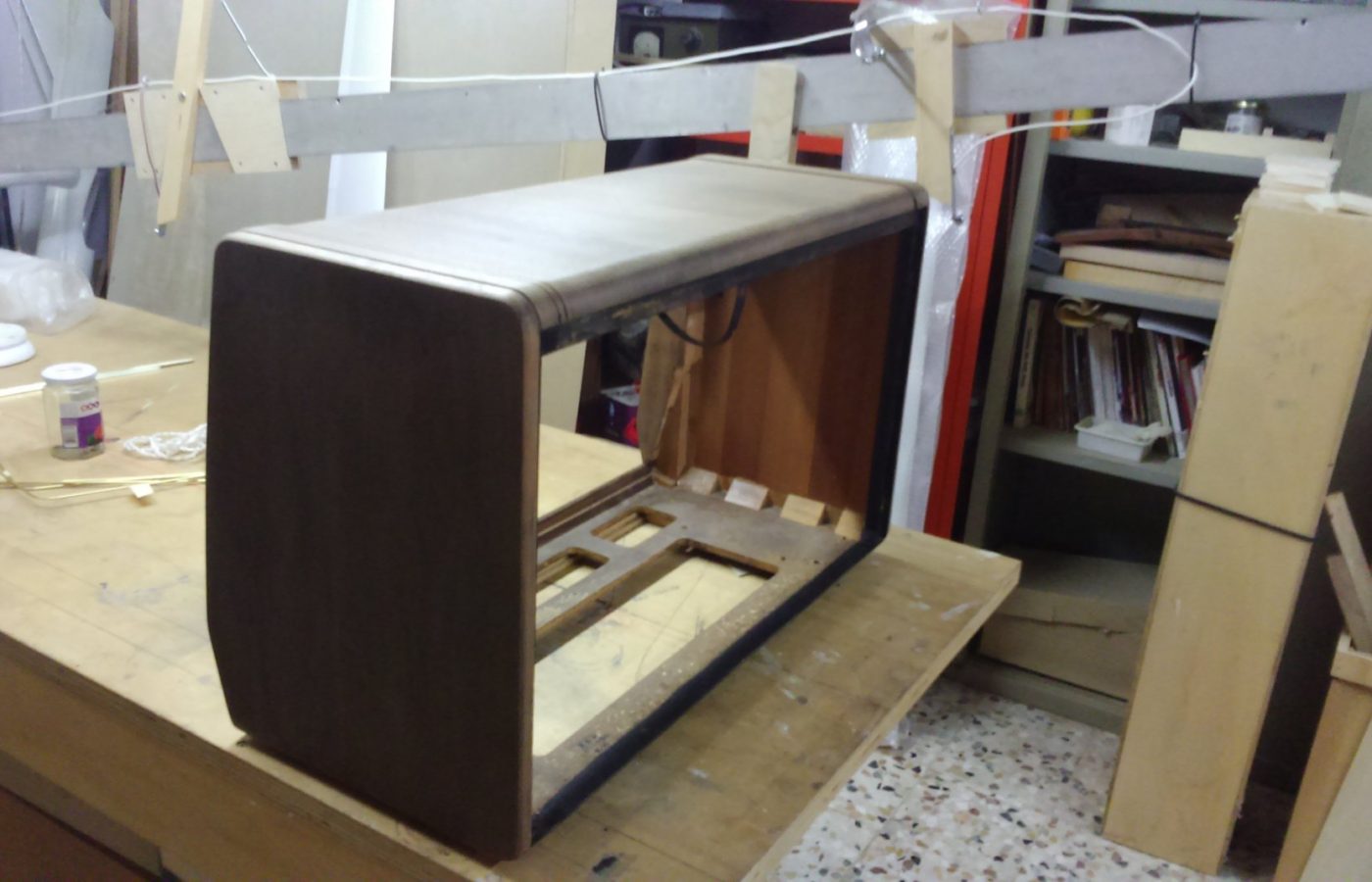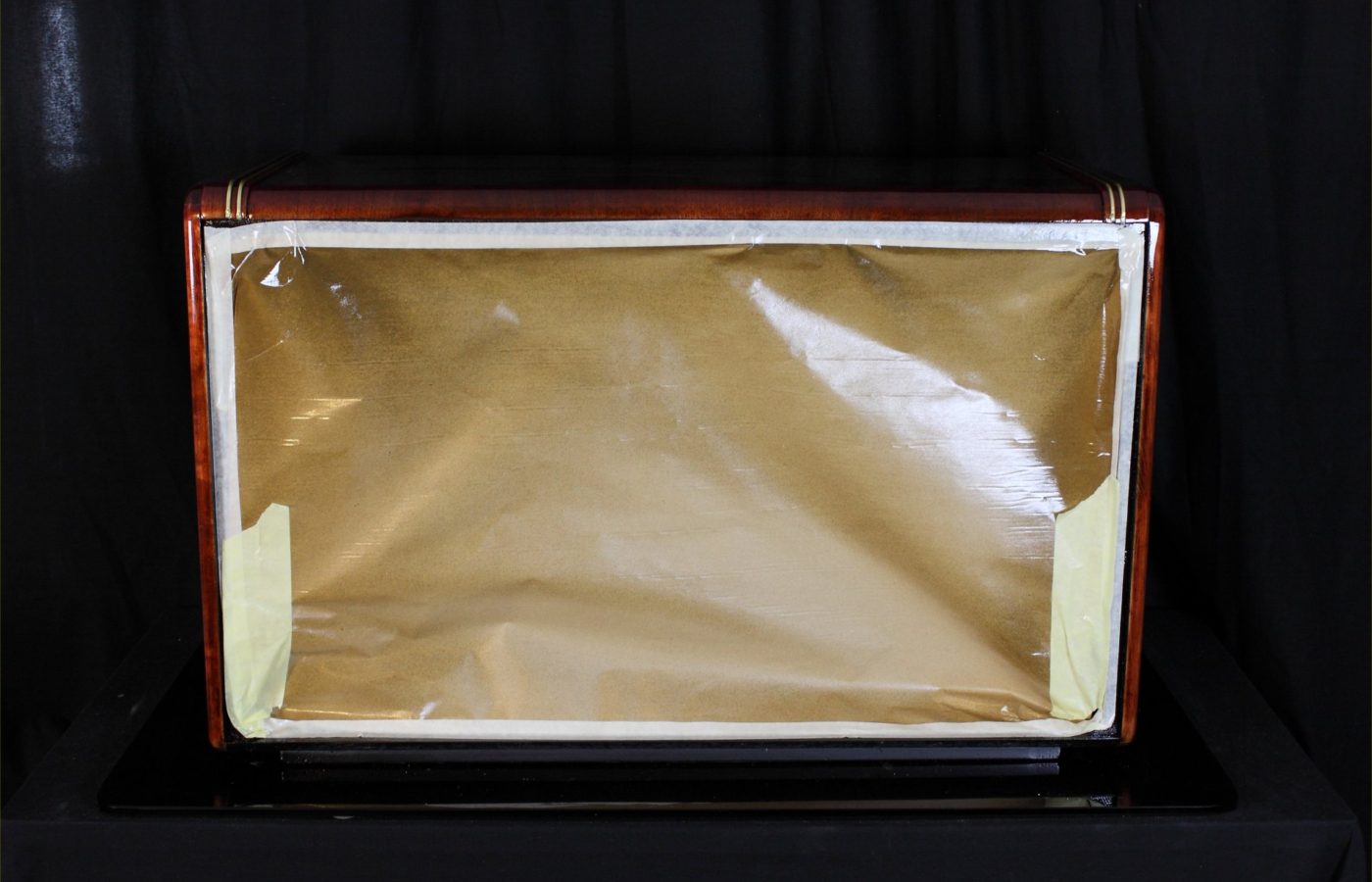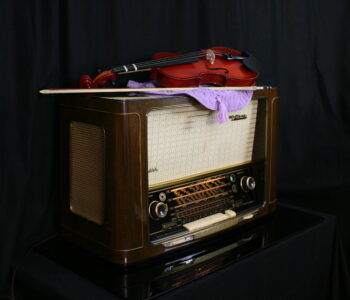 4055 - en
4055 - en
 4055 - en
4055 - en
 4055 - en
4055 - en
 german radios - en
german radios - en
Nordmende Tannhäuser 59
Tannhäuser, born into a family of knights in Salzburg, took part maybe in the sixth Crusade of 1228 and led a wandering life as a poet and a bard. He attended the court of Duke Frederick II in Vienna.
According to legend, during his life Tannhäuser found the Venusburg (mount of Venus), the subterranean reign of Venus, and lived with her for one year. He then left the goddess, full of remorse, and undertook a journey to Rome, in order to ask Pope Urban IV for forgiveness. The Pope reminded him that such sins lead to eternal damnation and promised to forgive him only in the event of a miracle: the appearance of flowers on his cane. Three days later Tannhäuser returned to Vienna and the cane bloomed.
The legend was put into music by Richard Wagner in his Tannhäuser.
Nordmende, in its heyday of technological growth, decided to name “Tannhäuser” its best device ever produced.
A device designed to represent the crest of the technical perfection of its time and extreme attention to detail.
The output stage is composed of a pair of EL84 in Push-Pull. The phase inversion is carried out with a section of the double triode ECC82 in Cathodyne configuration. This kind of inverter has an advantage, the possibility to be connected directly to its previous stage. Such stage consists of the remaining section of the double triode ECC82, which provides for the amplification of the signal after the attenuation deriving from the tone control circuit.
The triode contained in the multifunction valve EABC80 constitutes the input preamplifier and receives a signal from a logarithmic potentiometer with 3 intermediate sockets for a complex and very accurate physiological volume control circuit.
The radio section is of the same high quality. An additional medium frequency stage is present, in order to increase the selectivity.
This allows the receipt of transmissions, especially in FM, particularly stable and free from disturbance.
The complex of loudspeakers, moreover, is really impressive. All the loudspeakers are made by Isophon.
The reproduction of low and medium frequencies is ensured by a big elliptic woofer P 2031/19/105 which measures 31 cm in length and 20 in height.
To trebles, instead, are dedicated 5 loudspeakers built with 2 different technologies.
Frontally we have a 13 cm midrange for a soft reproduction, perfectly integrated with that of the woofer.
On each side was placed the famous HM 10/12/70 cone tweeter and an ST HB7 electrostatic tweeter
As Baudelaire wrote, the Tannhäuser represents the struggle between the two principles which choose the human heart as their battlefield, that is the flesh against the spirit.
Nordmende honoured this great piece of work with the realisation of its best product.
Frontally, we can find the famous cone tweeter HM 10/12/70 The trumpet exit of a DKS 6/13/100 and an electrostatic tweeter ST HB7 were put on each side.

Bluetooth receiver embedded
Each radio is equipped with a cable for connection to any digital device.
- Bluetooth receiver embedded - The unit is equipped with a BLUETOOTH receiver powered directly by the receiver power supply. This makes it possible to control the amplifier from any external digital device as an IPAD, a Smartphone, or a sophisticated multimedia station. So you can hear your preferred web station or your lossesless file without cables on the room. Wireless Receiver can be equipped upon requests.
- Multi Platform Connection - A customized adaptation cable to connect any digital device as Iphone, Smartphone, Laptop, CD Player etc. will be provided with this radio. This special cable suits the different impedances between the modern equipment and the receiver. Furthermore the two stereo channels flow into one without increasing the load to the input unit.

In 1923 Otto Hermann Mende founded Radio H. Mende & Co. in Dresden. After the bombing of the factory in 1945, Martin Mende (son of the founder) created a new company in Bremen, the "North German Mende Broadcast GmbH" whose name was later changed into NORDMENDE.
In the 50s and 60s it became one of the most prestigious German TV and radios manufacturer.
In the 70s the televisions by NORDMENDE became famous for their frames, cards and for the rigorous testing and quality controls carried out on their finished products. Unfortunately, the high cost involved in such detailed quality determined a competitive disadvantage when the price of color television began to fall.
In 1977 the majority of the shares was sold to the French Thomson. The following year, the family sold the remaining shares. In 1980, the factories of Bremen was closed, NORDMENDE becoming purely a trademark of Thomson.
Thanks Dan Ludington for the image.
Year of production: 1958/59
Superheterodyne IF 468/10700
10 AM Circuits
13 FM Circuits
Wavebands:
Medium Waves (OM), Long Waves (OL), Short waves (OC), FM (UKW)
Loudspeakers:
1 woofer
1 cone midrange
2 horn tweeters
2 electrostatic tweeters
Dimensions (LHD):: 700 x 420 x 290 mm / 27.6 x 16.5 x 11.4 inch
Net weight: 16.3 kg / 35 lb 14.4 oz
9 Tubes: ECC85 ECH81 EF89 EF89 EM34 or EM35 EABC80 ECC82 EL84 EL84
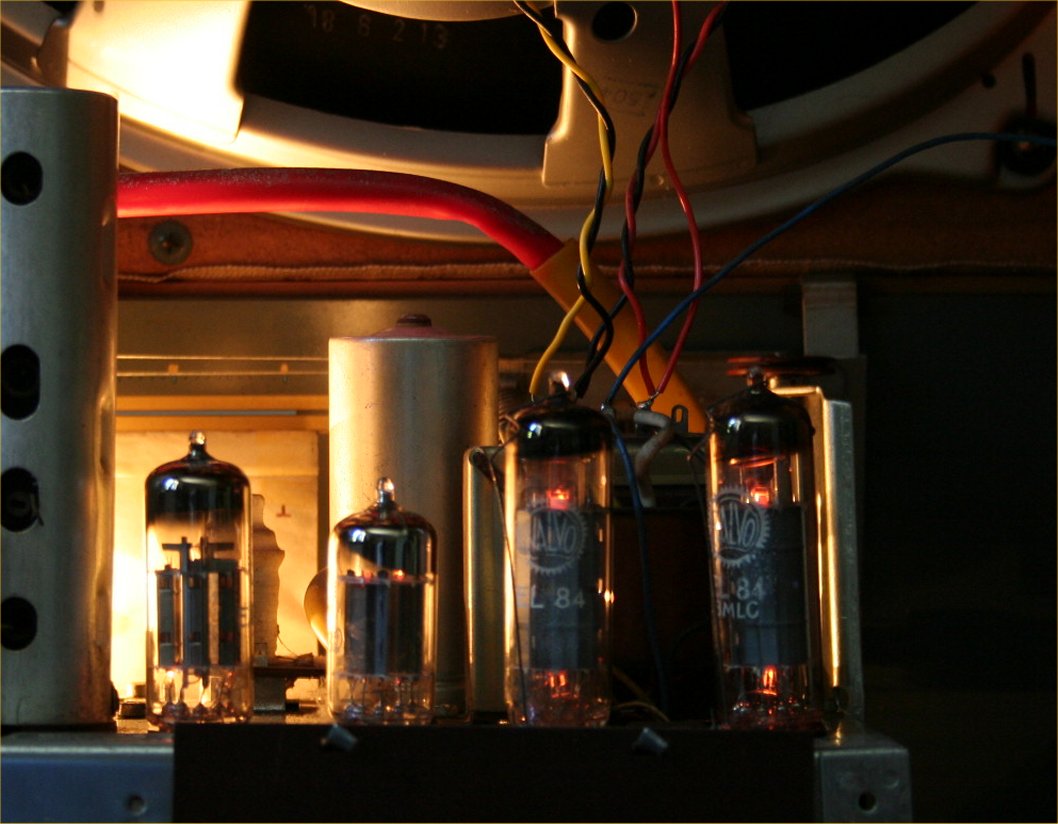
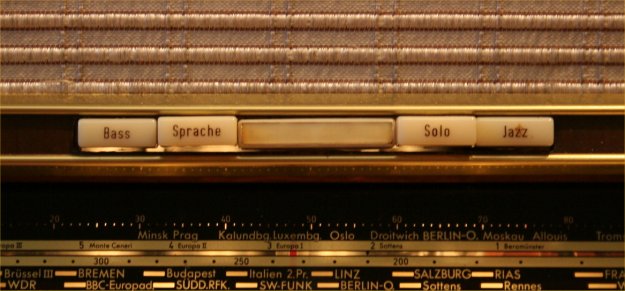
The device has been equipped with a frequency response correction system independent of the tone controls.
It is made up of 5 keys which insert predefined equalization curves operating on the feedback circuit (they are not passive filters).
The Bass key emphasizes bass tones.
The Sprache key boosts the mid-range for cleaner listening to spoken broadcasts.
The Expander key (the large central one) inserts a feedback curve that slightly favors the mid-bass tones, increasing the sense of space.
The Solo key slightly accentuates the mid-tones for easier listening to single instruments.
The Jazz key greatly emphasizes the low and high tones to facilitate listening to this musical genre.
The tones control system is very efficient.
Above the large tone control knobs there is a band that lights up gradually indicating the emphasis on the band on which it acts.
The treble control knob is connected to the ferrite in the MF transformers and varies the slope of the transformer bell. In this way, when you are in the AM bands, the treble tones are further accentuated even before arriving in the BF amplifier stage.

BASS MAX

Bass flat
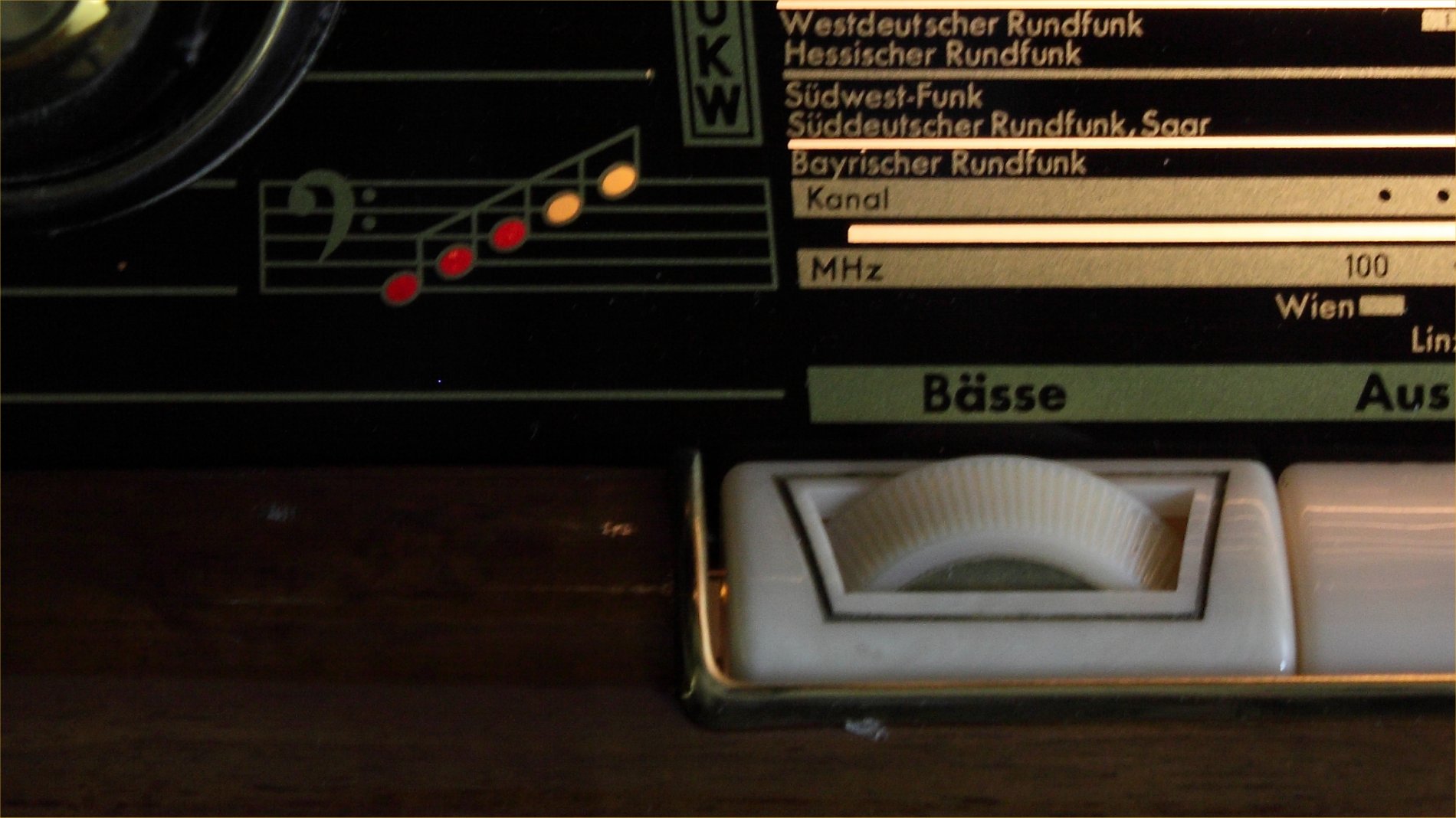
BASS MIN

TREBLE MIN

TREBLE FLAT

TREBLE MAX

Inside the cabinet there is a dipole for FM reception and a ferrite rotating aerial for AM reception.
Ferrite aerial can be rotated from the outside to achieve a perfect tuning of the device in the AM.
In this picture see the rotation mechanism and the position indicator of the aerial.
The reception sensitivity with internal aerials is very good. This unit was in fact produced in a period when there were not many radio stations and those available fairly apart from each others.
Using an external aerial sensitivity is further increased.
The tuning system is another gem.
The unit is equipped with mechanisms for keeping separate the AM and FM bands.
The tuning knob is single but a selector switch commutes into cable systems (all in steel) and pulleys separated depending on the band.
The movement is transferred to both mechanisms with a system of pulleys and separated gears.

The magic eye has of course been replaced.

The loudspeakers are six.
In the front we find the biggest elliptic broadband built by Isophon, very linear and efficient. Also frontally, we find an Isophon cone midrange.
In order to obtain a 3D effect, we find on the sides two cone tweeters with two electrostatic SuperTweeters.
The acoustic performance is really generous.
None of the radios I know has the same dotation of loudspeakers.
Above the dial, in the loudspeakers panel we find the series of buttons of the Bandbreite Schltbar, previously described.
Moving downwards on the tuning-dial, we first find the magical eye, which indicates the perfect tuning of each station. Below, we find the volume control (with integrated loudness).
By pulling the volume knob, the circuit which powers selectivity in the AM bands is inserted.
From the top down are then indicated the AM dial for Long, Medium and Short bands and below we find the FM dial.
Moving further right, we find the indicator of the position of the ferrite aerial.
Finally, there is the tuning knob, which movement is very pleasant as it is supported by a big flywheel.
Coaxial to the harmony knob is the knob which rotates the ferrite aerial.
Below on the left we find the treble control knob set in a nice bakelite casing with ivory effect.
In the following order, then, we find the buttons:
AUS - Off
TA - Turntable
TONBAND - Tape recorder
L - Long Wave
Peil-Ant - Ferrite antenna for LW and MW
M - Medium Wave
K - Short Wave
UKW - FM
On the right, the bass control is visible.
Above the tone controls, the respective emphasis indicators of the controls.
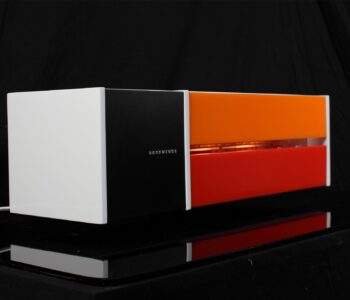 german radios - en
german radios - en
Also this reviews will be accompanied by a section with graphs of technical measures of the most important parameters.
There is no such thing anywhere else, as far as I know. Not even the manufacturers themselves detailed the technical features of their own devices at this level.
This new section has been developed for an objective comparison of different devices.
In order to avoid interpreting the measurements incorrectly, it is very important to read the warnings carefully the first time.
The Nordmende Spectra Futura is the only transistor device of the German brand that we will review on this site.
We will examine it for its design resulting from the collaboration between the Nordmende design center and the famous American designer Raymond Loewy.
Will talk about Loewy later on this page. However, we all know the products he designed, such as the Coca-Cola bottle or the Lucky Strike pack.
Collaborating with the American designer was a very good choice. The device was a sales success and overshadowed all similar radio receivers of other brands, which sometimes tried to awkwardly imitate its shapes.
It was produced in many versions, with many color combinations, as shown in the brochures of the time shown here.
The most flamboyant model is certainly the Orange-Red, while the most elegant is with solid aluminum bands and wooden cabinet.
Nordmende produced both monophonic and stereophonic versions of this device. Both models are visible in the photos on this page. Obviously the stereophonic version is the most satisfying from a musical point of view.
The electronic design of this model is interesting from our point of view. Being a few years that the transistors were used for commercial purposes, the circuits were very similar to the tube circuits. The voltages and polarizations changed, but the principle schemes were almost the same, so the sound of the amplifiers of this period is close to the sound of the tube ones.
The FM section is quite stable, very traditional and time-tested.
Conclusions: A beautiful device to look at, which adapts to modern as well as vintage furnishings, with a pleasant and sufficiently powerful sound. A piece of design made in the USA in a machine made in Germany in a handcrafted restoration made in Italy.
__________________________________________________________________________________________________________
The first song is by Megan Thee Stallion and Dua Lipa, it's called Sweetest Pie. Megan Jovon Ruth Pete, aka Megan Thee Stallion for her imposing build, is a Texan rapper and girl prodigy. In a few years he has received considerable public and critical success, famous on TikTok his Savage remixed with Beyoncé. In 2021, she was awarded Best Debut Artist. In 2022 he published in collaboration with the singer Dua Lipa, Sweetest Pie (Sweet cake). The song is permeated with very explicit sensuality, as is Megan's style. An irreverent debut in the presentation of the spectacular Nordmende Spectra Futura.
And irreverence and sensuality are the leitmotifs of the second piece, The quadrille of bullfighters from Bizet's Carmen.
The apparent lack of morality of the protagonist, her vitality, the immeasurable propensity for freedom make her incomprehensible, unacceptable to Don José, who falls madly in love with her and as in the worst traditions will end up killing her. The Spectra Futura, despite the small numbers, manages to highlight the chorus and the orchestra with a momentum typical of much more muscular machines.
The third song, played by Antonio Serrano (mouth organ) and Javier Colina (double bass,) is actually by Stevie Wonder, Overjoyed. The title, overflowing with joy, does not hide the meaning and impulse of the piece. The text of "Overjoyed" speaks of a love not reciprocated, indeed, hidden, lived all alone on one side. Stevie wants to reveal to his beloved how deep is the feeling he has for her, hoping that she will accept it and reciprocate. Musically, the piece is characterized by the continuous changes of key and the use of natural sounds as a rhythmic basis. Serrano's harmonica is well enhanced by the Spectra Futura which puts it a head ahead of the double bass, as it should be.
The fourth song is the famous Back to Black by Amy Winehouse. “Back to Black” means returning to a state of depression after the end of a love affair. She specifies that it is a state of despondency in which the pain of loneliness drowns in alcohol and drugs. The reference is to the tormented story with Blake Fielder-Civil, which led to her death after a physically and psychologically toxic marriage, where Amy, already debilitated by eating disorders, did not last long.
The fifth song, again by Stevie Wonder, dedicated to his wife, Syreeta Wright. You are the sunshine of my life. The couple was actually already divorced by the time the song hit. Their marriage has always been difficult due to the singer's work schedule. "I've always lived in his shadow," Wright said. However Wonder was very devoted to Syreeta. In the song the husband looks at his now familiar wife and remembers why he loves her and promises he always will. But it didn't work out for this couple.
Raymond Loewy appears twice on the cover of the prestigious TIME magazine, in 1949 and 1990 as one of the 100 most influential Americans of the 20th century
Born in Paris in 1893, he emigrated to the USA at the end of the First World War. He was one of the most prolific and creative designers in the world, and perhaps deserves the title of father of industrial design.
His work is not limited to a single sector but extends over the most diverse areas.
Much can be read about his work online and in the numerous books dedicated to him, but probably few know that in 1973 he worked on a diplomatic project between the United States and the USSR with the aim of easing tensions between the two countries during the Cold War period.
A very small part of his most famous works
1939 - The Pennsylvania Railroad S1 steam locomotive
1940 - The pack of Lucky Strike cigarettes
1954 - The Scenicruiser bus for Greyhound company
1955 - Coke - The first large format bottle, and in 1960 the first steel can.
1962 - Studebacker Avanti with bodywork made of fiberglass reinforced polyester, speed over 240 km/h.
1962 - Air Force One, designed following the color indications of President John Kennedy, who followed the tastes of First Lady Jaqueline.
1967 - The Nordmende Spectra Futura designer radio, which was successfully marketed the following year.
1971 - Shell logo, which has remained almost unchanged to this day.
Bluetooth receiver embed
Each radio is equipped with a cable for connection to any digital device.
- Bluetooth receiver embed - The unit is equipped with a BLUETOOTH receiver powered directly by the receiver power supply. This makes it possible to control the amplifier from any external digital device as an IPAD, a Smartphone, or a sophisticated multimedia station. So you can hear your preferred web station or your lossesless file without cables on the room. Wireless Receiver can be equipped upon requests.
- Multi Platform Connection - A customized adaptation cable to connect any digital device as Iphone, Smartphone, Laptop, CD Player etc. will be provided with this radio. This special cable suits the different impedances between the modern equipment and the receiver. Furthermore the two stereo channels flow into one without increasing the load to the input unit.

1923 - Otto Hermann Mende founds Radio H. Mende GmbH in Dresden producing radios under the brand name “Mende”.
1939 - During World War II the government requests to produce bomb detonators.
1945 - The factory is partially destroyed by bombing and dismantled by the Soviet Union.
1947 - Martin Mende (son of the founder) sets up a new company in Bremen the North German Mende Broadcast GmbH. Whose name is later changed to NORDMENDE. The operational headquarters are established in the former Focke-Wulf aircraft factory in Hemelingen.
1950 - Becomes one of the most prestigious German radio manufacturers. Since 1950, development engineers have been planning the production of televisions.
1953 - The demand for televisions grows and Nordmende is already prepared.
1961 - Nordmende produces the first television with an ultrasonic remote control.
1964 - A new factory is opened in Wildeshausen, then in Bremerhaven, Sittensen and finally in Verden in 1972
1968 - The company is oriented to design products and comes out the "Spectra Futura" designed in collaboration with the famous designer Raymond Loewy.
1969 - The sons Karl and Hermann take over the management and soon have to deal with the onset of the crisis. Competitive pressure was mounting, the market was "saturated" and the high cost of such quality proved to be a competitive disadvantage when the price of color televisions began to fall.
1977 - Company shares were sold to the French group Thomson-Brandt. But even this did not bring the hoped-for help and so in 1980 the last shares of the Nordmende company were sold.
1980 - The production of audio devices is transferred to France, but the French group was not organized and some absurd choices were made such as the division of labor in production and assembly between the plants in Villingen (Saba) and Bremen, which still made more complex and expensive to produce.
1981 - The first factories in Germany are closed. The same fate will befall the other companies controlled by the French group, such as Dual, Saba and Telefunken.
1987 - Europart's plan, 25% owned by the Thompson group, also failed and in the 1990s the new company filed for bankruptcy. Saba, Nordmende and Telefunken merged and remained part of the Thompson group.
Year of production: 1968/70
Superheterodyne IF: 460/10700
7 Circuits AM - 11 Circuits FM
Wavebands: Medium Wave (OM), Long Wave (OL), Short Wave (OC), FM (UKW)
Speakers:
1 full-range 13 cm
Dimensions (LHP) : 594 x 156 x 162 mm / 23.4 x 6.1 x 6.4 inch
Net Weight: 8.2kg / 18lb 1oz 21kg / 46lb 4.1oz
Transistor 13: 3 x AF106, 2 x AF121, AF125, AF137, BFY39IV, BFY39II, BC139, AD161, AD162, AC122, AD150, 3 x AA112

BANDWIDTH
Normally the measurement of the bandwidth is done on a resistive load. The deformation caused by the loudspeakers' inductive load and the effect of the mechanical resonance of the speakers themselves on the feedback circuit are not considered. The effects are by no means negligible, the measurements carried out on a purely resistive load are always very linear but they don't coincide with the real frequency response.
On the other hand, this response curve was measured on an inductive laod, that is, with its own loudspeakers.
The frequency response measurements were made with a sinusoidal generator and a Wandel & Goltermann WM – 20 level meter.
You can see the actual frequency response on the vobulator' screen.
As you can see the low tones are slightly enhanced due to the always active loudness correction.
TONE CONTROL
The measurement is always taken on an inductive load, i.e. with its own loudspeakers.
In the image on the left you can see the effect of the bass control in the maximum exaltation position.
In the image on the right you can see the effect of the treble tone control in the maximum exaltation position.
RMS POWER
We consider as Maximum Power the square of the lower of the RMS voltages measured at the three sample frequencies divided by the load resistence.
The measurement conditions are the following:
- sample frequencies, 100, 1000, 10,000 Hz
- 8 ohm resistive load
- distortion less than or equal to 1%.
The measuring instrument provides the RMS value directly.
The measured RMS power is 4.6 W
INTERMODULATION DISTORTION %
The Intermodulation Distortion % was measured with the SMPTE standard and measured at 1W RMS.
The two measurements were carried out by modulating the 50 Hz sine wave with a 1080 Hz sine wave and then with a 10400 Hz sine wave, with an amplitude in a ratio of 1/4 compared to the basic sinusoid.
The output voltage was kept around 2.83V on an 8 ohm carico.
The measured Intermodulation Distortion % (IM%) is 0.13%
The original speaker, or speakers in the stereo model, is a modest Isophon P13F.
Its most important features are:
Maximum power 5W
Resonance frequency 130Hz
Frequency response 80-14000Hz
Sensitivity N.C.
The loudspeaker seemed to us not being able to fully express the good characteristics of the amplifier, for this reason we decided to replace it with an excellent JBL GTO525e or similar.
The features of the last is completely different:
Maximum power 135W
Resonance frequency 80Hz
Frequency response 70 - 21000Hz
Sensitivity 92dB
With this new loudspeaker the frequency response and power handling have changed radically.
Compatibly with the small dimensions of the cabinet and the limited power, the sound is now much warmer and more convincing. The effect of exaggerated emphasis of the mid tones due to the difficulty of reproducing the low and very high tones of the old loudspeaker has completely disappeared.
In the end, a beautiful sound capable of filling even a medium-sized room.
1 - Volume control (with loudness built-in)
2 - The bass control knob
3 - The treble control knob
4 - TA - AUX
5 - L - Long Waves
6 - M Medium Waves
7 - K - Short Waves
8 - U - FM
9 - AUS - Turn off
15 - FM sensitivity switch
16 - FM tuning knob
17 - AM tuning knob
1 - The treble control knob
2 - The bass control knob
3 - Balance Control
4 - Volume control (with loudness built-in)
5 - Stereo broadcast indication
6 - Tuning indicator
1 -
2 -
3 -
7 - AFC - Automatic frequency Control
8 - STEREO - Mono/Stereo switch
9 - TA - AUX
10 - L - Long Waves
11 - M Medium Waves
12 - K - Short Waves
13 - U - FM
14 - AUS - OFF switch
15 - FM sensitivity switch
16 - FM tuning knob
17 - AM tuning knob

 german radios - en
german radios - en
The Philips Saturn 653 / 4E / 3D is the second most important model of the house in 1955, and in the intentions of the manufacturer aspires to be one of the most popular models of all German production for the innovative technology used.
As a matter of fact, they met their goal and produced a unique piece of technology, for both the German and World Wide market.
It’s peculiarities are:
The Philips Saturn 653 / 4E / 3D has dimensions in line with the top models, but it’s woodwork, frames, and speaker covers contribute in giving it a much sleeker, eye-pleasing look to complete any furniture display.
The Low frequencies are particularly deep thanks to the separated OTL amplifiers and to the impressive size of the subwoofer, approximately 21cm in diameter (more or less 8.3 inches).
Exactly the same as for the Capella 753/4E/3D model I suggest making good use of the mid-tweeter, as this successfully crafted speaker (17 cm in diameter) makes the mid and Hi frequencies pleasant and true to life, especially if seated in front of the Machine.
High and Mid Frequencies sections
The FM group is of the variable permeability type. It has a high amplification and stability.
Being equipped with an automatic noise suppressor in the presence of signals below 1.7 V, the output is muted to avoid hearing rustling and noise when searching for stations.
The de-emphasis circuit is set to 50 uS, valid all over the world except for the USA and South Korea. In these countries, the filter should be increased to 75 uS.
The AM section is equipped with a rotating antenna for the OM and OL bands. The antenna can be controlled by a knob on the front.
The mid-frequency sections are composed of three separate filters for AM and FM. The first of these filters is adjustable. The second is the amplifier filter and the third filter further increases the selectivity of the device.
All the listed solutions translate into a very low distortion, an increase in power, and a pleasantness of use hardly ever obtained in other appliances.
This is the Philips Saturn 653/4E/3D

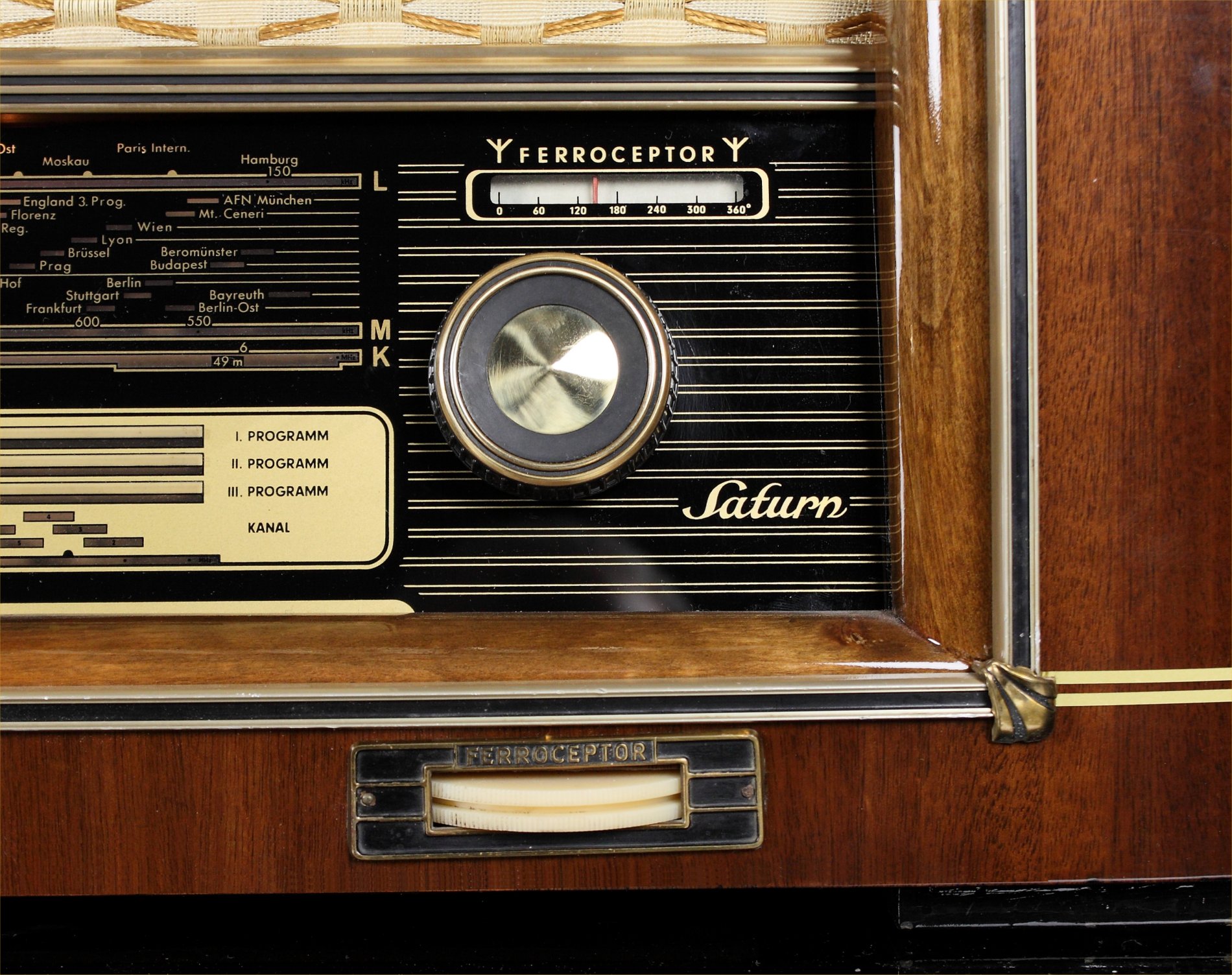
Bluetooth receiver embed
Each radio is equipped with a cable for connection to any digital device.
- Bluetooth receiver embed - The unit is equipped with a BLUETOOTH receiver powered directly by the receiver power supply. This makes it possible to control the amplifier from any external digital device as an IPAD, a Smartphone, or a sophisticated multimedia station. So you can hear your preferred web station or your lossesless file without cables on the room. Wireless Receiver can be equipped upon requests.
– Multi Platform Connection – A customized adaptation cable to connect any digital device as Iphone, Smartphone, Laptop, CD Player etc. will be provided with this radio. This special cable suits the different impedances between the modern equipment and the receiver. Furthermore the two stereo channels flow into one without increasing the load to the input unit.
In 1891, the brothers Gerard and Anton Philips, started to produce the first incandescent bulbs in Eindhoven.
Later, Philips specialized in the production of electro- medical equipment, and in 1918 introduced the first X-ray tube.
In the following years, Philips began specializing in the broadcasting industry. In 1932 the company succeeded in selling over one million radio equipment and became the world’s first producer.
During the Second World War, Philips transferred to the Netherlands Antilles, and returned to the Netherlands at the end of the conflict.
In 1958 Philips was the only multinational to have a pavilion dedicated to the Expo in 1958 known as Le Poème Electronique.
In the second post- war period, began the production of the first televisions, then the launch of the music cassettes in 1963 and the production of the first integrated circuit in 1965.
In 1982 Philips launched with Sony the first compact disc player.
In 1984 Philips acquired the control of the German Grundig.
In the 90's Philips faced a financial crisis.
In 1991 it inserted on the market the Video CD and it is one of the first companies in the world to develop high definition television.
In 1999 Philips established a joint venture with LG Electronics, named LG Display, which ends in 2009.
In 2006 together with Sony launched the first Blu-ray.
In 2009 Phillips launched the first full-HD LCD TV in 21:9 format.
Phillips holds 48,000 registered patents.
Currently, the production is focused on low- energy lighting products and LED systems and services for diagnostics and production of medical devices.
Year of production: 1955
8 AM Circuits
11 FM Circuits
Wavebands:: LW, MW, SW, FM
Loudspeakers:
1 sub-woofer
1 mid-woofer
2 mid-tweeter
Operating voltage (CA): 110; 125; 220; 240 Volts
Dimensions (LHP): 680 x 415 x 265 mm / 26.8 x 16.3 x 10.4 inch
Net weight: 13.4 kg / 29 lb 8.2 oz
11 Tubes: ECC85 ECH81 EF89 EBF80 EM80 EABC80 EC92 UL41 UL41 EL84 EL84
Rotating ferrite aerial for AM bands
Ironless output



The preamplifier consists of two stages. At the entrance, the volume potentiometer is equipped with three sockets for physiological correction (loudness). The intervention curves are visible in the first graph.
Philips considers the frequency of 800 Hz to be the center of the audible band, so the treble and bass controls are calculated to enhance the frequencies above and below that value. The choice of this frequency is very important for the musicality and the pleasantness perceived by listening to the device.
In the second graph the frequency response of the preamplifier, with the tones enhanced to the maximum. You notice the different equalization you get by listening to the AM bands (Long Waves, Medium, Short) or listening to the FM band and PHONO.
The final stages are two distinct, one for the low frequencies and one for the high frequencies. These amplifiers control separate speakers, a 26 cm woofer for the bass and three speakers for mid/high frequency, with the 17 cm front speaker disconnectable for 3D effect.
The most interesting feature of these final stages is that they are without an output transformer.
The feature that makes this device very interesting is that each final stage uses a pair of EL84 / UL41 in an ironless configuration, ie without an output transformer (the known critical point of the final stage).
The output stage uses the operating principle called Shunt Regulated Push-Pull (SRPP) used today in HIGH-END amplifiers.
The output transformer limits the bandwidth of the entire amplifier. The bass is limited by the inductance of the primary winding, the treble is limited by the parasitic capacitance resulting from the alternation of the primary and secondary windings. The alternating winding of the primary and the secondary windings is also necessary to improve the coupling and thus reduce the dispersed flow.
The reduction of the dispersed flow increases the damping. This is essential in the loudspeakers mounted inside the cabinet of the radios, which do not work in hermetically closed boxes, and which are therefore free to move almost without resistance from the surrounding air.
The two output tubes (EL84, UL41) of each channel, four final valves in total, are connected in series with DC-DC coupling. Each UL41 is configured as a triode.
The output is taken from the cathode of the UL41. The speaker has an impedance of 800 ohms, identical to the average impedance that occurs on the catode, whereby direct coupling (without transformer) is possible between the final stage and the loudspeaker.
The Philips Saturn 653 is therefore totally free of all the problems deriving from the output transformers.
The damping of the loudspeakers is kept high by the low dynamic resistance of the feedback loop.
The tones control system is very efficient.
Above the large tone control knobs there is two bands that lights up gradually indicating the emphasis on the band on which it acts.
The high-tone control knob is linked to two thin ropes. One of them is for the position indicator of the control itself, whereas the other changes the position of the ferrite in the MF transformers modifying the its curve.
By doing so high tones were attenuated/accentuated even before getting to the BF stage.

Bass at max - Treble at max
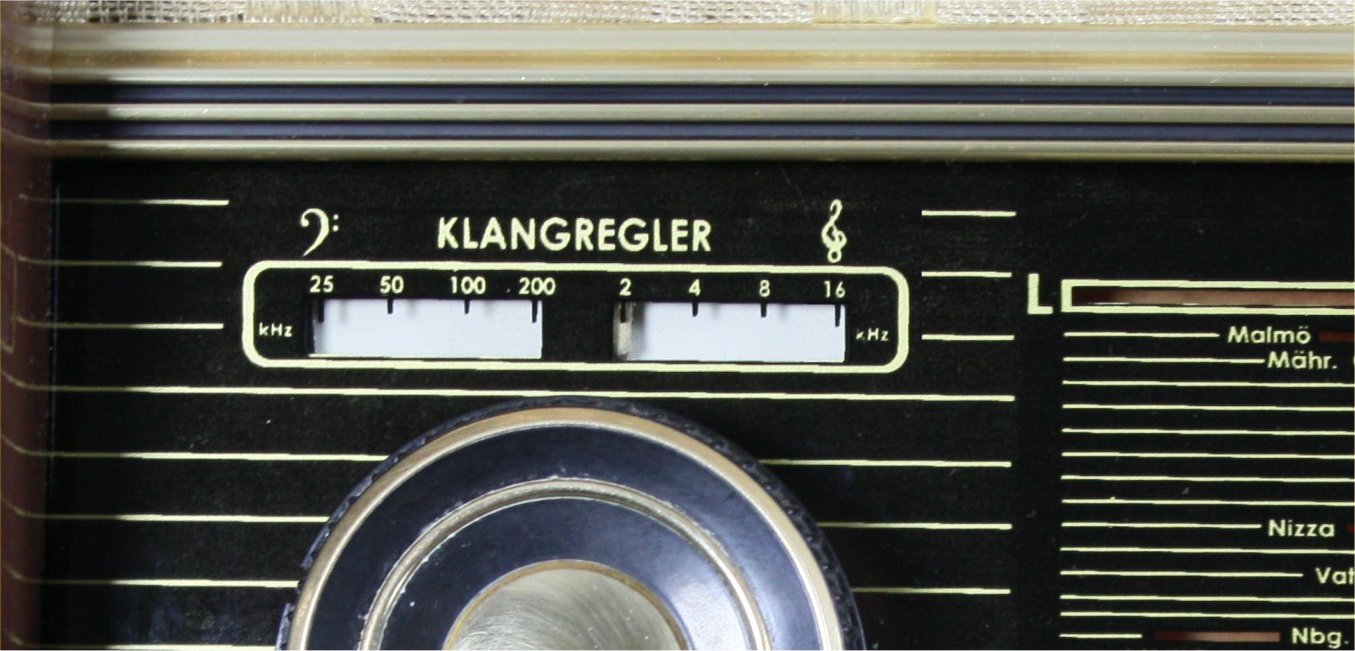
Bass at min - Treble at max

Bass flat - Treble flat
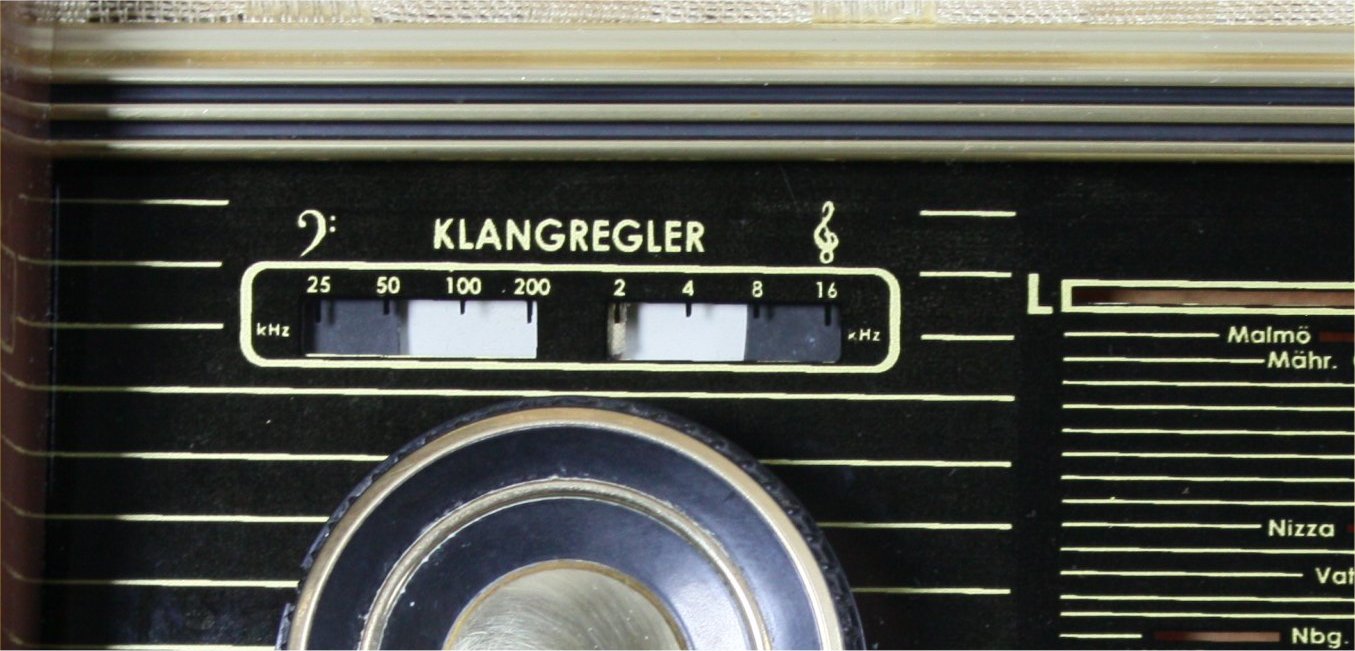
Bass at max - Treble at min

Bass at min - Treble at min

Inside the cabinet there is a dipole for FM reception and a ferrite rotating aerial for AM reception.
Ferrite aerial can be rotated from the outside to achieve a perfect tuning of the device in the AM.
In this picture see the rotation mechanism and the position indicator of the aerial.
The reception sensitivity with internal aerials is very good.
Using an external aerial sensitivity is further increased.
The magic eye has of course been replaced.

The 21 cm loudspeaker, with a 23 mm diameter magnetic core, is placed at the front.
A front 17 cm mid-tweeter can also be switched off if you want to increase the 3D effect.
On the two sides, there are two elliptical tweeters pointing upwards. Radiating to the ceiling of the room to take advantage of the reflections of the environment that add to the direct radiation produce an expansion of the soundstage.
There are no dangers of stationary wave due to the working frequency of these speakers.
There are several options for connecting external speakers.
It is, in fact, possible to connect an external woofer, excluding or not the internal woofer while leaving all the other speakers active.
It is possible to connect external medium-high units, excluding or not the internal mid-tweeters, while leaving the internal woofer active.
It is possible to connect woofers and external medium-high units, excluding or not all, or some, internal speakers.
In the center of the speaker panel is the Magic Eye which indicates the perfect tuning of each station.
KLANGREGLER - Low Tone Indicator (FA Key) and High Tone Indicator (SOL Key).
Just below we find the large Volume knob, with built-in automatic loudness correction.
FERROCEPTOR - Indicator of the position of the internal ferrite antenna. This internal antenna (excludable with the HA key) is used in the OM and OL bands. The internal antenna must be rotated until the best tuning is achieved.
Just below we find the large knob of the Manual Tuning, whose movement is very pleasant being supported by a large flywheel
Under the dials, we meet series of 6 keys.
Starting from the left the keys have the following functions:
AUS - Switch off
TA - Record player
LW - Long Waves
MW - Medium Waves
KW - Short Waves
UKW - FM
 german radios - en
german radios - en
Also this reviews will be accompanied by a section with graphs of technical measures of the most important parameters.
There is no such thing anywhere else, as far as I know. Not even the manufacturers themselves detailed the technical features of their own devices at this level.
This new section has been developed for an objective comparison of different devices.
In order to avoid interpreting the measurements incorrectly, it is very important to read the warnings carefully the first time.
The Korting Royal Syntektor 55W is the most prestigious model made by Leipzig's factory that year.
We already restored some Korting Royal Syntekor and while listening we were amazed by the unusual dynamic characteristics. Also the 55W proved itself up to expectations. The high volume listening of this device is extremely rewarding and often surprising. All this due to two elements: the transducers and a particular circuitry of the final stage.
The main (loud)speaker is a fabulous Isophon P23/25/105, with an AlNiCo magnet of 10500 Gauss and a linear response from 65 Hz to 10 kHz. It can withstand strong mechanical stresses and moreover it is fitted in a solidly built piece of forniture.
A 17 cm Medium adds brilliance on 900 – 1200 Hz range, the most important one to have a great experience while listening.
Not least the two big electrostatic tweeter, in plain view: their surface is very wide when compared with others usually placed on radios.
Moreover, let's talk about two little circuit's tricks: an oversize output transformer, making it very difficult to reach saturation and an unusual two power pentodes EL84's drivers.
As in the photo (9) the preamplifier stage is entrusted to a variable slope EF89 pentode that controls directly the first EL84 grid. Thereafter the signal is sent to the EABC80 triode's grid which dephases it of 180 degrees and then sends it to the second EL84. Such circuits allows a high control voltage of the two final valves which can reveal all their power.
Also the FM section is unusual: the detector stage is syncrhronous, thanks to this, distortion is very low. Besides, you can select two levels of circuit sensitivity to avoid the detector stage saturation.
Conclusions: just one, this device must be listened at high volumes to fully enjoy its largeness.
The Royal Syntektor 55W recondings are made to highlight its very notable dynamic characteristics. Anyway these recordings don't let us appraise the impact from listening at high/loud volume with this device. We get only a perception of its quality.

The first track is “I've been loving you too long” by Otis Redding, recorded in 1965, written with Jerry Butler and inspired by love problems Otis was going through at the time. At Monterey Festival in 1967 audience was thrilled by Jimi Hendrix, who set on fire his handpainted Stratocaster at the end of his exhibition and Otis Redding, the most charismatic voice of Soul music. Few months later, Otis and his bandmates will die in a plane crash at Lake Monona, Wisconsin. My favourite cover of the song is the one by Ike & Tina Turner.
The second track is one of Cesária Évora's masterpieces, “Isolada”, written in 2003, first track of the album "Voz d'amor". Cesária's smooth voice dives you into Cabo Verde's atmosphere and in Morna, a music genre typical of these islands in which the main instruments are violão and rabeca (guitar and violin). Rhythm is slow and the composition usually monotonous. The main composer was Eugénio de Paula Tavares. The archipelago was used as a headquarter for slave trade between Africa and America; after the abrogation of slavery in Portuguese Empire, recurring droguths and desertification, which led to famine and plagues, natives inhabitants were forced to leave. This social background gave birth to Morna.
The third track is from Tosca, “Vissi d'arte” by Giacomo Puccini – performed by Maria Callas, stage name of American-born Greek Anna Maria Cecilia Sophia Kalogeropoulos, one of the most renowned opera singers of all times. The Soprano has the highest vocal range of all female voice types, higher than Mezzosoprano and
Contralto, it requires a range of two octaves and a strong virtuosity, but Callas was a Coloratura soprano, she was able to perform roles as mezzosoprano, soprano leggero and soprano lirico. Not by chance she is still remembered as “La Divina”.
The fourth track is the catchy song by Eros Ramazzotti “Più bella cosa”. The song is dedicated to Michelle Hunziker, who he met at the time, but also (mainly) to Music, Eros' first true love that he will celebrate in many other songs. The lyrics there are clear references to memories and emotions (thrills) of his past rather than his love with Michelle.
The last track is one of Queen's most famous songs, “We will rock you”. Its history is really interesting: in a 1977 concert the band felt the crowd so engaged while singing along. They felt people had no room to dance and move freely, the only thing they could do was to clap hands, to stomp with feet and to sing. Hence “We will rock you” was born, a song about three ages of man: the child, the grown-up and the elderly.
Bluetooth receiver embed
Each radio is equipped with a cable for connection to any digital device.
- Bluetooth receiver embed - The unit is equipped with a BLUETOOTH receiver powered directly by the receiver power supply. This makes it possible to control the amplifier from any external digital device as an IPAD, a Smartphone, or a sophisticated multimedia station. So you can hear your preferred web station or your lossesless file without cables on the room. Wireless Receiver can be equipped upon requests.
- Multi Platform Connection - A customized adaptation cable to connect any digital device as Iphone, Smartphone, Laptop, CD Player etc. will be provided with this radio. This special cable suits the different impedances between the modern equipment and the receiver. Furthermore the two stereo channels flow into one without increasing the load to the input unit.


Körting-Radio-Werke Oswald Ritter was founded by Karl Oswald Max Ritter after leaving Dietz & Ritter GmbH in 1940.
At they beginning it produced radio receivers, transformers and electronic devices.
Körting branded radio receivers have great success thanks to their high-quality.
After World War II, the company ventures with Carl Zeiss but in 1946 productions volumes drop due to the company's decommissioning.
In 1948 it is seized and transferred to public property and managed by VEB Radio and Telecommunications Technology.
In 1949 Ritter moves to Upper Bavaria with some of his employees and in 1951, with a 5 millions DM lended by Bayerische Staatsbank, he acquires Belwe GmbH in Grassau, a producer of flatirons, toasters and little lamps, expanding the production to radios, speakers and electro-medical devices.
Körting's sales in West Germany are low compared to its competitors and the internal bank orders Gerhard Böhme to reorganize the company at the beginning of 1953. Oswald Ritter resigns as an associate in the summer of 1953 and Böhme becomes the company's manager.
In 1955 Ritter definitively leaves the company and dies on October 2nd, 1959 after a long illness.
The company agrees a deal with Neckermann, an important mail-order company in Frankfurt. Neckermann nuys and sells all the televisions and radios with the brand Neckermann-Körting.
In 1957, Körting laucnhes the Dynamic 830W, the first radio in the world with dynamics expander.
From 1952 to 1964 sales are 7-times higher.
In 1963 and in 1964, Körting has to increase its capabilities due to increased sales. In quick succession the company opens new branches in Grödig, near Salzburg, Möbelwerke Wallerstein and Körting-Italiana in Pavia. In this period Körting produces devices for Kuba-Imperial , Elac , Blaupunkt and Siemens.
In 1970, Körting makes a deal with Yugoslavian Gorenje to build televisions in their headquarters in Slovenia.
In 1972 Kuba ceases production, followed by Elac in 1978, and Karstadt takes over Neckermann, interrupting the cooperation with Körting.
In 1978 Körting filed for bankruptcy , on September 1st 1978 Gorenje acquires the main factory in Grassau, but at the end of March 1983 also Gorenje Körting Electronic goes bankrupt.
Year of production: 1954/55
Superheterodyne IF: 472/10700
11 AM Circuits - 15 FM Circuits
Wavebands:
Medium Waves(MW1, MW22), Long Waves (LW)
Short waves (KW1,KW2), FM (UKW)
Loudspeakers:
1 woofer da 9"
1 wideband da 7"
2 electrostatic tweeters
Dimensions (LHD): 705 x 450 x 340 mm / 27.8 x 17.7 x 13.4 inch
Net weight: 21 kg / 46 lb 4.1 oz
11 Tubes:ECC85 2xEF89 EC92 EBF80 EM85 ECH81 EABC80 2xEL84 AZ11

BANDWIDTH
ation caused by the loudspeakers' inductive load and the effect of the mechanical resonance of the speakers themselves on the feedback circuit are not considered. The effects are by no means negligible, the measurements carried out on a purely resistive load are
always very linear but they don't coincide with the real frequency response.
On the other hand, this response curve was measured on an inductive laod, that is, with its own loudspeakers.
The frequency response measurements were made with a sinusoidal generator and a Wandel & Goltermann WM – 20 level meter.
You can see the actual frequency response on the vobulator' screen.
RMS POWER
We consider as Maximum Power the square of the lower of the RMS voltages measured at the three sample frequencies divided by the load resistence.
The measurement conditions are the following:
- sample frequencies, 100, 1000, 10,000 Hz
- 8 ohm resistive load
- distortion less than or equal to 1%.
The measuring instrument provides the RMS value directly.
The measured RMS power is 7.4 W
INTERMODULATION DISTORTION %
The Intermodulation Distortion % was measured with the SMPTE standard and measured at 1W RMS.
The two measurements were carried out by modulating the 50 Hz sine wave with a 1080 Hz sine wave and then with a 10400 Hz sine wave, with an amplitude in a ratio of 1/4 compared to the basic sinusoid.
The output voltage was kept around 2.83V on an 8 ohm carico.
The measured Intermodulation Distortion % (IM%) is 0.14%
The radio's loudspeakers are one of the most interesting and distintive features.
The first, as well as the biggest one, is an electromagnetic Isophon P23/25/105; its diameter is about 22 cm and with a 10500 Gauss magnet has a frequency response that goes from 65 to 10.000 Hz within +/- 3 dB.
The whole frequency range is sent to this loudspeaker and the upper part is cut mechanically.
The basses are always ready and extremely powerful. As anticipated power and dynamism are the main feature of this device.
The second loudspeaker is a 17 cm diameter broadband, with a medium cone's incline, very fast and which extens very high for a brilliant playing of mid-range sounds.
The speaker is connected to an intermediate socket of the output transformer and the latter (the last one) acts as a filter and a power redicer at the speaker ends.
Finally, we talk about the excellent electrostatic tweeter, very large and efficient with a convex front surface that increases the diffusion area.
A really well thought speakers' set, wisely implemented regardless of the price.
The tones control system is very efficient. Above the large tone control knobs there is a band that lights up gradually indicating the emphasis on the band on which it acts.
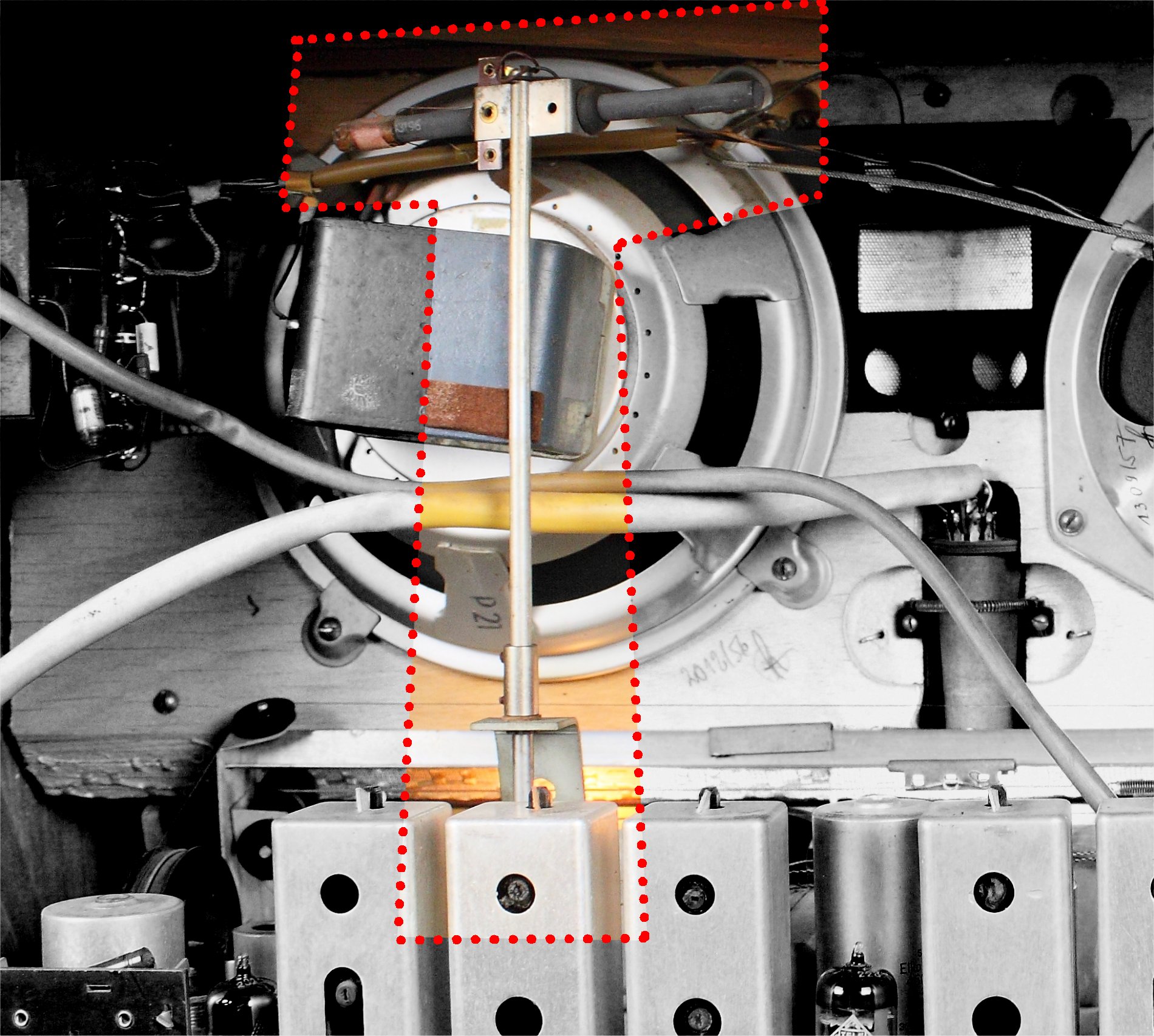
Inside the cabinet there is a dipole for FM reception and a ferrite rotating aerial for AM reception.
Ferrite aerial can be rotated from the outside to achieve a perfect tuning of the device in the AM.
In this picture you can see the rotation mechanism, and the aerial position indicator.
The reception sensitivity with internal aerials is very good. This unit was in fact produced when there were not many radio stations, and those available were far from each other.
Using an external aerial sensitivity is further increased.


The magic eye has of course been replaced.
1 - Volume control (with loudness built-in) - Anodic high / low voltage switch
2 - Rotation command of the ferrite antenna
3 - Indicator of the ferrite antenna position
4 - Indicator of the bass control position
5 - The bass control knob
6 - AM Band gain switch
7 - Keyboard
AUS - OFF
TA - Aux
L - Long waves
M Normal - Medium Waves/Ext. Antenna
M Ferrit - Medium Waves/Int. Antenna
KI - Short Waves 1
KII - Short Waves 2
UK - FM
8 - Display
9 - Tuning knob FM
10 - Tuning knob AM
11 - Indicator of the position of the high tone control
12 - Treble control knob.
13 - FM gain switch

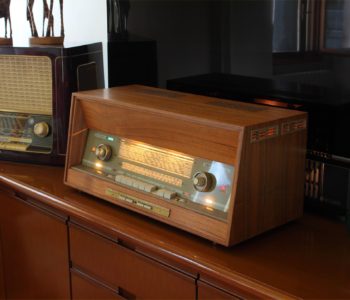 freiburg studio - en
freiburg studio - en
The Saba Freiburg Studio is almost identical to the Freiburg 14 and Freiburg Studio A.
The latter has a different design of the dialglass and the stereo decoder mounted standard, with its indicator on front.
The Saba Freiburg Studio is however ready for mounting a stereo decoder, so just insert it in the special socket after removing the plug.
The description is therefore the same as the Freiburg 14 model that has been previously reviewed.
The Saba Freiburg Studio are the highest expression of German production with regard to tube receivers equipped with automatic search.
No German receiver can give more, and none contains all the features and performances that Freiburg Studio have.
Electronically, it is the same machine used in the Saba Freiburg 14 or Saba STudio A, so refer to this page for the technical description, but the flexibility is very different.
In this description I will focus precisely on this versatility.
- The first advantage is that being without speakers the cabinet is much more compact, and this allows you to position it in the environment with much more ease.
- The second advantage is that is possible to pair the device with the most suitable speakers and position the speakers in the most appropriate way for ideal listening.
These possibilities offered by receivers, including the Saba Freiburg Studio, are extremely important. If well used they can radically change the sound of a system.

Bluetooth receiver embed
Each radio is equipped with a cable for connection to any digital device.
- Bluetooth receiver embed – The unit is equipped with a BLUETOOTH receiver powered directly by the receiver power supply. This makes it possible to control the amplifier from any external digital device as an IPAD, a Smartphone, or a sophisticated multimedia station. So you can hear your preferred web station or your lossesless file without cables on the room. Wireless Receiver can be equipped upon requests.
– Multi Platform Connection – A customized adaptation cable to connect any digital device as Iphone, Smartphone, Laptop, CD Player etc. will be provided with this radio. This special cable suits the different impedances between the modern equipment and the receiver. Furthermore the two stereo channels flow into one without increasing the load to the input unit.
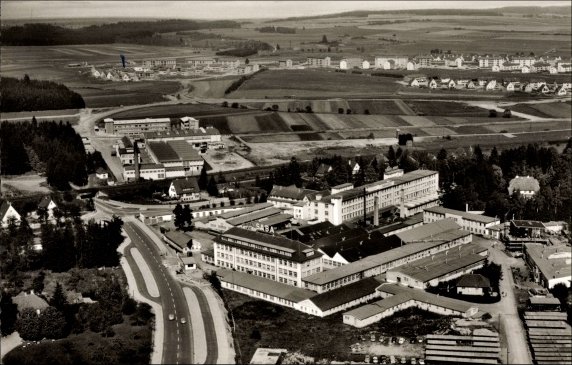

SABA is the acronym for Schawarzwälder-Apparate-Bau-Anstalt meaning engineering institute of Technological appliances of the Black Forest.
The company was founded back in 1835 by Joseph Benedikt with the initial name of Jockele-Uhren, but only in 1923 the production of radio devices began and the company went under the name of SABA.
Toward the end of the 20s SABA became famous with the well-known S35 and in the following years it became the second German producer after Telefunken. During the war SABA produced military equipment and in 1945 the company was completely destroyed by a bombing.
In 1947 the production of radio devices began again and SABA distinguished itself immediately for ist avant-garde and high- quality production.
hey also began to produce TVs (the first PAL color TV is a SABA), house appliances and medical equipment. Many Italians used to work there. The Alnico Greencone loudspeakers became popular for their linearity, power handling, constant impendence that would be employed in each Hi-Fi devices of that time.
The radio devices with motorized tuning became popular as well and SABA became the representative German brand meaning quality, reliability and detailed precision. In the 1970s the decline began. According to specialized magazines of that time not having a Japanese device at that time meant not having Hi-Fi. In the 80s Thompson took over SABA. In the 90s the other way around, having a Japanese device of the 70s meant not having Hi-Fi. They found out that they functioned with a 96% counterreaction and that a device with 0.001 db from 1 to 100 KHz extension did not necessarily sound good.
We do not trust our ears and we do trust what other people say not necessarily with a good purpose.
2007: due to insolvency SABA disappeared from the TLC (Chinese) and Thompson (French) joint venture, and SABA ceased to exist.
Year of production: 1963-64
10 AM Circuits
13 FM Circuits
Wavebands: Medium Waves (OM), Long Waves (OL), Short waves (OC), FM (UKW)
5 Greencone loudspeakers:
2 x 10" Alnico woofers
2 x 8" Alnico mid/woofers
1 Elliptical tweeter
Dimensions (LHD):: 27,6 x 17.9 x 12.2 inch
Net weight: 53.6 lb
14 Tubes: EC92 EC92 ECH81 EF89 EM87 EBF89 EF86 EF86 ECC83 ELL80 ELL80 EM84 EABC80 ECL80
Ferrite rotating aerial
Automatic tuning research
Optional remote control
FM stereo decoder arrangement


Rotating ferrite curve with lightened window indicating its position.
The ferrite curve can be rotated through a big knob which is coaxial to the volume knob. Inside the piece of furniture there is a dipole for the FM reception and a directable ferrite curve for the AM reception.
The device is equipped with separated tuning mechanisms for AM and FM bands and for each of the FM bands.
There is only one tuning knob but the selector changes on a cable and pulley system that are separated according to the band.
Worth noticing is the accuracy and the complexity of the motorized FM group.


The magic eye indicating the tuning of each station is new.
The tuning system is a masterwork.
It is a motor with windings supplied in a phase shifted by some capacitors. It permit to change the motor rotation direction of according to whether the search is in one sense or another.
The tuning is centered by drawing part of the signal from the CAC circuit and by using a relais controlled by a tube.
As already mentioned, calibration is rather complex and it cannot be put into practice without referring to SABA’s original manuals.
Below a detail of the engine and the scheme section to control the automatism.


Another interesting feature is the volume control.
The knob does not automatically control the volume potentiometer. It controls through an unknot push-back.
The motorized remote control has a slight friction effect which strengthens the resistance when you turn the knob.
The first small window that can be seen on the left side indicates whether the ferrite curve is inserted and its position.
On the left side you can also find the volume control (with incorporated loudness) and the ferrite curve rotation control.
Right above the volume control there is a magic eye indicating the perfect tuning of each station.
Below you can see the Mono/Stereo indicator and further below the bass control knob.
The AM bands with Short, Medium and Long Waves and the FM displays.
Starting from the lefthand corner you can see the Musik/Sprache, Stereo/Mono, AUX input buttons, the band switch buttons, the Long, medium, short waves and FM switch buttons and the motorized tuning system (Automatik) button.
Lastly the ON/OFF button.
Next to it the acutes control knob is to be found.
The Musik/Sprache equalizer indicator.
On the right, the tuning knob, which is supported by a big fly-wheel that renders its movement really pleasant.
The automatic tuning functioning indicator is to be found on the right as well.
Below two buttons for the automatic tuning functioning. Each button activates the automatic tuning mechanism in one or the other direction. By pushing one of those buttons the engine constantly activates the tuning indicator for a fast reposition.

Output for external speakers.
Socket for recorder (tonbandgerat).
Turntable input (Tonabnehmer)
AM and FM aerial inputs and ground socket.
Remote control inputs
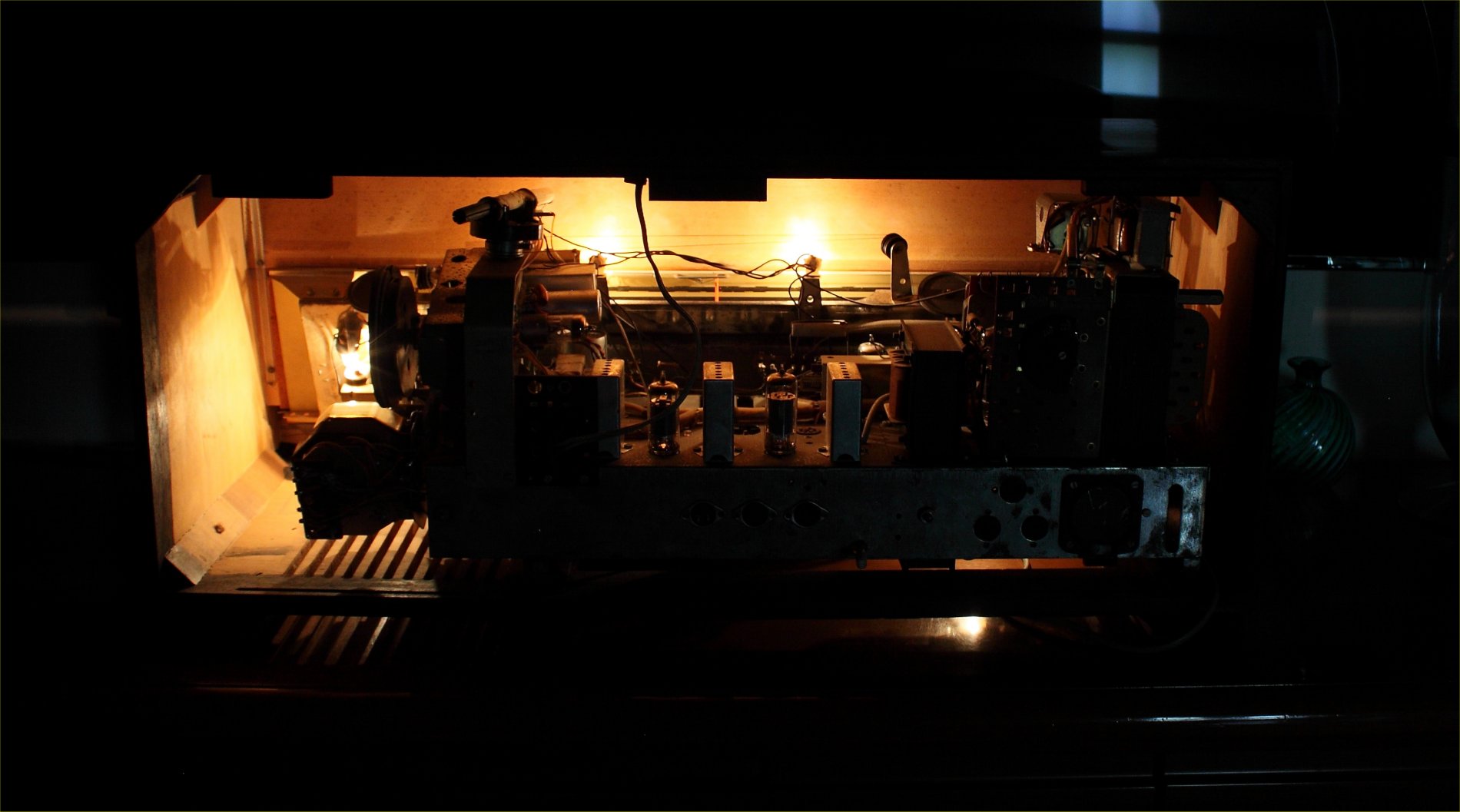
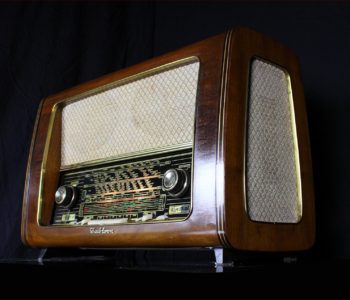 german radios - en
german radios - en
SCHAUB LORENZ GOLDSUPER W42
Come ho scritto in altre recensioni le Schaub-Lorenz si riconoscono alla prima occhiata.
In Schaub gli sforzi dei designer e dei progettisti era orientata all'eleganza degli apparecchi.
La Schaub Lorenz Goldsuper W42 infatti ha una linea snella ed elegante. Le superfici sono mosse, le venature del legno sono simmetriche e scelte con cura.
I fregi, gli ottoni, le tele, sono tutti elementi scelti con gusto per dare un senso di ricercatezza e di classe.
Il colpo d'occhio è quello di un profilo classico ma leggero, ma l'ascolto rivela tutt'altra personalità.
La Goldsuper W42 è il modello top della casa nel 1957.
Uno stadio finale in Push-Pull composto da due Triodo-Pentodo ECL82. Una potenza d'uscita misurata di 6,6 W RMS, superiore a quella dichiarata cautelativamente dalla casa costruttrice.
Due grandi altoparlanti a larga banda anteriori e due tweeter elettrostatici laterali per una potenza di fuoco insospettabile.
Il suono è come di consueto molto morbido, con bei bassi caldi e piacevoli.
La risposta in frequenza è accentuata sulle basse frequenze. Per avere una risposta lineare su tutta la banda il mio consiglio è quello di tenere premuto il tasto Hohen, che esalta la risposta nella parte alta della banda. Questa indicazione è valida soprattutto nell'ascolto di brani, non compressi, da ingresso Bluetooth. In tal modo si potranno realmente apprezzare le caratteristiche di brillantezza dei tweeter elettrostatici e la leggerezza dei coni frontali.
La manopola di sintonia è molto piacevole da utilizzare per via del particolare sistema, a puleggia, di trasmissione del movimento.
I tasti sono morbidi e dall'azionamento sicuro e senza inceppamenti.
La sezione sintonizzatore è stabile ed esente da disturbi.
La scala parlante colorata è molto leggibile, grande ed appariscente, altra caratteristica delle Schaub-Lorenz.
Karl Daniel Lorenz, il padre di Carl Lorenz, era un musicista e compositore di musica da camera.
Per questo il test di questo apparecchio verrà fatto eseguendo brani di questo genere musicale.
La musica da camera comprende qualsiasi tipo di musica scritto per un complesso limitato di esecutori. A seconda del numero degli esecutori a cui è destinata prende il nome di DUO, TRIO, ecc.
La musica da camera strumentale, viene chiamata SONATA, mentre quella vocale viene detta CANTATA. Nella scaletta sono state previste sia Sonate che Cantate.

Cominciamo con la più classica delle sonatine, il primo brano è la Piano Sonata No.16 in C major, K.545 di W.A.Mozart.
In particolare ascoltiamo il primo movimento, l'Allegro. Pubblicata postuma grazie ad una stampa del compositore ed editore J.A. André fu considerata da Mozart una sonata per principianti. Probabilmente deve la sua fama alla semplicità richiesta nell'esecuzione. Essendo molto conosciuta ci permette una facile confronto.
Il secondo brano è una bella incisione del 1999 della Decca. Si tratta della Salve Regina in F minor tratta dallo Stabat Mater di G.B.Pergolesi. Nato a Jesi nel 1710 e morto a soli 26 anni di tubercolosi. Il Pergolesi nutriva una grande venerazione per la Madonna, e lo Stabat Mater fu terminato, con grande tenacia dall'autore proprio pochi giorni prima della sua morte. Lo Stabat Mater, attribuito a Jacopone da Todi, è l'apertura del componimento poetico, inizialmente recitato e poi cantato, nelle celebrazione dedicate alla Vergine Addolorata. La trascrizione del Pergolesi è particolarmente toccante considerando anche il contesto di sofferenza derivante dalla malattia, in cui fu scritta.
Il terzo brano è un recitativo di F.Mendelssohn , il cui titolo è "Da Jesu geboren ward". E' tratto da un compact disk prodotto dell'encomiabile associazione francese Mécénat Musical Société Générale, fondazione dell'omonimo gruppo bancario francese. Il recitativo inizia con "Da Jesus geboren ward zu Bethlehem im jüdischen Lande" che è l'incipit del Vangelo di Matteo 2,1 nella trascrizione di Martin Lutero. L'intero Oratorio è di provenienza Protestante, questo rende l'incisione storicamente molto interessante.
Il quarto brano è di César Franck - Sonata in La maggiore per Violino e Pianoforte. Una curiosità su questa sonata merita di essere conosciuta. Questa sonata fu il regalo di nozze di Franck all'amico e virtuoso belga Eugène Ysaÿe. La prima esecuzione avvenne nel Museo d'Arte Moderna di Bruxelles e programmata per essere eseguita nel pomeriggio. Il regolamento della galleria però stabilisce che non vi debba essere alcun tipo di illuminazione artificiale nelle sale. Alla fine del primo movimento, essendo ormai buio, i presenti vennero invitati ad andarsene dal personale. Ma gli spettatori rifiutarono ed Ysaÿe e la pianista continuarono ad eseguire la Sonata al buio, a memoria, emozionando gli ascoltatori. Arte è anche questo.
L'ultimo brano è il BB115, I. Assai lento - Allegro troppo dalla Sonata for Two Pianos and Percussion di Béla Bartók. Questo brano, pur conservando al forma sonata rappresenta una decisa rottura rispetto ai pezzi proposti in precedenza. Nel primo movimento la struttura ritmica viene enunciata, poi viene modificata per poi essere riproposta. E' una forma abbastanza complessa, anche da ascoltare. La Sonata di Bartok è una delle ultime e più mature opere del compositore. In una delle prossime recensioni invece verrà proposto un pezzo de "Il mandarino meraviglioso", l'opera più tormentata, scandalosa ed ardita del compositore Ungherese.
Bluetooth receiver embed
Each radio is equipped with a cable for connection to any digital device.
- Bluetooth receiver embed - The unit is equipped with a BLUETOOTH receiver powered directly by the receiver power supply. This makes it possible to control the amplifier from any external digital device as an IPAD, a Smartphone, or a sophisticated multimedia station. So you can hear your preferred web station or your lossesless file without cables on the room. Wireless Receiver can be equipped upon requests.
– Multi Platform Connection – A customized adaptation cable to connect any digital device as Iphone, Smartphone, Laptop, CD Player etc. will be provided with this radio. This special cable suits the different impedances between the modern equipment and the receiver. Furthermore the two stereo channels flow into one without increasing the load to the input unit.

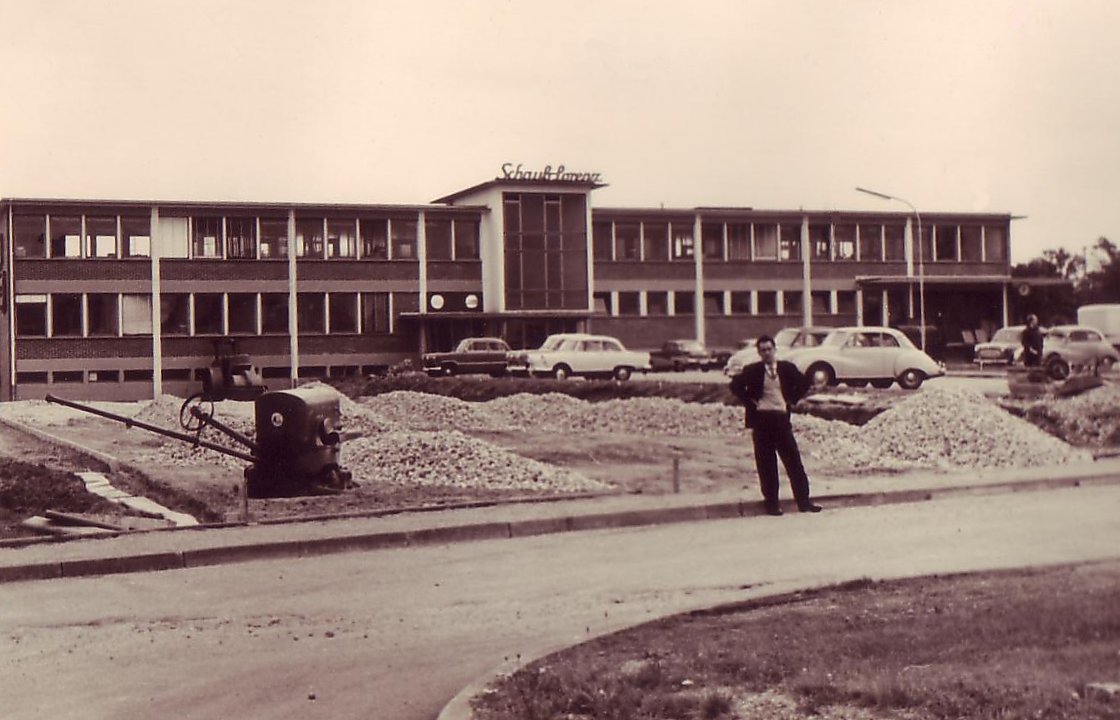
In 1870, Carl Lorenz (1844-1889) opens a lightning hardware shop in Berlin.
After his death, the company is acquired by textile entrepreneur Robert Held (1862-1924).
Carl's brother, Alfred Lorenz, is appointed as technical director. Under Held, the company became an important supplier of telegraphy equipment.
The company expands in the telephone industry buying Lewart and it becomes the telephone provider for postal service.
In 1906, the company is registered for public commerce as C. Lorenz AG.
At the beginning of World War I, Lorenz had reached the number of 3.000 employees and was an important provider of telephone and telegraphy equipment for the German army.
At the end of the First War, the size of the company decreases considerably and activities are oriented to the production of household radios and aeronautical communications devices.
In the 1920's, the company is the main competitor of Telefunken.
In 1930, it is under the control of Standard Elektrizitätsgesellschaft, a branch of American society ITT.
Lorenz patented the ferrite aerial in 1935, which has been used since then in most domestic receivers.
While Germany was preparing for another War, Lorenz went back to the production of material for the army.
In 1940, he aquires G. Schaub Apparatebau-Gesellschaft; its many factories were mainly used for low-cost production.
Lorenz's military products during World War II included land and air radars, radios, recorders, radio tubes and the safest communication device in Germany, Lorenz's machine and code.
Lorenz owned the 25% of Focke-Wulf, the German aeronautical company that built some of the most successful Luftwaffe fighter jets.
In the midst of the War, Lorenz had about 24.000 workers in 12 operating structures.
In 1948, Lorenz has to start over.
Some factories had been shut down and those in the eastern part had been transferred or transferred to the Soviet Union.
During the 1950's, Lorenz recovers very quickly. In 1954, the name of the broadcasting devices brand is changed to Schaub-Lorenz.
In 1958, C. Lorenz AG ceased to exist as an independent company. ITT reorganizes its activities in Germany by merging Lorenz, Standard Elektrizitätsgesellschaft and many more into a new society, named Standard Elektrik Lorenz (or SEL).
In 1961, the company also becomes the main shareholder of Graetz.
In 1987, it is incorporated by the French company Alcatel.
In 2016, Alcatel is bought by Nokia.

Year of production: 1956/57
Superheterodyne IF 468/10700
8 AM Circuits
11 FM Circuits
Wavebands: Medium Waves (OM), Long Waves (OL),Short waves (OC), FM (UKW)
Loudspeakers:
2 main wideband loudspeakers in front
2 Electrostatic Tweeters on sides
Dimensions (LHD):640 x 400 x 270 mm / 25.2 x 15.7 x 10.6 inch
Net weight: 13 kg / 28 lb 10.1 oz
8 Tubes: ECC85 ECH81 EF93 EABC80 EM80 2xECL82 EZ80
LW and MW rotating ferrite antenna embed

BANDA PASSANTE
La Curva della risposta in frequenza è stata rilevata su carico resistivo misurando la tensione efficace alle diverse frequenze e convertendo i risultati in DB
La linea ROSSA indica la banda passante con i potenziometri di tono in posizione di massima esaltazione
La linea BLU indica la banda passante con i potenziometri di tono in posizione lineare.
La banda passante è stata misurata su carico resistivo. Non tiene conto quindi delle deformazioni derivanti dal carico induttivo degli altoparlanti e della risposta meccanica degli stessi.
POTENZA RMS
Consideriamo come Potenza Massima il quadrato della minore tra le tensioni RMS misurate alle tre frequenze campione diviso la resistenza di carico.
Le condizioni di misura sono le seguenti:
- frequenze campione, 100, 1000, 10.000 Hz
- carico resistivo di 4 ohm
- distorsione minore o uguale a 1%.
Lo strumento di misura fornisce direttamente il valore RMS.
La potenza RMS misurata è di 6,6 W
DISTORSIONE DI INTERMODULAZIONE %
La Distorsione di Intermodulazione è stata misurata con lo standard SMPTE e potenza di erogazione misurata di 1W RMS.
Le due misure sono state eseguite modulando l'onda sinusoidale base di 50 Hz con una sinusoide a 5400 Hz, con una ampiezza in rapporto di 1/4 rispetto alla sinusoide di base.
La tensione di uscita è stata mantenuta intorno ai 2,00V su un carico di 4 ohm.
La Distorsione di Intermodulazione (IM%) misurata è di 0,6%
A puro scopo didattico qui di seguito si vede l'effetto di un incremento eccessivo del segnale di ingresso sulla distorsione. La deformazione della forma d'onda in uscita è evidente. Le valvole finali lavorano in zona di non linearità, saturando e producendo una grande quantità di armoniche (nei punti indicati nelle foto).
The frequency response correction system is made of 4 keys that insert preset equalization curves operating on the feedback circuit, they are not passive filters.
The Basse key emphasizes the bass.
The Sprache key emphasizes the mids for a cleaner listening to broadcasts spoken.
The Hohen key emphasizes the treble.
The 3D/1D excludes the side speakers.

The tones control system is very efficient.
Above the large tone control knobs there is a band that lights up gradually indicating the emphasis on the band on which it acts.
Max Bass

Flat Bass

Min Bass

Max Treble

Flat Treble

Min Treble

Inside the cabinet there is a dipole for FM reception and a rotating ferrite antenna for AM reception.
The reception sensitivity with internal antennas is very good.
Using an external aerial sensitivity is further increased.

The tuning system is another gem.
The unit is equipped with mechanisms for keeping separate the AM and FM bands.
The tuning knob is single but a selector switch commutes into cable systems (all in steel) and pulleys separated depending on the band.
The movement is transferred to both mechanisms with a system of pulleys and separated gears.
The magic eye has of course been replaced.
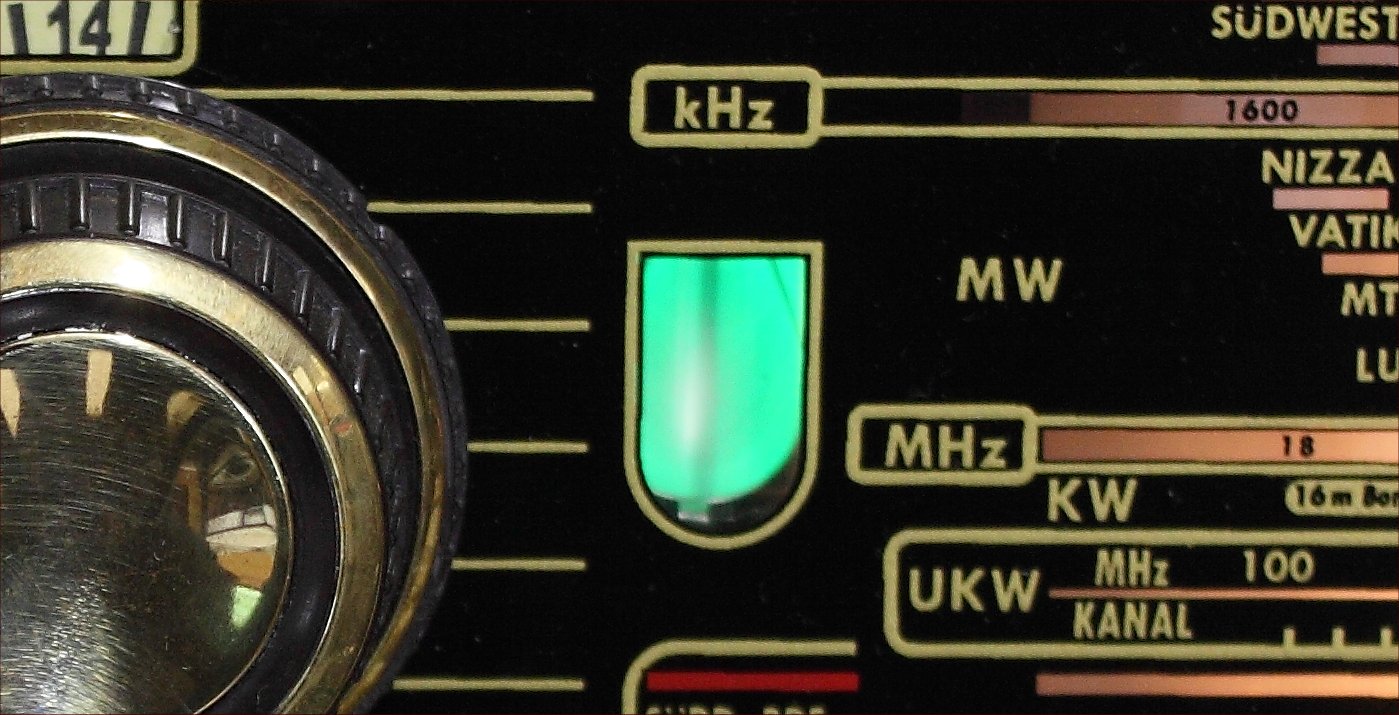
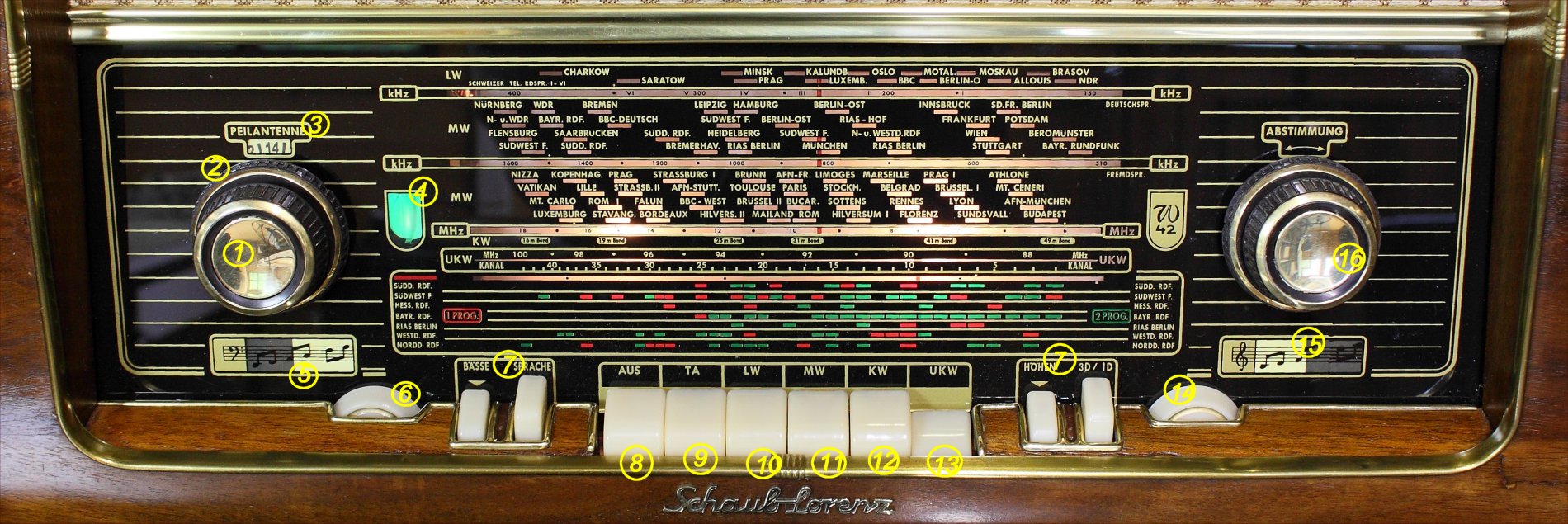
1 - Volume control, with loudness integrated.
2 - Ferrite Antenna rotating control
3 - Ferrite Antenna position indicator
4 - Magical eye indicating the perfect tuning of each station
5 - Bass indicator
6 - Bass control
7 - Bandbreite Schaltbar
8 - OFF
9 - Auxiliary input
10 - Long Wave
11 - Medium Wave
12 - Short Wave
13 - FM
14 - Treble control
15 - Treble indicator
16 - Tuning
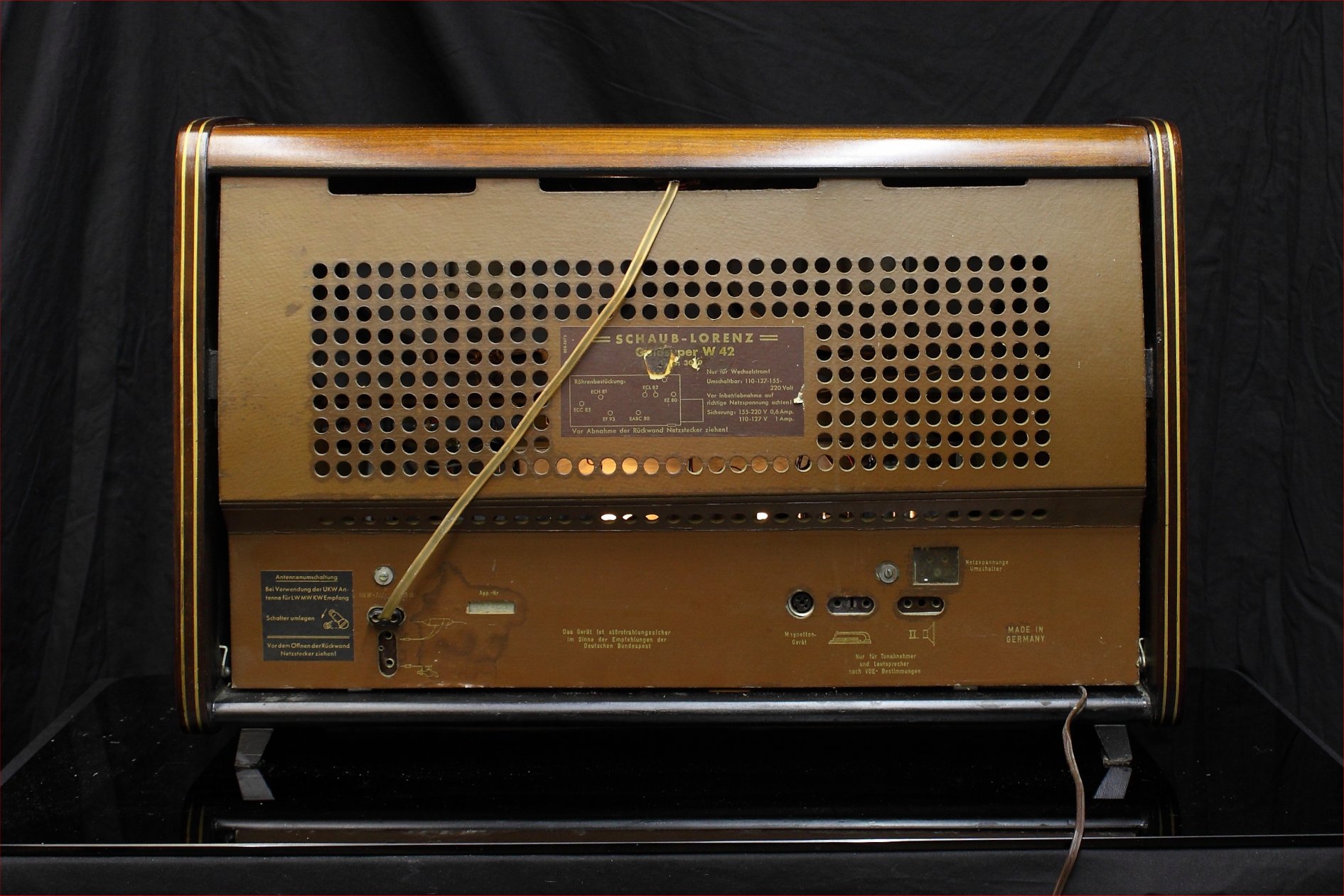
Output for external speakers.
Socket for recorder (tonbandgerat).
Turntable input (Tonabnehmer)
AM and FM aerial inputs and ground socket.
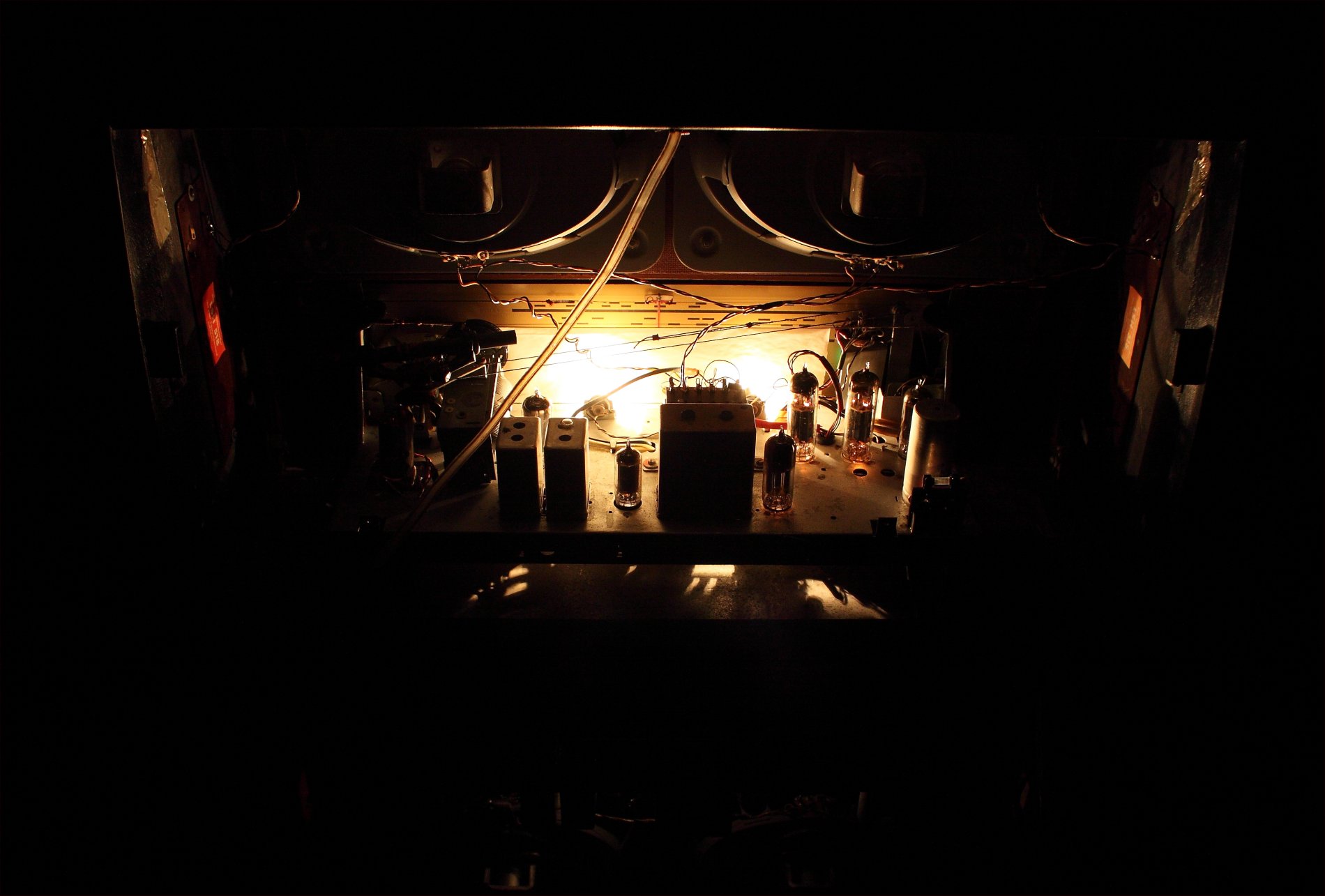
 162w - en
162w - en



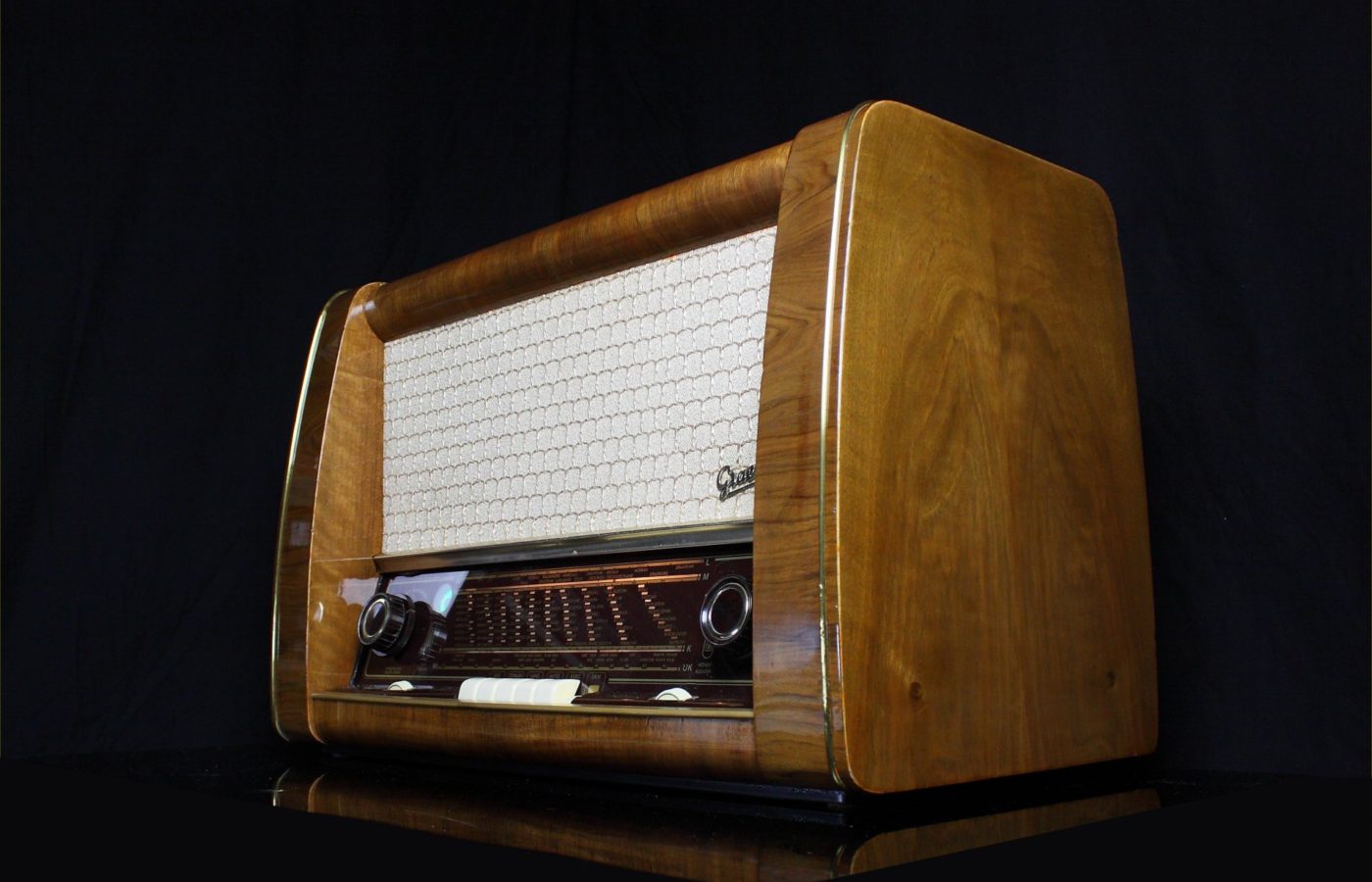


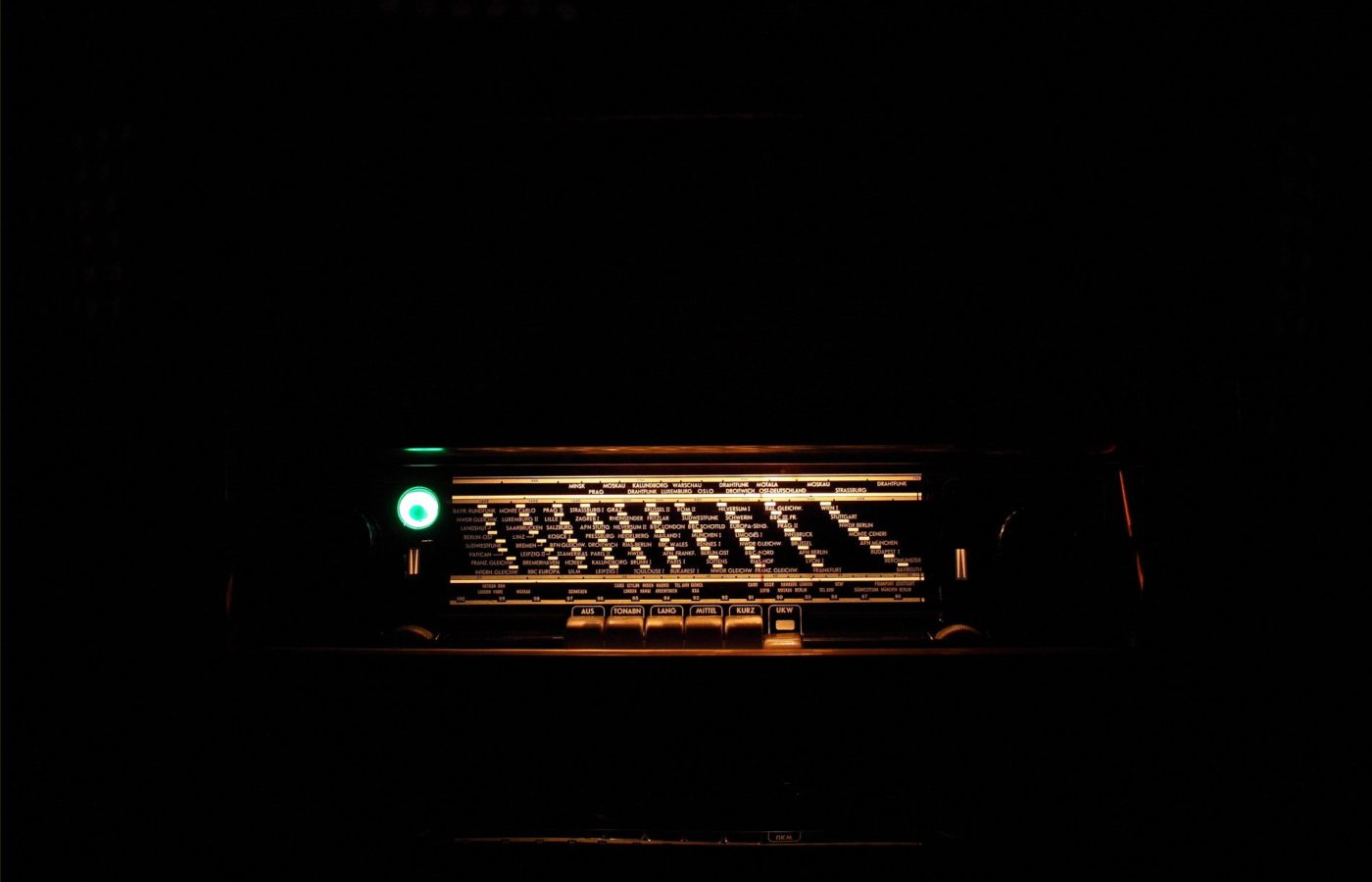
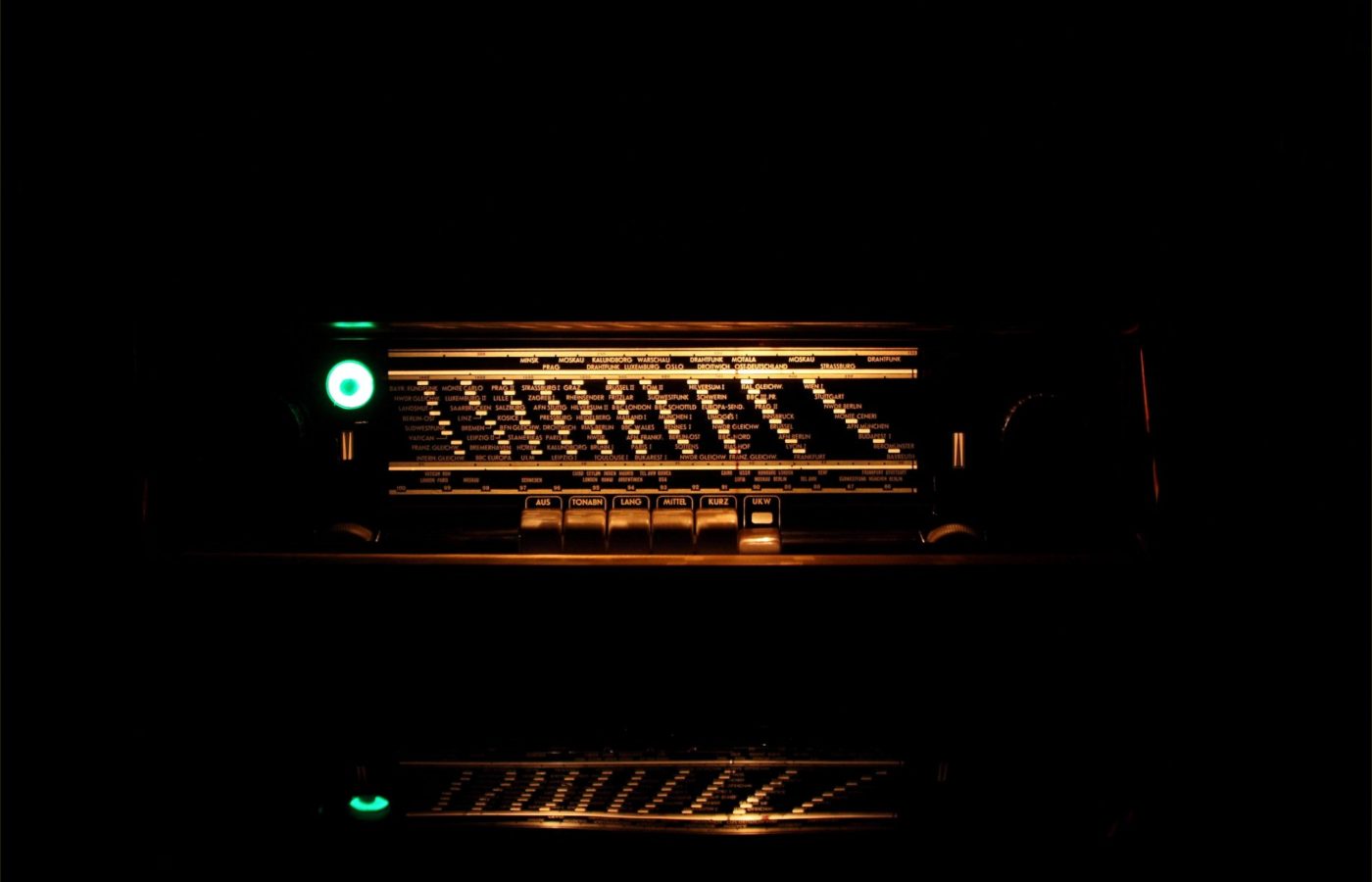




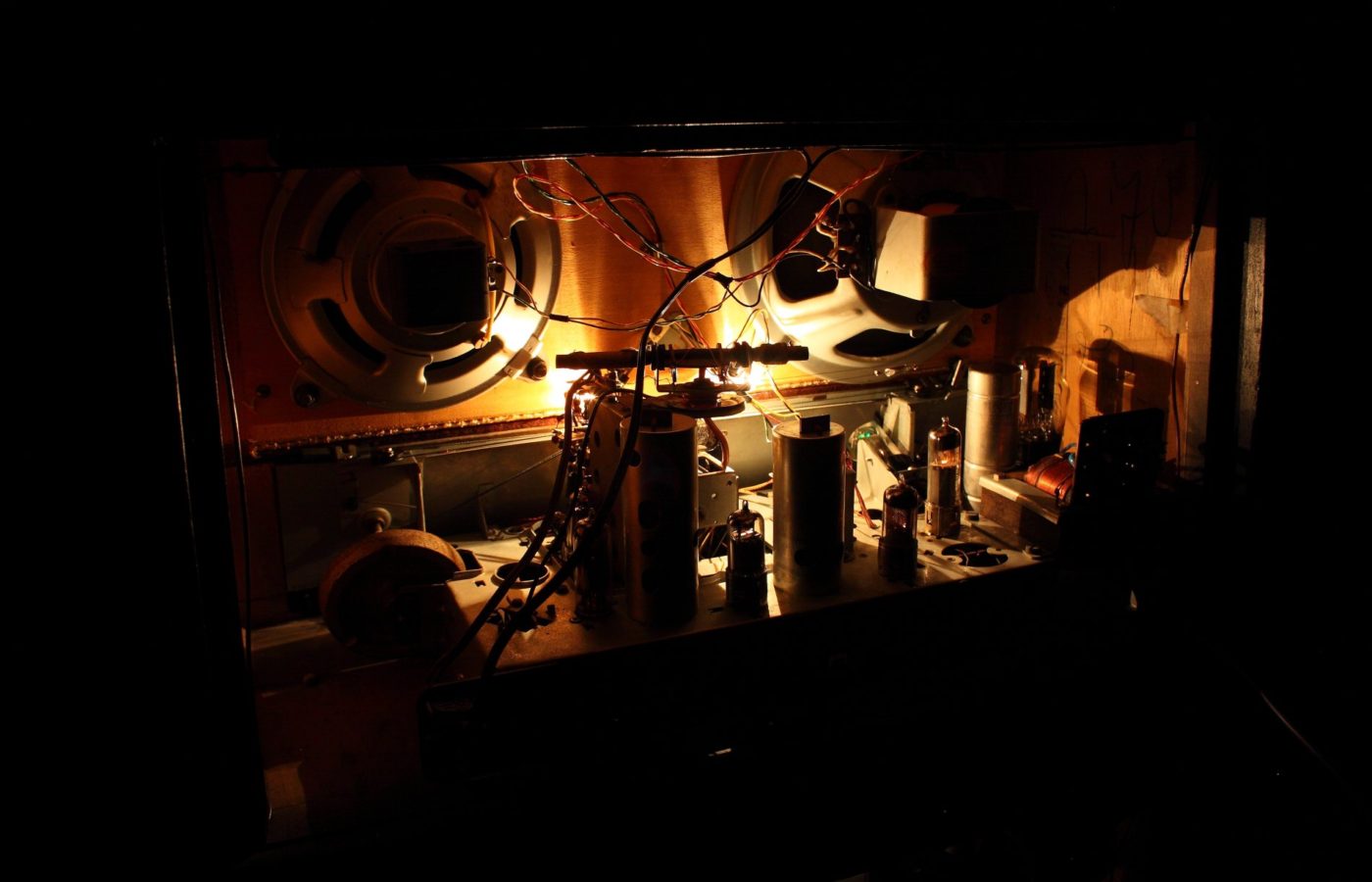

The review of the Graetz 162W is different from all the reviews ever published.
Starting from this one, the reviews will be accompanied by a section with graphs of technical measures of the most important parameters.
There is no such thing anywhere else, as far as I know. Not even the manufacturers themselves detailed the technical features of their own devices at this level.
This new section has been developed for an objective comparison of different devices.
In order to avoid interpreting the measurements incorrectly, it is very important to read the warnings carefully the first time.
When it was decided to restore and test the Graetz 162W, expectations were quite high. Actually, the 162W differs from the 163W, top model of the Graetz production in 1952, only for the output tube, one of the two speakers and some other minor details. Moreover, both of these devices have very interesting circuit choices which provide them with a very peculiar sound.
First of all, they are both equipped with an electromagnetic coil loudspeaker and a permanent magnet loudspeaker. The permanent magnet loudspeaker, with a smaller diameter, has a greater extension towards medium and high frequencies. The electromagnetic coil loudspeaker has a considerable extension towards the medium-low frequencies. The two speakers are connected in series, there is no a crossover network between the two, the separation of frequencies is entrusted to the mechanical characteristics of the speakers themselves. Both of them will be examined in detail in the specific section.
The FM section is also very peculiar. The HF section is entrusted to an EF80 Variable transconductance . The same tube is used simultaneously as a audio preamplifier. In the diagram here, the HF circuit is highlighted in blue and the audio stage one, instead, is highlighted in red.
The Audio Section is entrusted to a EL41 pentode EL41 working in A Class.
The Volume potentiometer is equipped with a loudness pinout. It is known, in fact, that when listening at very low volume, the low and acute notes are not perceived with the same sound intensity as the medium notes, which clearly prevail.
The loudnes circuit changes the curve response of the preamp section specularly to the Fletcher–Munson curve. This allows to keep the perception of the extreme sounds of the audible audio spectrum constant even at low volume levels. The Tone Control, separate bass and treble, is inserted in the feedback network.
Conclusions: a warm and mellow sound was what one would expect from the Graetz 162W, and this is even its most evident feature. The absence of a real tweeter makes it necessary to emphasize the treble to get a balanced response. The treble control effectively solves the problem. The efficiency of the two loudspeakers and the very contained distortion give this radio a powerful voice, despite the limited power available. The tuning is very stable. The interfacing with external sources, CD players, bluetooth etc. is free of any problem. Its graceful shape, the choice and the processing of the wood and its musicality make it a very enjoyable and reliable device.
The recordings made with the Graetz 162W are all dedicated to the dawn of Jazz. Listening to such songs with this device was particularly exciting, given the dominance of medium tones and voices. The old recordings have shown an unusual charm and it is worth listening to them.
The first song is one of the first and most peculiar Negro-American ballads, Frankie and Albert in the famous interpretation of Huddie Ledbetter.
Leadbelly, stage name of Ledbetter, that derives from a bullet never extracted from his belly, had a very busy life. From 1910 to 1930 he was arrested several times, in Texas and Louisiana, for fighting, attempted murder, for getting some girls pregnant.
In the last years of his turbulent life finally came a good success in the music field, which even got him to a tour in Europe.
http://www.leadbelly.org/
The ballad talks about Frankie, a good and devoted woman, and about her lover, Albert, a deadbeat and violent, who betrays her. The long ballad talks about Frankie's revenge who kills him by shooting him and who, after asking for Albert's mother's forgiveness, is sentenced to the the electric chair.
The story refers to a real fact that happened in 1899 in Missouri between Frankie Baker (22 years old) and Allen (Albert) Britt (17 years old).
The second song is a Pianola Roll recording of the very well-known Maple leaf Rag, played by Scott Joplin.
This recording on Roll for piano, thought to be lost, was found on Ebay mounted on a wrong player. The perforated roll has been restored and recording is freely available on Youtube.
The American Civil War has been over for three years, misery, hunger, rebellions, they are tough years in the States. There is a need for cheerful music to lift the spirits and Ragtime comes at the right time. Born as art music, difficult to perform, it finds in Joplin its greatest exponent. Born in Texas, he started playing in the infamous clubs of Missouri and then moved to New York.
The Ragtime develops in four themes of sixteen themes according to the AABBACCDDL scheme. The beauty of the songs here proposed lies in the syncopated rhythm played with the right hand accompanied by the 2/4 not syncopated time played by the left hand. For M.Stearns, in “The story of Jazz” the left hand is inspired by the rhythm of the European school march, the right by the way of playing the Banjo proper to the black musicians of the South.
A white New Orleans musician who deserves to be remembered is Paul Mares.
The third and fourth tracks proposed are his famous foxtrot “She's Cryin' For Me” in Mares' original version and in the Au Brothers Jazz Band's interpretation.
Paul Mares moved to Chicago in 1919, created the famous New Orleans Rhythm Kings. The orchestra was mainly formed by white immigrants from New Orleans, they played at Friar's Inn, in the heart of white Chicago, a place frequented by gangsters such as Al Capone. Mares is to be credited for bringing New Orleans' musical soul to Chicago.
The Au brothers owe their musical talent to their uncle, a High Sierra trombonist, Howard Miyata. The quality of the execution and the arrangements restore the freshness and panache that characterized this last century music at its beginnings. The proposed recording has both the strengths and weaknesses of live recordings.
Bluetooth receiver embed
Each radio is equipped with a cable for connection to any digital device.
- Bluetooth receiver embed - The unit is equipped with a BLUETOOTH receiver powered directly by the receiver power supply. This makes it possible to control the amplifier from any external digital device as an IPAD, a Smartphone, or a sophisticated multimedia station. So you can hear your preferred web station or your lossesless file without cables on the room. Wireless Receiver can be equipped upon requests.
- Multi Platform Connection - A customized adaptation cable to connect any digital device as Iphone, Smartphone, Laptop, CD Player etc. will be provided with this radio. This special cable suits the different impedances between the modern equipment and the receiver. Furthermore the two stereo channels flow into one without increasing the load to the input unit.


The Ehrich & Graetz metalworks was a factory established in 1866 in Berlin by Albert Graetz (1831–1901) and the tradesman Emil Ehrich (died 1887) under the name "Lampen-Fabrik Ehrich & Graetz OHG" (E&G).
By 1897 the firm was controlled by Albert's sons, Max Graetz, and Adolf Graetz. The company grew rapidly, and in 1899 factory complexes were built in Berlin, in the United States, France, the UK, and Bombay.
Around 1910-1916 Max Graetz developed the famous Petromax Lantern. Around 1925 the factory also produced radios, and other electrical appliances under the name Graetzor.
In the Second World War, just as in the First World War, the company was part of the war industry. With the use of forced laborers from France, Russia and the Netherlands the company made huge gains in production.
At the end of April 1945 the factory was claimed by the Russian army.
In 1949 the firm became part of the "peoples" program, "VEB-VolksEigenerBetrieb" and since 1950 "VEB Fernmeldewerk, Berlin Treptow (RFFT)." VolksEigenerBetrieb, means that the factory was owned by the people for the people (Communism)
In 1948 Erich, and Fritz Graetz founded a new company in Altena, Germany known by the name The Graetz Firm, which was successor to the lost family company in Berlin. The new company produced mainly radios and televisions.
In 1961 the company was then sold to Standard Elektrik Lorenz (SEL) AG, but since 1987 has been to the present owned by the Finnish company Nokia.
Year of production: 1952
Superheterodyne IF: 472/10700
7 AM Circuits
9 FM Circuits
Wavebands:
Medium Waves(OM), Long Waves (OL)
Short waves (OC), FM (UKW)
Loudspeakers:
1 permanent-magnet loudspeaker
1 electrodynamic loudspeaker
Dimensions (LHD): 620 x 384 x 305 mm / 24.4 x 15.1 x 12 inch
Net weight: 15.5 kg / 34 lb 2.3 oz
9 Tubes: EF80 EC92 ECH81 EF41 EM34 EAF42 EB41 EL41 AZ11

BANDWIDTH
The frequency response curve was detected on resistive load by measuring the RMS voltage at different frequencies and converting the results into DB.
The BLUE line indicates the bandwidth with the tone potentiometer in a flat position.
The RED line indicates the bandwidth with the tone potentiometer in the position of maximum exaltation.
The bandwidth was measured on resistive load. Therefore, it does not take into account the deformations deriving from the inductive load of the loudspeakers and their mechanical response.
RMS POWER
We consider as Maximum Power the square of the lower of the RMS voltages measured at the three sample frequencies divided by the load resistence.
The measurement conditions are the following:
- sample frequencies, 100, 1000, 10,000 Hz
- 8 ohm resistive load
- distortion less than or equal to 1%.
The measuring instrument provides the RMS value directly.
The measured RMS power is 3.4 W
INTERMODULATION DISTORTION %
The Intermodulation Distortion % was measured with the SMPTE standard and measured at 1W RMS.
The two measurements were carried out by modulating the 50 Hz sine wave with a 1080 Hz sine wave and then with a 10400 Hz sine wave, with an amplitude in a ratio of 1/4 compared to the basic sinusoid.
The output voltage was kept around 2.83V on an 8 ohm carico.
The measured Intermodulation Distortion % (IM%) is 0.8%
IM% at 1000 Hz
IM% at 10.000 Hz
The speakers of this radio are one of the most interesting and peculiar characteristics of such device.
The larger of the two measures approximately 24 cm in diameter and is electrodynamic. Instead of having a Permanent Magnet, like all modern cone loudspeakers, the static part called field coil, inside which runs the moving coil that drives the cone, is made up of an electromagnet. A winding of very fine wire which, when traversed by electricity, becomes a magnet.
In this speaker, branded Graetz BV8191 model, the winding consists of 11,000 coils of 0.18 mm copper wire. The static resistance of the winding is 950 ohms.
Being the winding of the field coil connected between the two power supply filter capacitors it also works as an inductor of the LC filter, thereby significantly reducing the ripple at the output of the second filter capacitor.
Finally, it can be seen in the photos that this speaker has a concentric fold in the cone. This has two functions. The first one is to reinforce the cone, for which a thinner and lighter membrane can be used allowing a more prompt response and less inertia. The second is a mechanical insulation between the central part of the cone and the external part.
The central part of the cone is the one that reproduces the high tones, which in this way is more elastic than the entire cone, allowing an upward extension of the frequency response.
The second speaker is an Isophon P18 / 19/105 with permanent magnet, 18 cm in diameter, and a frequency response that extends from 90 to 10,000 Hz within 3 dB.
Connected in series to the bigger loudspeaker, it reinforces the whole band in general and, above all, it extends upwards the extension of the entire system.
It is a speaker with a fairly light cone, with an Alnico magnet and a magnetic flux density of 10,500 Gauss. The speaker is very dynamic and efficient. The complete features are indicated in the chart.
By pulling the knob, a switch is activated which halves the anode voltage of all the tubes. In this way there is a decrease in the brightness of the magic eye and a decrease in the wear of all the tubes. The power supplied is also decreased and this allows a better management of the volume control at low levels. In fact, with the same angular rotation that normally allows to go from the lowest to the highest level, with the anode volatge and therefore also the power halved, the potentiometer allows to go from zero to about half the volume, becoming easier to adjust. This function is especially useful for night listening.
The tones control system is very efficient. Above the large tone control knobs there is a band that lights up gradually indicating the emphasis on the band on which it acts.
Inside the cabinet there is a dipole for FM reception and a ferrite rotating aerial for AM reception.
Ferrite aerial can be rotated from the outside to achieve a perfect tuning of the device in the AM.
In this picture you can see the rotation mechanism, and the aerial position indicator.
The reception sensitivity with internal aerials is very good. This unit was in fact produced when there were not many radio stations, and those available were far from each other.
Using an external aerial sensitivity is further increased.
1 - Volume control (with loudness built-in) - Anodic high / low voltage switch
2 - Rotation command of the ferrite antenna
3 - The magic eye that indicates the perfect tuning of each station.
4 - Indicator of the bass control position
5 - The bass control knob
6 - Power Off button
7 - Auxiliary input (Turntable, CD, Bluetooth)
8 - Long Waves
9 - Medium waves
10 - Short waves
11 - FM
12 - Indicator of the position of the high tone control
13 - The treble control knob.
14 - The tuning knob, whose movement is very pleasant being supported by a large flywheel.
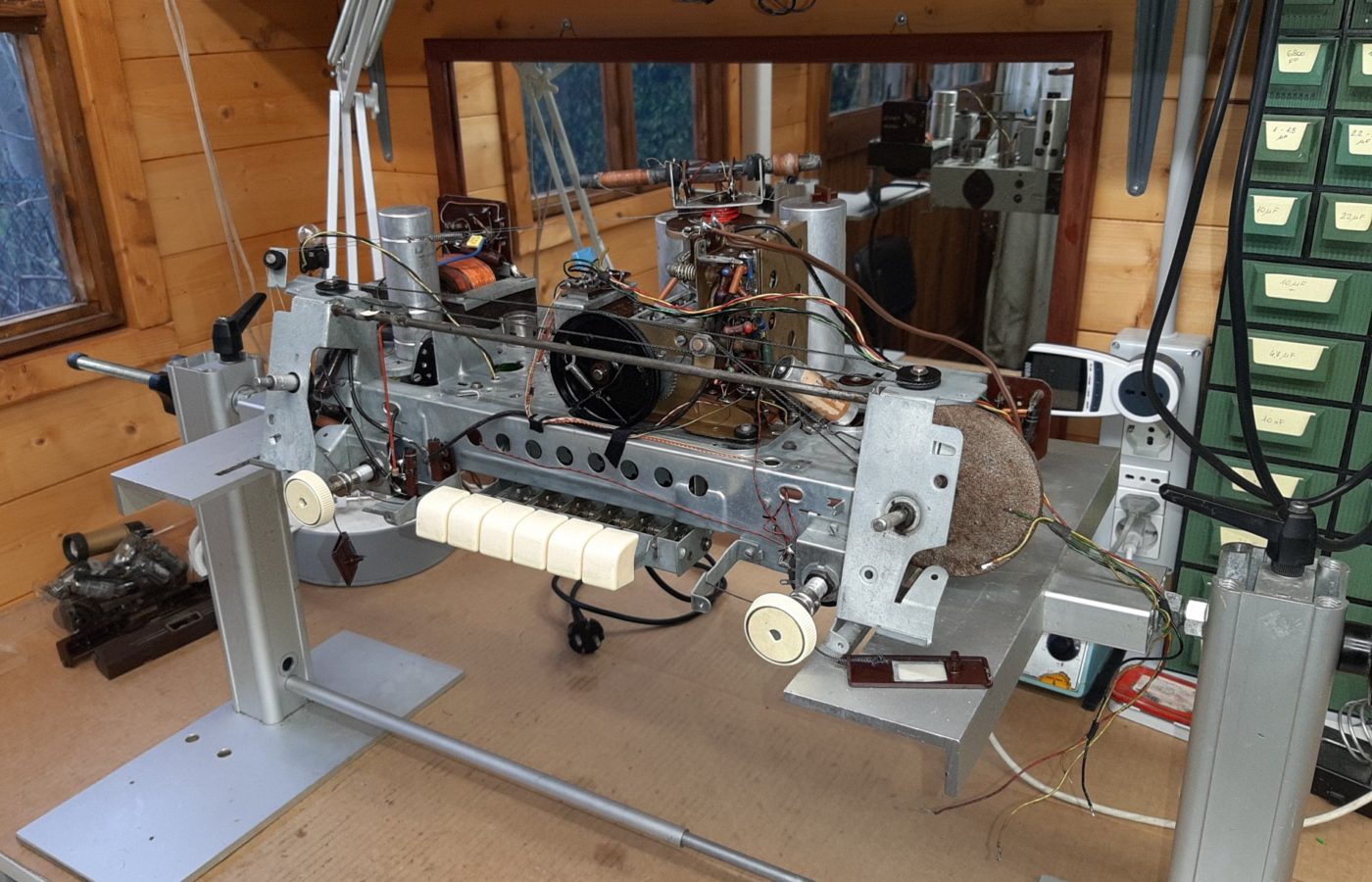



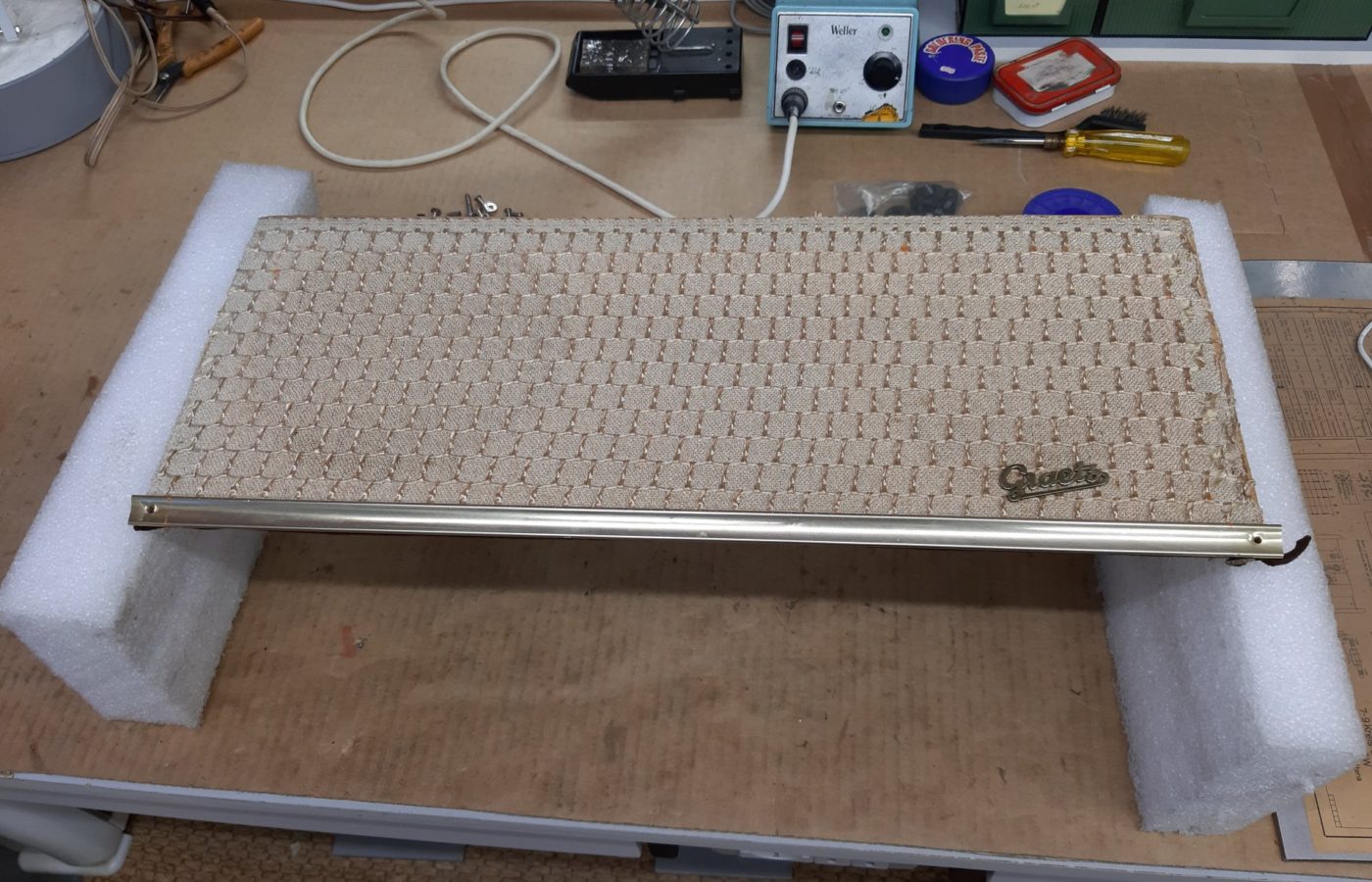




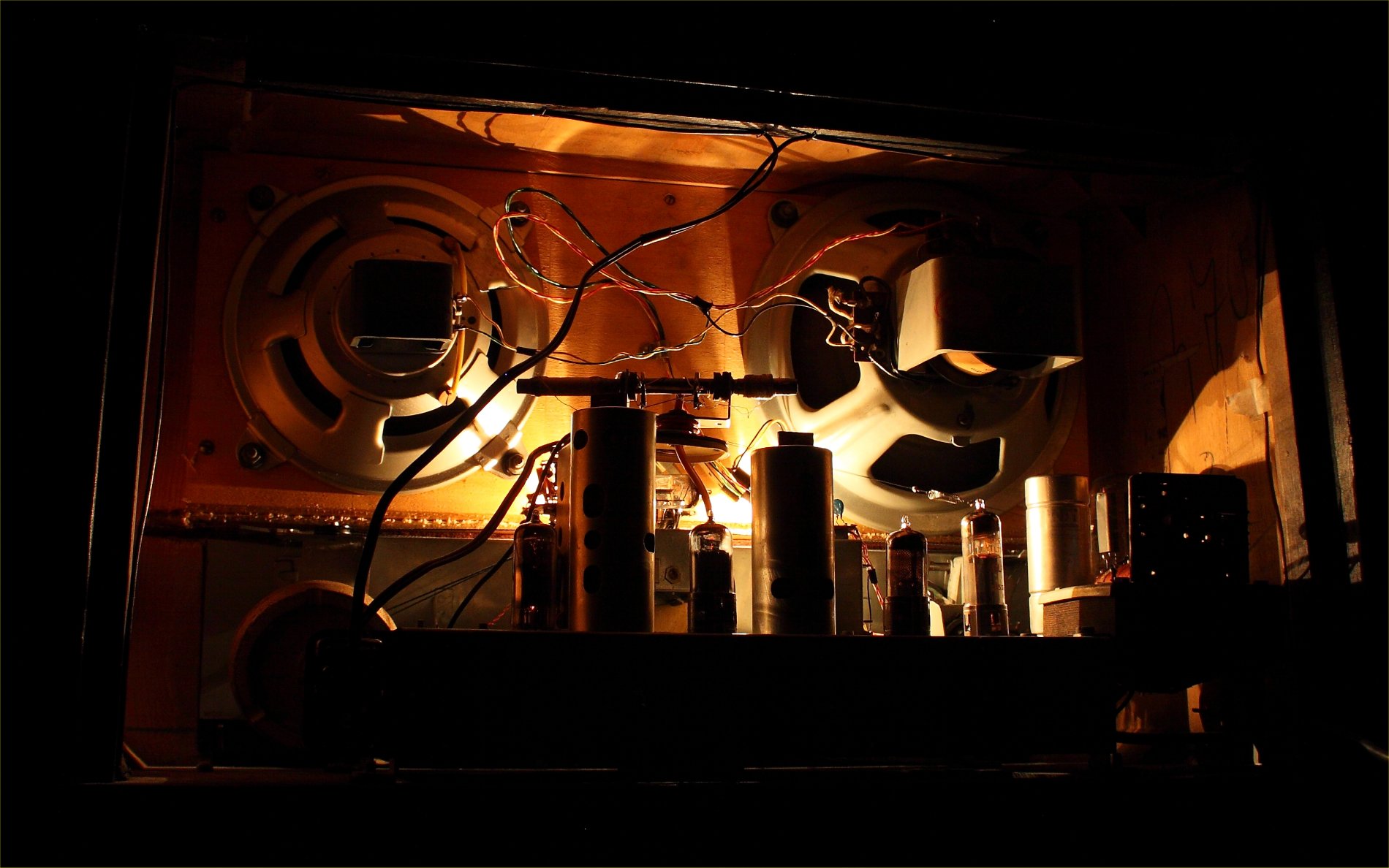
 5010 - en
5010 - en





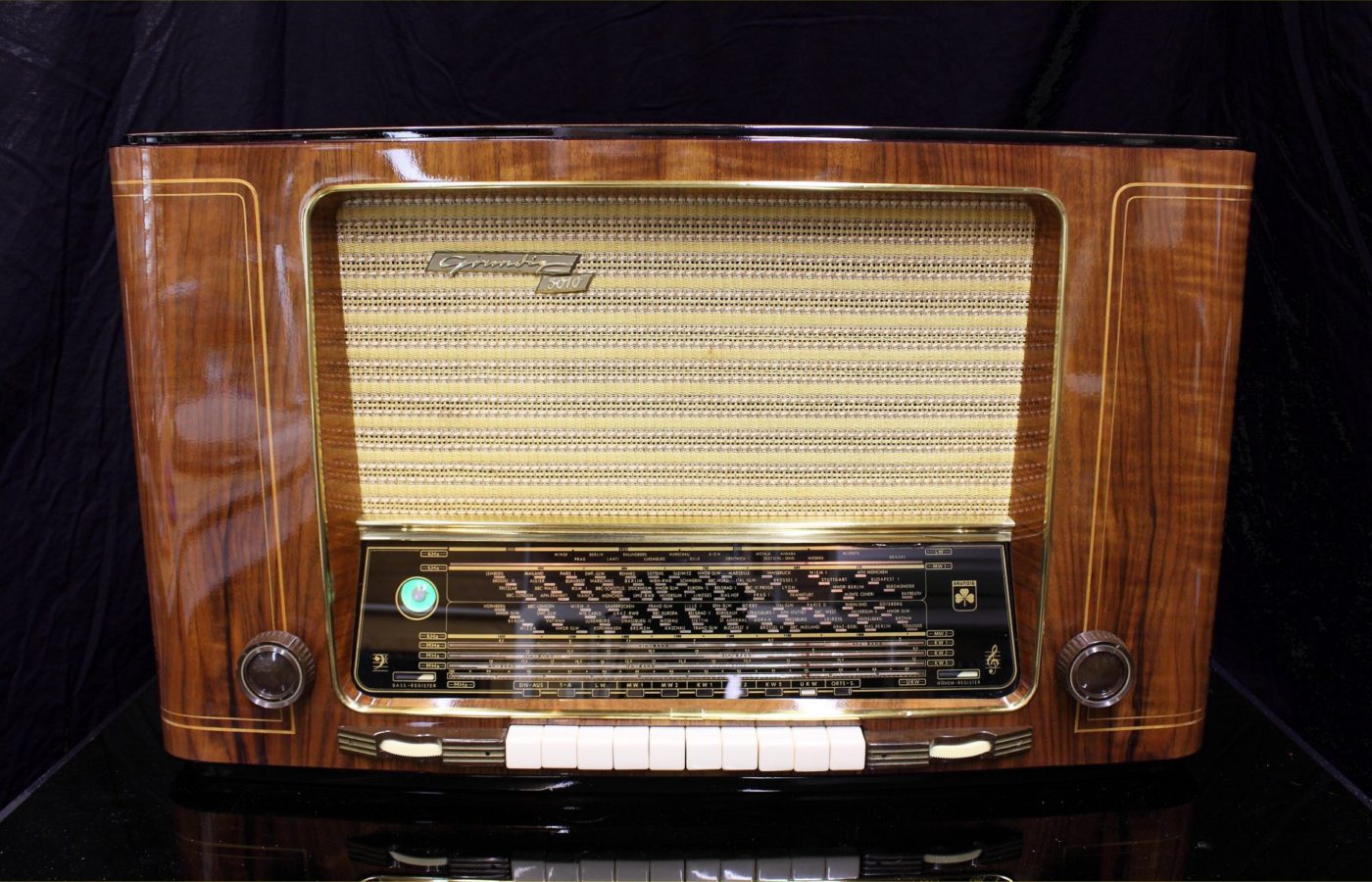










The Grundig 5010 is the most powerful monaural device ever built by this brand.
Grundig used to produce different classes of devices. Those in the 1xxx series are the cheapest, those in the 2xxx and 3xxx series are middle class, those in the 4xxx and 5xxx series are high class.
Clearly, the 5010 belongs to the higher class series, and it shows.
The electronic circuit of the 5010 is the most elaborate one could imagine in a commercial device built in 1952. The output stage consists of a pair of powerful EL12 push-pulls. No other manufacturer has used of these expensive tubes in a couple.
The output transformers are two, separate, one for the bass and one for the mid-high.
The first is equipped with a double secondary winding, one for the mid-woofer and one for the feedback circuit.
The mid-high transformer is also equipped with a double secondary winding, one for the cone mid-tweeter and one for the electrostatic tweeter.
The crossover consist of capacitors and coil networks. Really remarkable.
The tone controls are applied on the feedback network, further reducing the distortion, but risking instability when the potentiometer are in their extreme positions.
The Push/Pull phase reversal is provided by a dual triode ECC40, where each section drives one of the two EL12s.
The preamplifier is composed of the triode of an EABC80.
The power supply filter consists of a Pi filter of capacitor and inductor.
The FM antenna circuit consists of an EF80 pentode and the local oscillator consists of an EC92 triode.
As it is the only one, the variable capacitor is composed of many sections, for the AM and FM bands.
The tracks chosen for the test are only two. They are quite long as they have not been cut, they have been kept in all their duration. This is because they are both tracks that develop in different ways, alternating moments of pianissimo with areas of big explosion. In the case of the Overture 1812 this last statement must be taken literally.
Binker and Moses have recently emerged in the London jazz scene in the last few years and have the great merit of having aroused in young people an authentic interest in this musical genre, often followed by a more mature audience.
The song “Fete By The River” was recorded live at the Total Refreshment Center in London on June 26th 2017. This excellent recording recreates all the freshness and warmth that are typical of the duo's performances. The video, which is very well done, is also on Youtube, and it is worth seeing.
Drummer Moses Boyd can keep two different rhythms simultaneously, as if there were two drummers playing next to each other.
Binker Golding uses the entire excursion of the saxophone alternating very low and warm notes with disruptive and impressive high-pitched sounds . Binker alternates in a very instinctive way some pianissimo that are almost whispered and explosions of very colorful notes that fill the environment and manage to draw the listeners' attention.
A sequence of syncopated rhythms that has you on the edge of your seat until the end of the track and then bursts into a liberating applause of heartfelt participation.
There is a scent of jazz of the great masters.
The Grundig 5010, with its power and dynamics manages to convey all the expressive capacity of the duo with a realism that makes it hard to believe that it comes from a 1952 radio.
P.I.Tchaikovsky - 1812 Overture: one of the most controversial tracks, but certainly one of the most loved by the public was written to commemorate the Russian success in the battle of Borodinó on September 7th 1812, fought during Napoleon's campaign in Russia.
It was commissioned for the inauguration of the huge Cathedral of Christ the Saviour in Moscow, built by the will of Tsar Alexander I as a memorial for the Russian victory of 1812 over the Napoleonic army.
The overture begins with the orthodox song “Spasi, Gospodi, Lyudi Tvoya” (“God, preserve your people”). It then continues with the popular melody, “U vorot” (“At the gates”). This first part is meant to convey the joy of popular and religious life before the arrival of the Napoleonic troops, represented by the Marseillaise (which however was not used as a national anthem at Napoleon's time).
The decreasing that follows represents the withdrawal of the French troops from Moscow and the arrival of cannon shots marks the military advance of the victorious Russian army. The tolling of bells marks the end of the conflict and the Russian imperial anthem “Bóže, Carjá chraní!” (“God save the Tsar”) is heard in the background (this hymn was not in use at the time either, just like the Marseillaise!).
Even in this very difficult track, the muscles of the 5010 and its excellent speakers have allowed an exciting and distortion-free listening, even at rather high volumes. The engraving is the famous one by Telarc, and you can hear it.
Bluetooth receiver embed
Each radio is equipped with a cable for connection to any digital device.
- Bluetooth receiver embed - The unit is equipped with a BLUETOOTH receiver powered directly by the receiver power supply. This makes it possible to control the amplifier from any external digital device as an IPAD, a Smartphone, or a sophisticated multimedia station. So you can hear your preferred web station or your lossesless file without cables on the room. Wireless Receiver can be equipped upon requests.
- Multi Platform Connection - A customized adaptation cable to connect any digital device as Iphone, Smartphone, Laptop, CD Player etc. will be provided with this radio. This special cable suits the different impedances between the modern equipment and the receiver. Furthermore the two stereo channels flow into one without increasing the load to the input unit.
1930 - At 22 years old Max Grundig begin a radio repair business.
1939 - The II world War start. Grundig works primarily for the Wehrmacht and repair of telecommunication equipment.
1945 - Immediately after the war, the demand for repair work was very great. Max Grundig built the first two Grundig appliances: the Tubatest tube tester and the Novatest testing device.
1947 - Start the sale of a kit radio, the Heinzelmann. The unit is the basis of success, sold more than 15,000 pieces.
1950 - Very high frequency (VHF) is introduced to Germany and places new demands on the industry. Grundig launches the 380 W on the market.
1952 - The first television channel starts up in Germany. After intensive research, Grundig launches the FS 080 onto the market. In the same year the first portable tape recorder Reporter 500 L is created.
1956 - After a lot of radio produced with progrssively high performances was produced the Concert Radio 5080 equipped with an equaliser, which has five controls and a visual display.
1965 - A new factory is established in Braga, Portugal. The Satellit 205 is one of many appliances in the Satellit series. This product marks the beginning of Grundig production of high-quality global receivers.
1970 - The Audiorama 7000 Hi-fi was produced, it has twelve dynamic speaker systems in one speaker.
1976 - The Reel Tape Recorder TS 1000 is equipped for semi-professional use.
1980 - The slim-line Hi-fi Tuner ST 6000 and the Monolith Hi-fi Dynamic Flat Top Antenna, which has 22 speaker systems, are two particularly popular appliances in the new hi-fi range.
1984 - After severe drop in sales Philips increased its stake in Grundig 31.6 percent and takes over the corporate management.
1997 - Philips pulls out of its involvement with Grundig.
2003 - The company files for bankruptcy.
2008 - Turkey's Koç Holding took full ownership of Grundig Multimedia B.V., the parent company of Grundig Intermedia GmbH in Nuremberg.
Courtesy of: Grundig
Year of production: 1952/53
Superheterodyne IF 468/10700
9 AM circuits
10 FM circuits
Wavebands:
Long wave: 150 - 310 KHz
Medium wave 1: 515 - 945 KHz
Medium wave 2: 935 - 1620 KHz
Short wave 1: 5,9 - 8,6 MHz
Short wave 2: 8,6 - 12,5 MHz
Short wave 3: 12,5 - 18 MHz
FM: 86,5 - 100 MHz
Loudspeakers:
1 elliptical wideband
1 electrostatic tweeter
1 elliptical Mid/Tweeter
Dimensions (LHD): 706 x 414 x 305 mm / 27.8 x 16.3 x 12 inch
Net weight: 20 kg / 44 lb 0.8 oz
10 tubes:
EF80 EC92 EF85 ECH81 EM34 EAF42 EABC80 ECC40 2xEL12
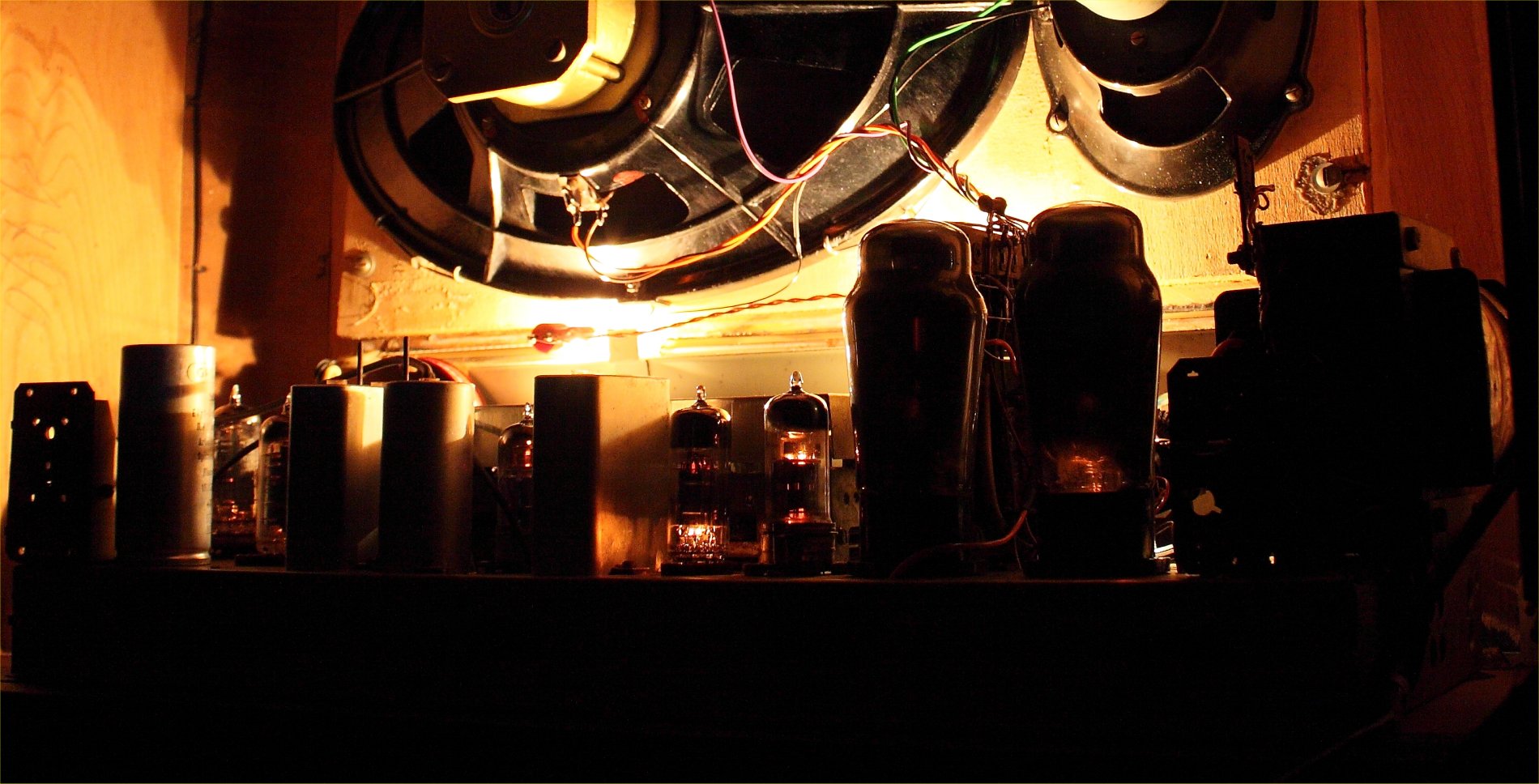
The tones control system is very efficient. Above the large tone control knobs there is a band that lights up gradually indicating the emphasis on the band on which it acts.
Interesting the high-tone control knob linked to two thin ropes. One of them is for the position indicator of the control itself, whereas the other changes the position of the ferrite in the MF transformers modifying the inclination of the transformer’s curve.
By doing so high tones were attenuated/accentuated even before getting to the BF stage. Tone control was usually put into effect with the potentiometer on the voltage amplifier stage
Inside the cabinet there is a dipole for FM reception.
One arm of the dipole is also used for receiving AM bands.
Listening FM band the reception sensitivity with internal aerials is very good.
For AM bands using an external antenna the sensitivity is good.
The picture shows the dipole fixed internally to the cabinet.

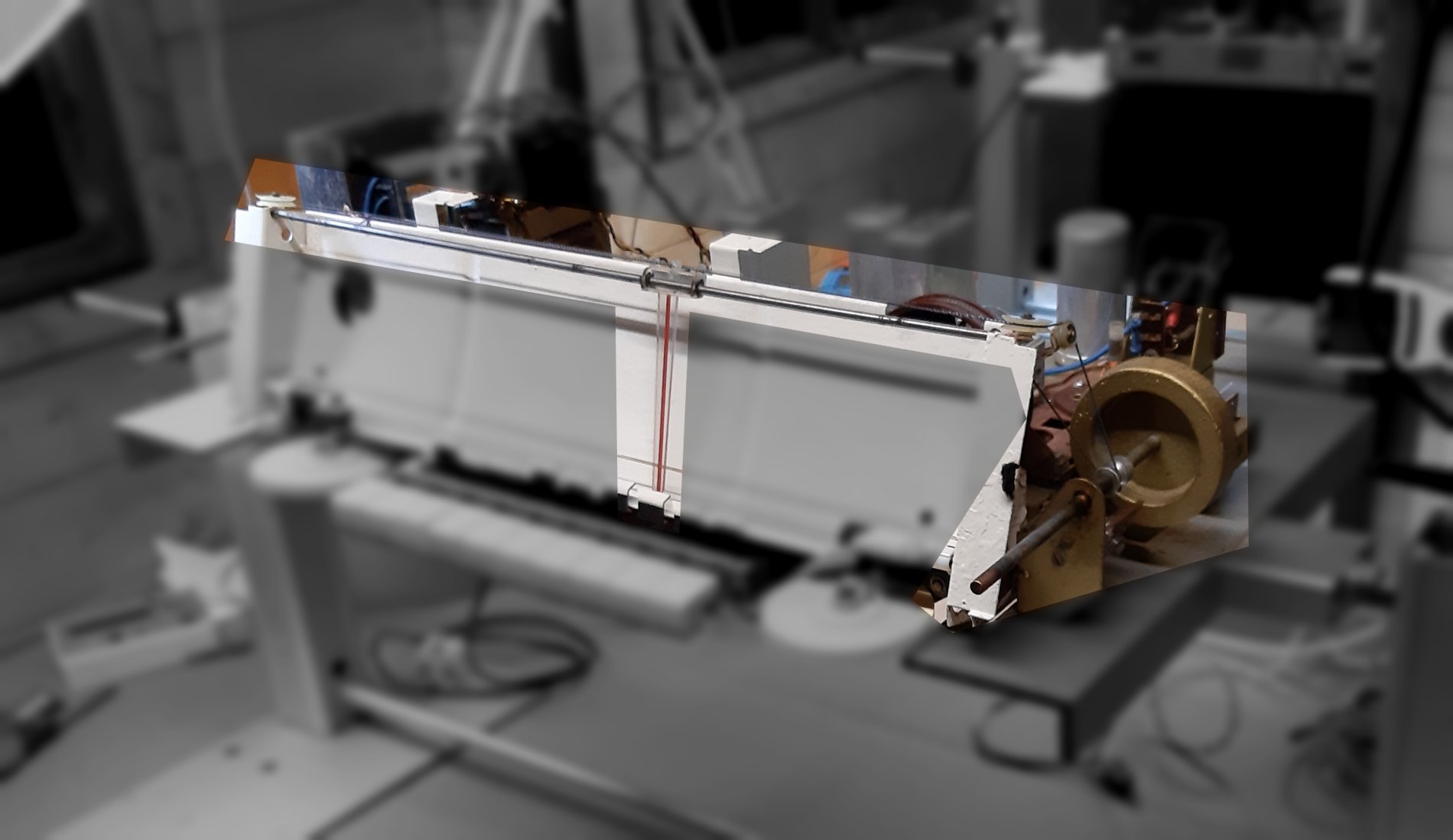
For both AM and FM bands the tuning system is unique.
The single variable capacitor is divided into 4 sections, two for AM and two for FM.
Each section is used respectively for the RF amplifier and the oscillator.
The mechanism is very simple and robust. It has the disadvantage of being a unique command for all bands.
The magic eye has of course been replaced.

There are three loudspeakers, all produced by Grundig.
The main wide band measures 13.8 in of width for 7.9 in of height. It covers a part of the radio’s width ..... that is so big.
A very interesting feature is that they are equipped with an adjustable basket.
This allows me to centre the cone movement with respect to the magnetic system.
The electrostatic tweeter is mounted in front of the main wideband. This gives a considerable presence effect to the musical reproduction.
The coaxial lodspeakers allow to locate the position, the depth with respect to the listener, of the various instruments or of the voice with significant precision.
It is a solution that I have always appreciated and that is found in the best radio devices.
The mid-tweeter has an oversized magnet. It has to tolerate considerable power peaks because it is cut very low.
The acute are unexpectedly crystalline whilst remaining very sweet.
The cones are cellulose treated and they are to this day in perfect condition, without any deformation or structural failure.
Objects built when they had to last “at least” the life time of the owner.
On the left you can find the volume control (with incorporated loudness).
Going to the right we find the tuning indicator, it reveal the perfect tuning of each station.
Below there are the bass knob.
By standing on the dialglass we see the Long Waves, the Two Mid Waves, the three Short Waves and the FM band.
The AM scale for Short, Medium, Long waves, and FM.
Finally, you see the treble indicator.
The tuning knob still remains to the extreme right side.
Below the dialglass we find the Bass control:
Then we see the keyboard whose keys have the following purpose respectively:
Power On / Off
Aux, LW, MW1, MW2
SW1, SW2, SW3, FM, MW (stored station)
Finally there is the knob of Treble control.





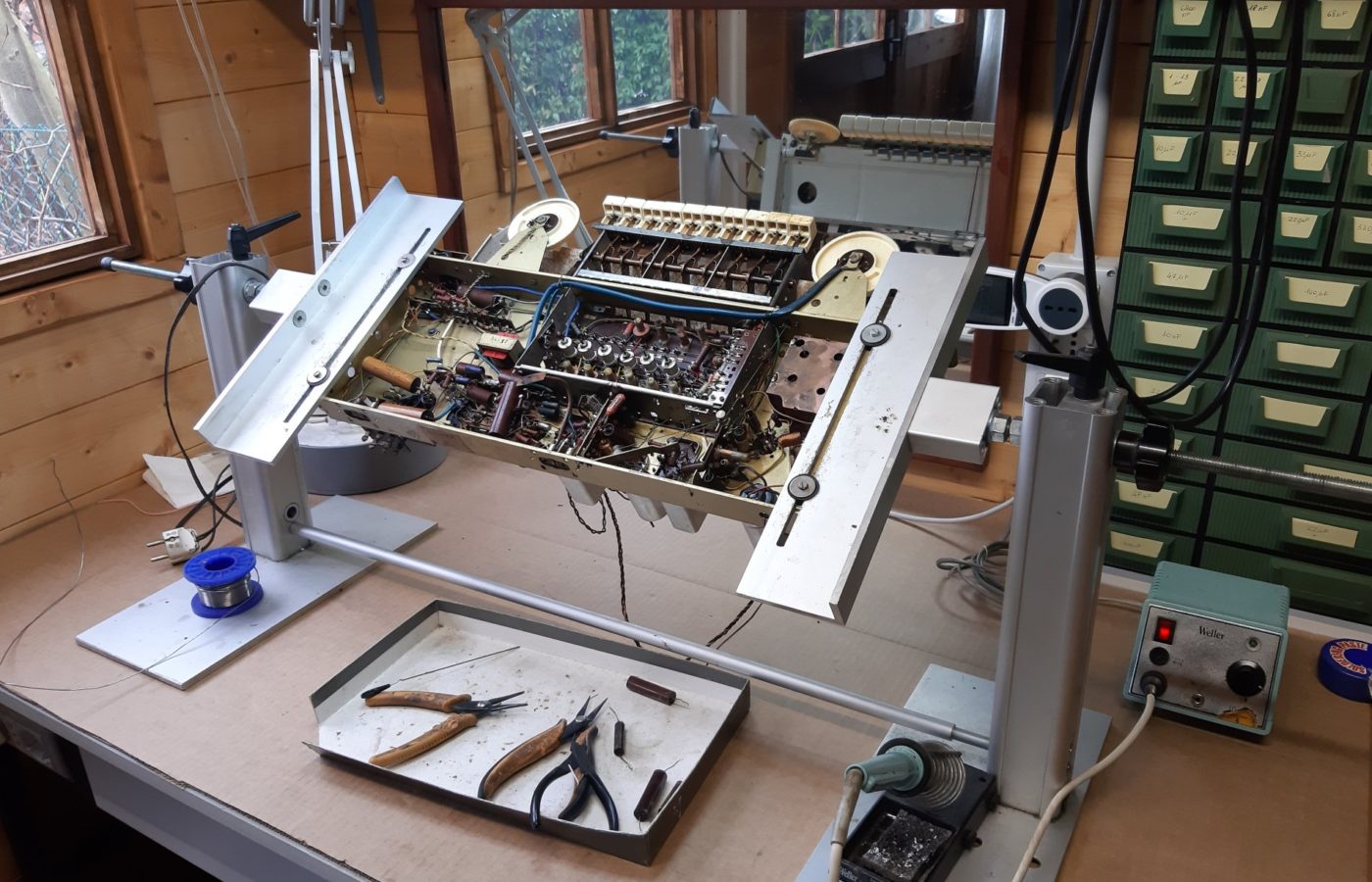


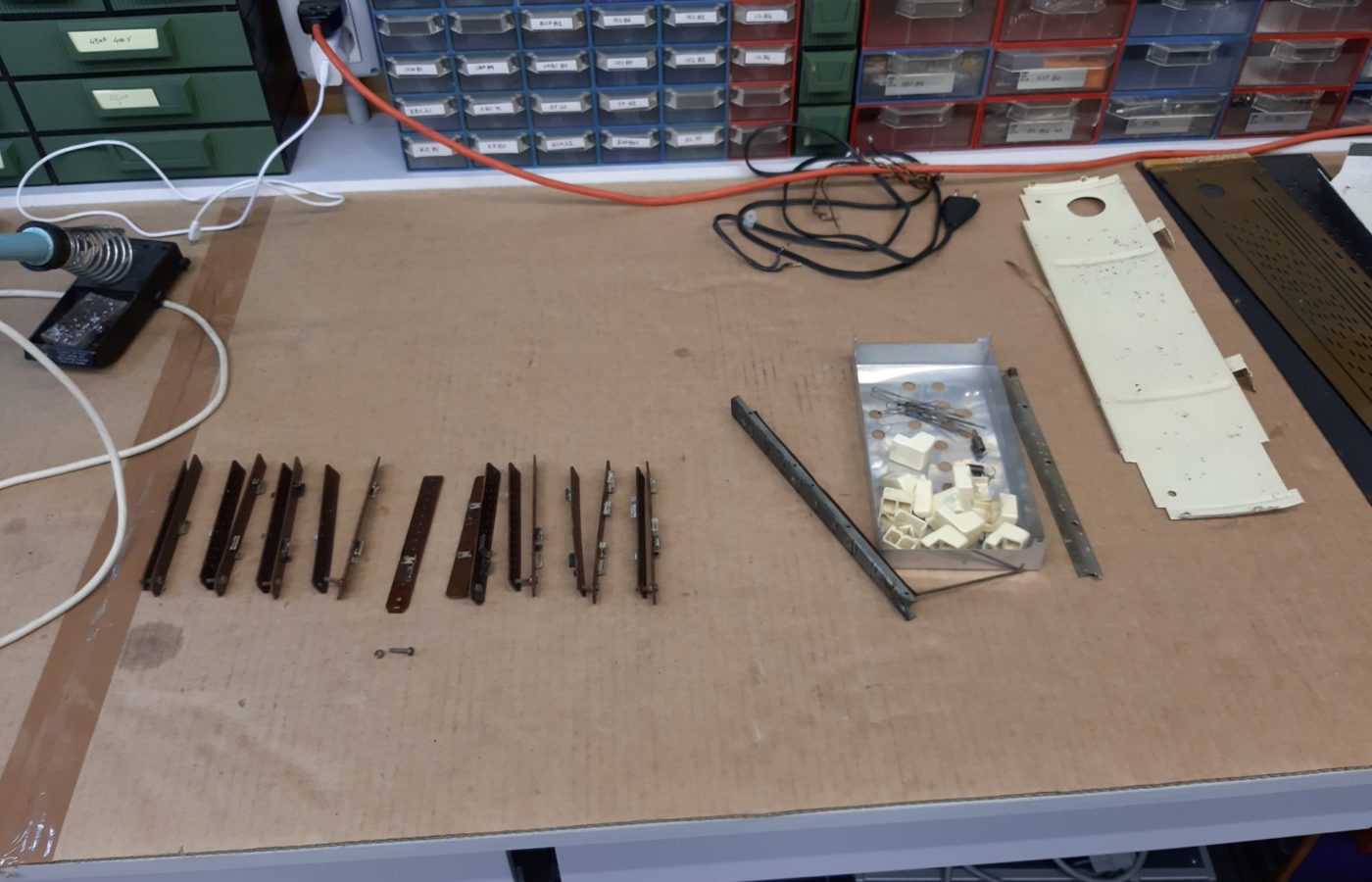













 bx998a - en
bx998a - en

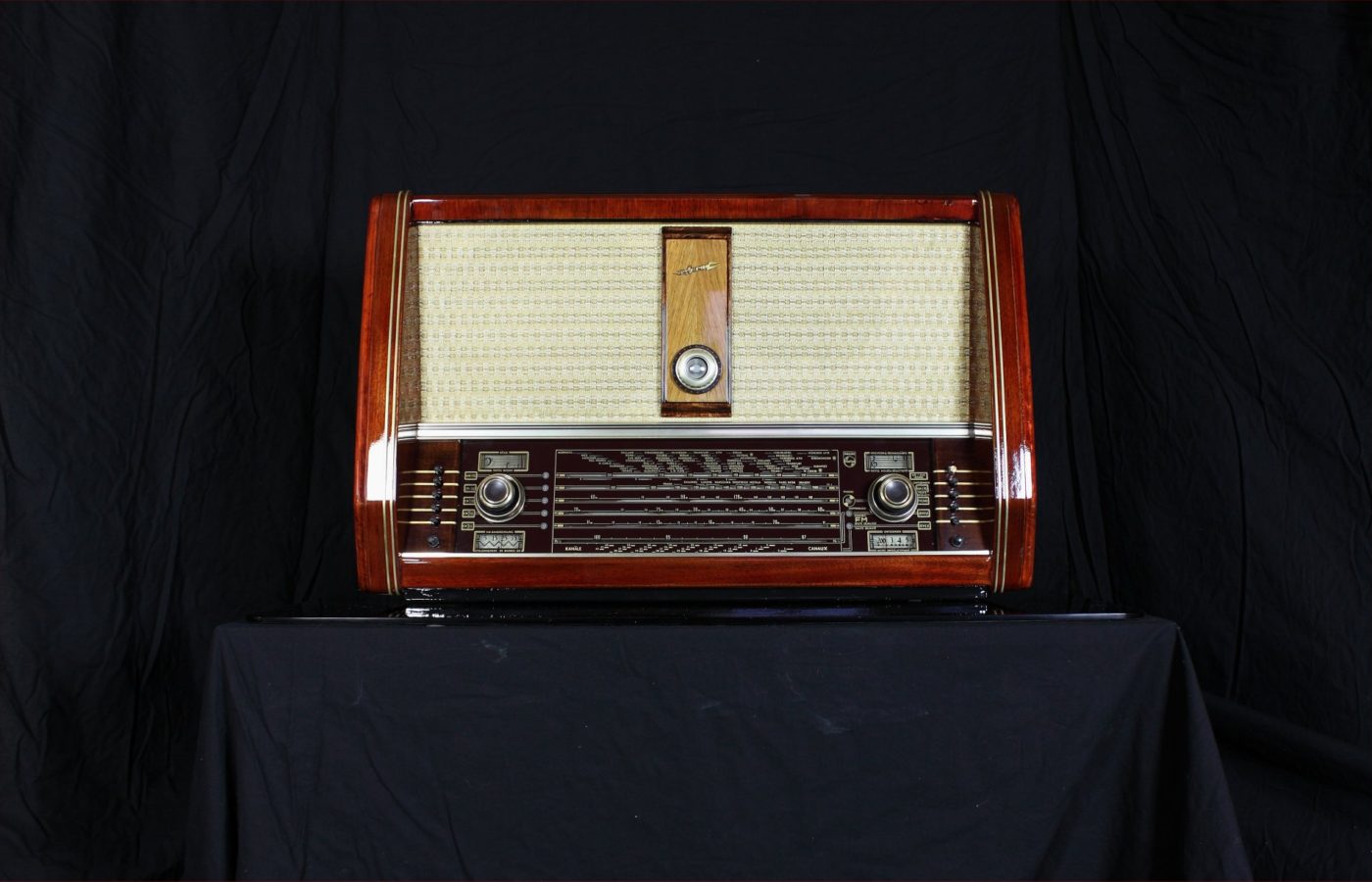

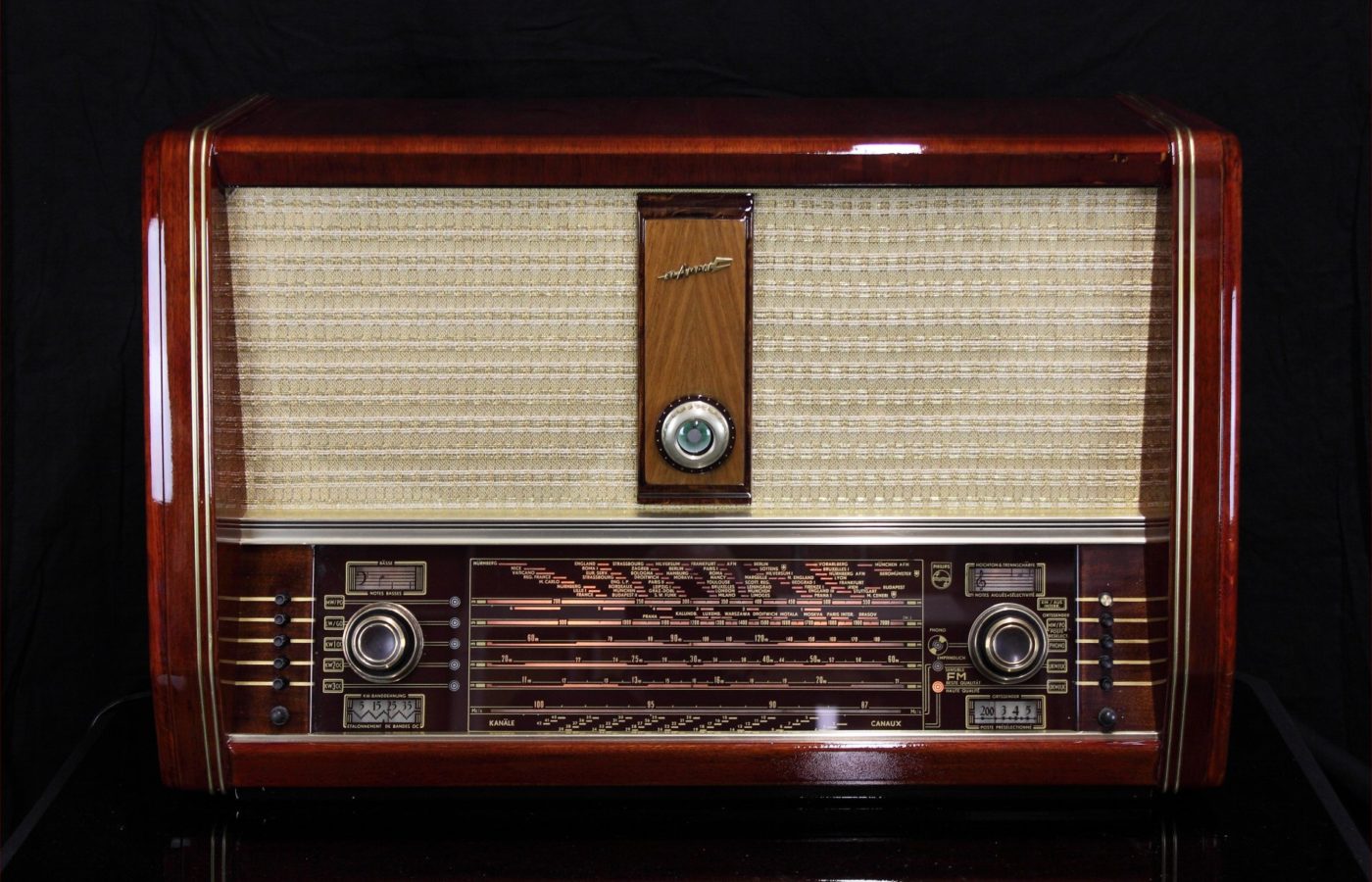
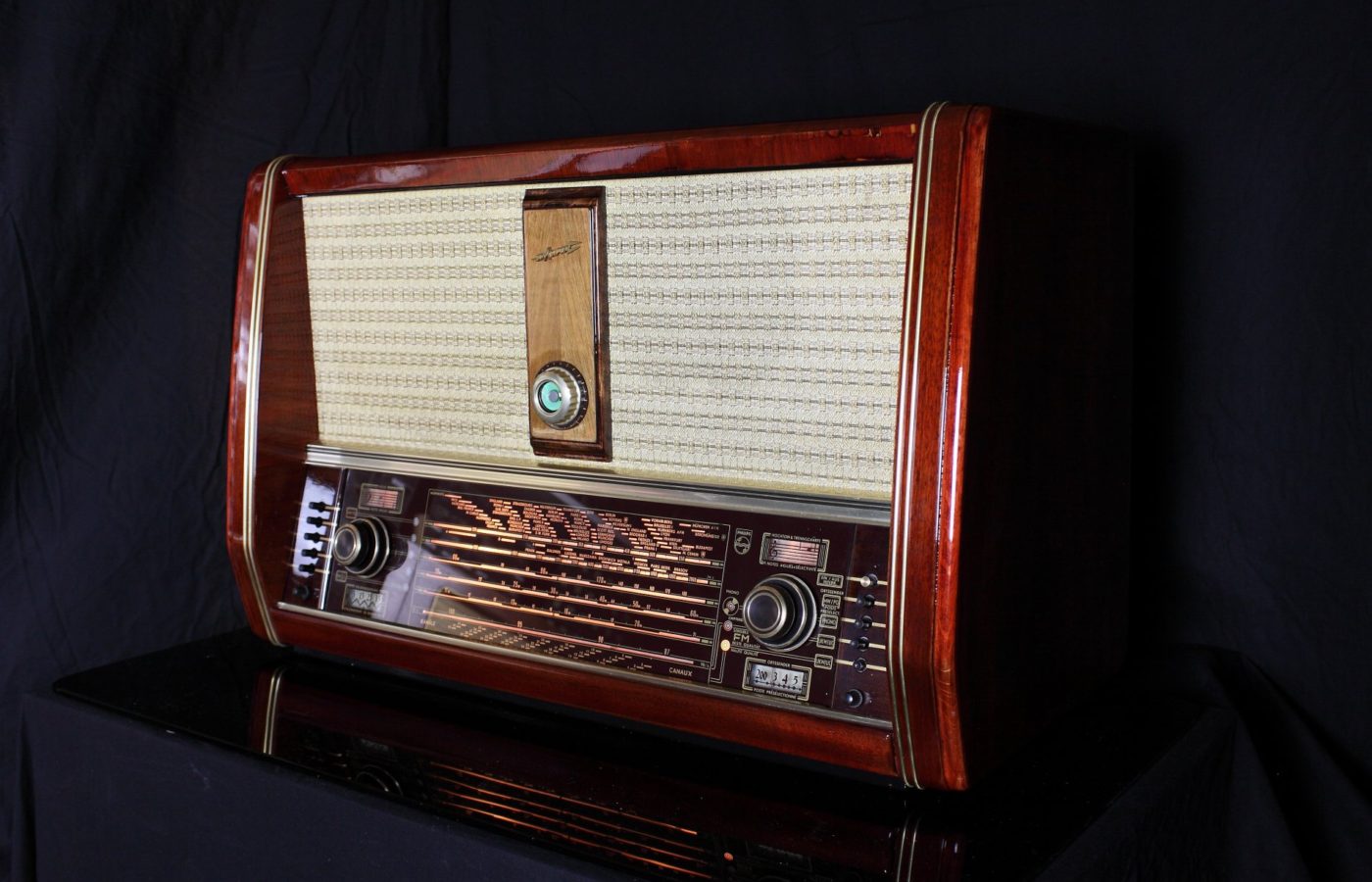


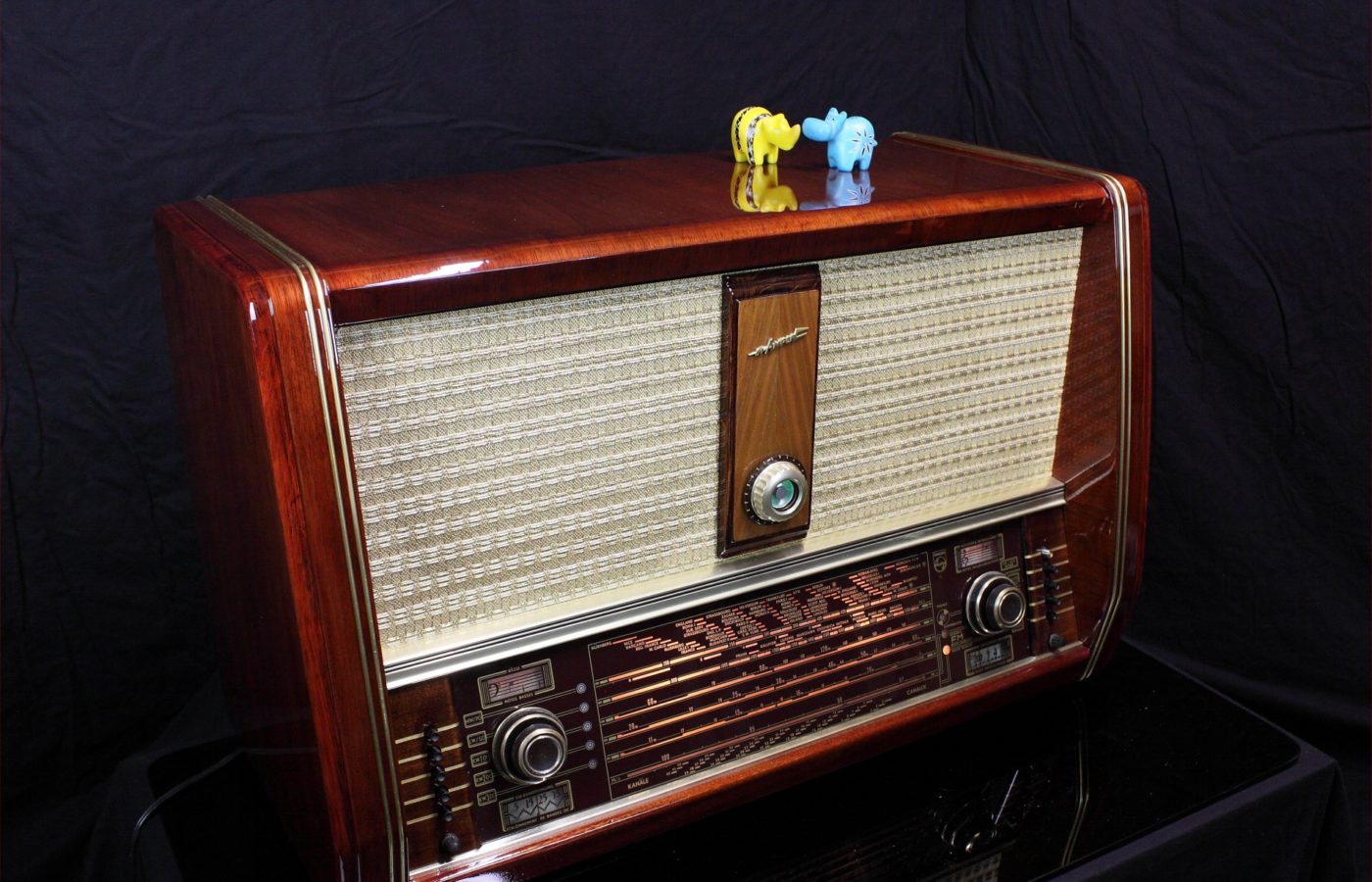



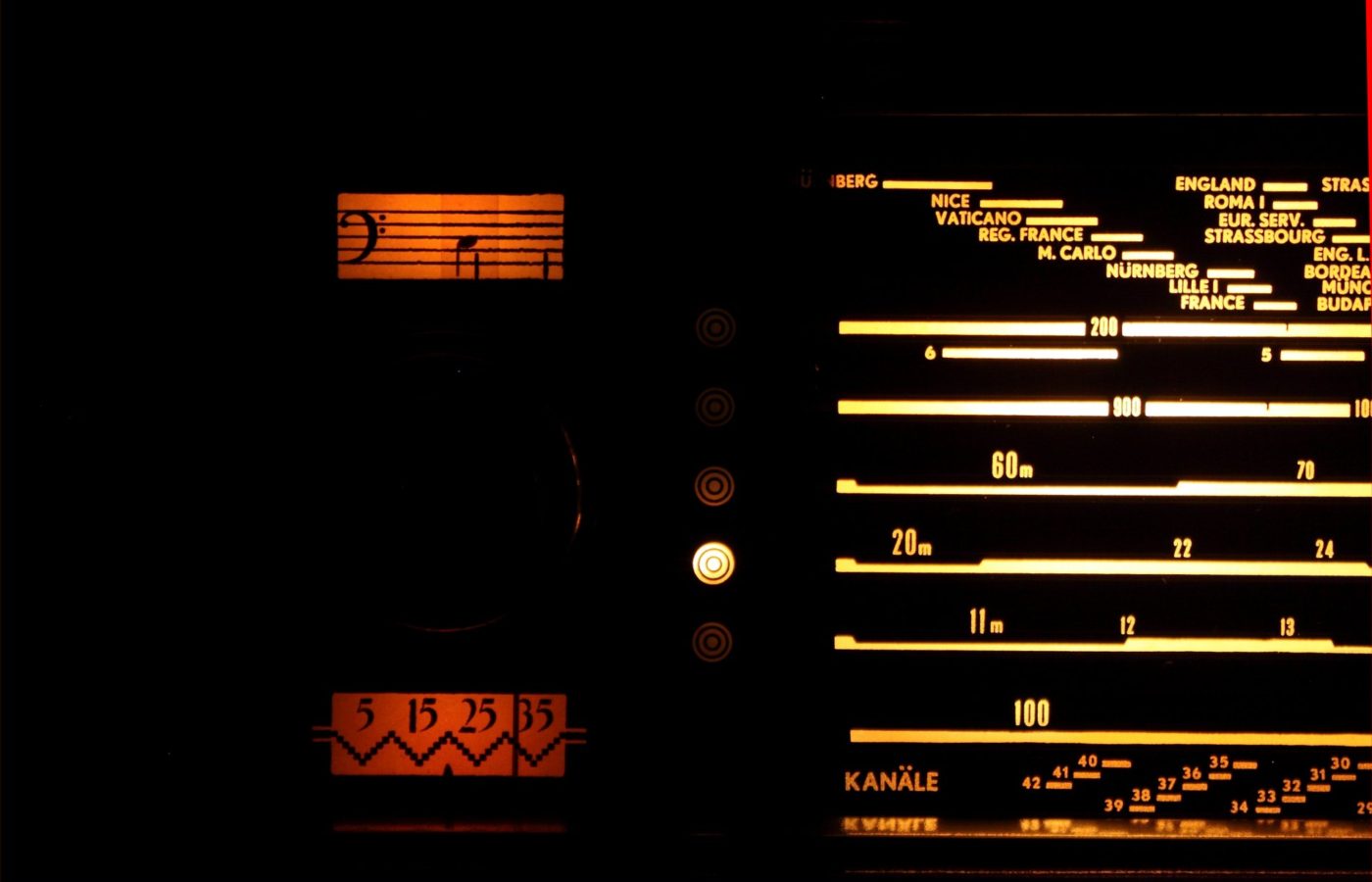



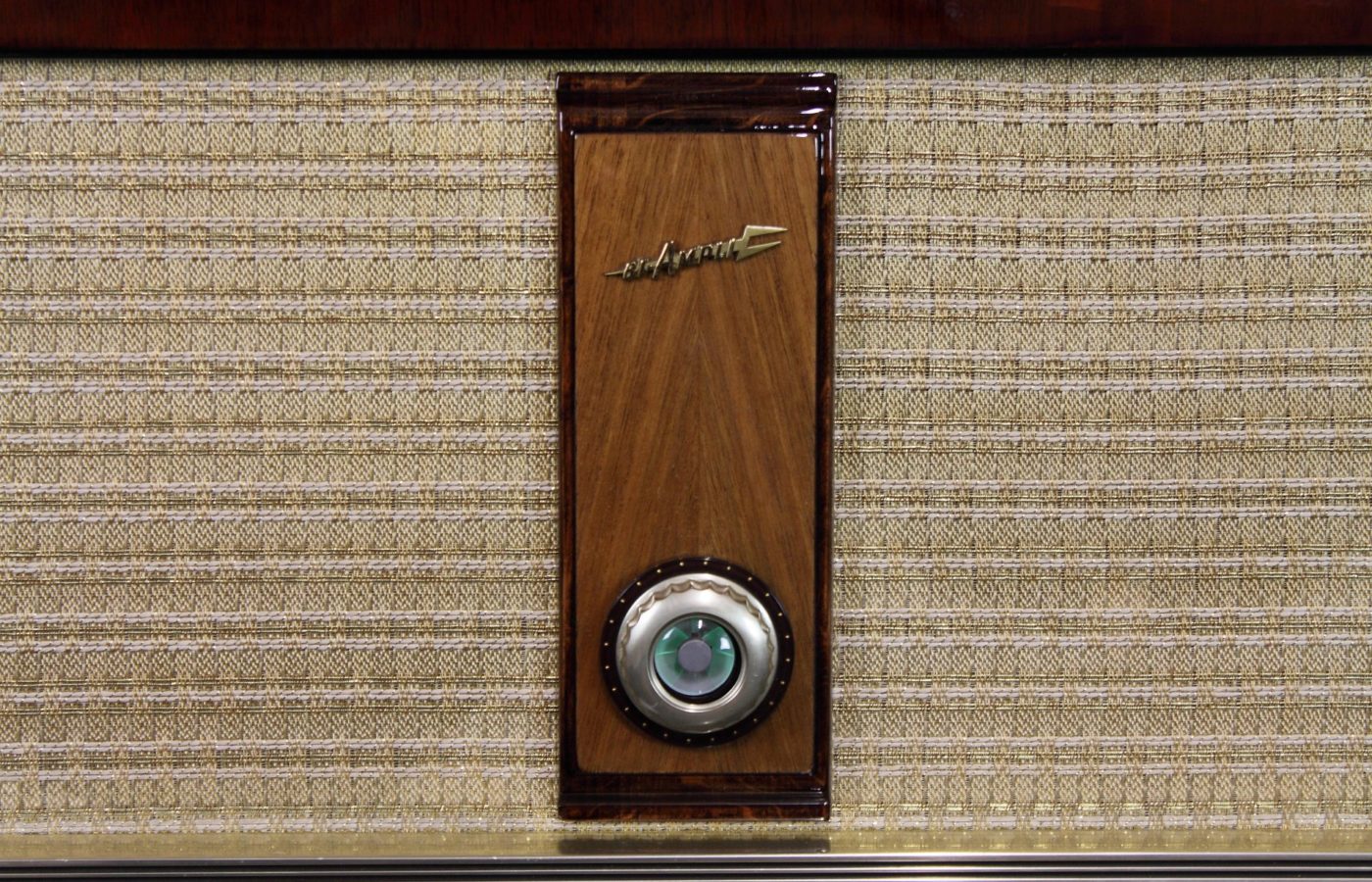

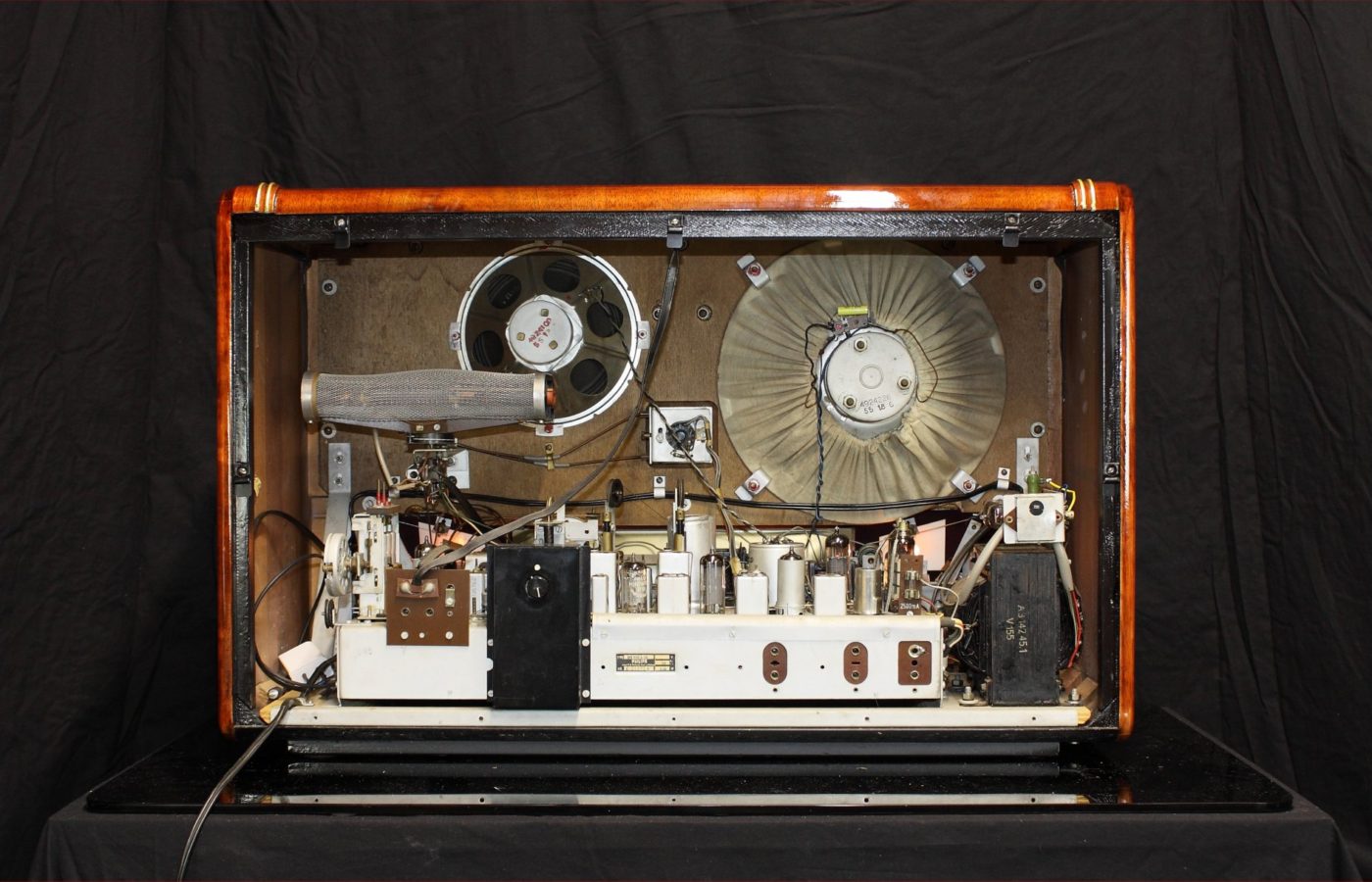

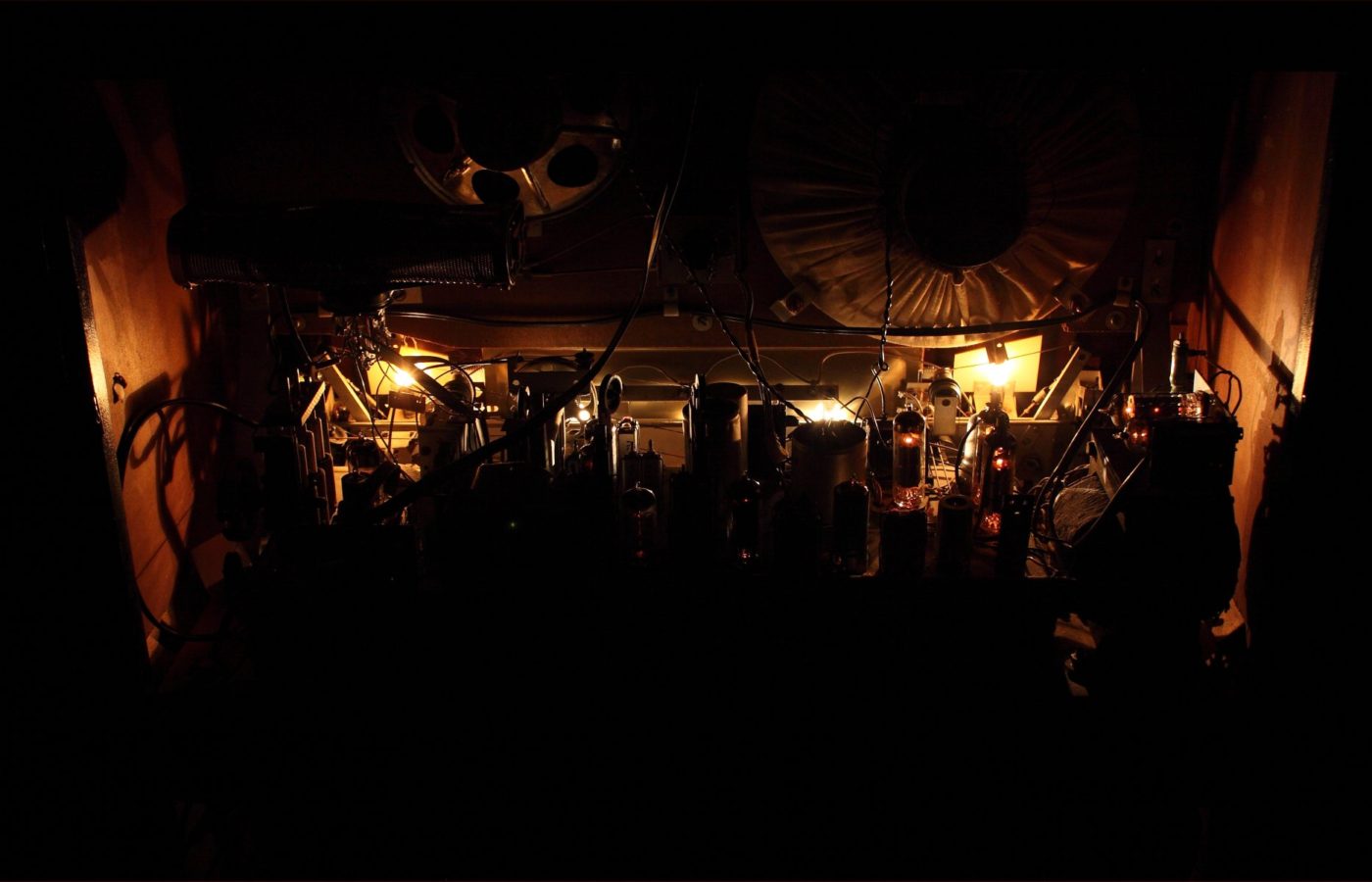
The Philips BX998A is the largest and most important radio a valvole device ever built by Philips.
It appears clear that only the performance and exclusivity required by the public to whom such device was addressed were taken into account in the design. There is no other commercial radio built in Europe which is equipped with 16 valves, some of which are double, for an equivalent of 22 single valves.
As I had the opportunity to discuss in the past with some lucky owners of this device, some valves could be saved, reducing the overall price of the device, but, clearly, the price was not the problem, on the contrary.
The Philips BX998A is equipped with some special features that make it exclusive in the context of European production of the time. These are:
- Motorized band selection
- Separate amplifiers for treble and bass
- Ironless Amplifier for the Bass (OTL)
- Double FM band with high and low sensitivity/quality
- Double Medium Wave band to store two simultaneous stations
- Two of the three shortwave bands with separate fine tuning
- High damping with feedback circuit
- High impedance woofer
All these precious things are analyzed in detail in the next page, so I won't talk about them here, in the general description.
The Philips BX998A has considerable dimensions with a front of 71 cm in width and 44 cm in height. The friezes of pure brass and the wooden surfaces of different colors significantly reduce the frontal impact of the cabinet, making it pleasant. The overall design is however the most classic and conservative that could be found at the time. Also in the design the orientation of the project to an audience of a specific social class is evident.
The bass are really deep. This is determined by the separate OTL amplifiers and the 26 cm diameter big woofer.
The excellent 17 cm diameter dual-cone mid-tweeter reproduces the medium and high range very softly.
The arrangement of the speakers favors frontal listening.
The High and Medium Frequency sections.
The FM group has high amplification and stability.
The FM Haute Qualité band is equipped with a automatic noise reduction in the presence of signals below 1.7 uV, the output is muted to avoid rustling and noises when searching for stations.
The deenphasis circuit is set to 50 uS, valid all over the world except for the USA and South Korea. In these countries the filter must be brought to 75 uS.
The AM section is equipped with an orientable antenna for the OM and OL bands. It can be controlled by the crown that surrounds the magic eye on the front.
The medium frequency sections are composed of 9 separate filters for AM and FM. With these filters it is possible to precisely adjust the sensitivity, selectivity and intervention of the noise suppressor.
The listening lacks the nervousness in the trebles which is necessary for the reproduction of Jazz, Rock and post Rock music. In fact, this radio is particularly suitable for listening to symphonic, lyrical and baroque music. The great choirs are expressed with incredilbe dynamism but, at the same time, the madrigal is reproduced with the necessary precision.
But what surprised me was listening to the bordone in Wagner's prelude to "Das Rheingold ". It is unlikely that a radio could do better with these musical genres.
The tracks chosen for the listening are dedicated to Dutch artists, such as the manufacturers of this device.
The first track is Pieter Bustijn's Suite N.6 in A min – Giga.
Pierre Bustijn (1649-1729) was a Flemish composer. Harpsichordist, organist and music box player.
Only his 9 Cembalo Suites survived the destruction of the Middelburg Archive during the Second World War. Almost nothing is known about him, but his nine harpsichord Suites were very popular at the time.
Bach's influence pervades the suites both in their melodies and in their form, clear in their elegant construction.
The second track, by Jan Pieterszoon Sweelinck, is taken from the 2012 KoninginnedagConcert requested by Queen Beatrice for the 450th anniversary of the composer's birth. Sweelinck studied with Gabrieli during his stay in Venice. Andrea Gabrieli (Venice 1510-1586), singer in San Marco, composer of madrigals and musics for triumphal occasions, such as the victory of Lepanto on 7 October 1571.
Sweelinck's great ability was to merge and renew the English counterpoint forms with the choirs of the Italian and German schools.
The reverberations and depth of live recording are noticeable when listening to the file.


![]()
The third track is dedicated to a Dutch harpsichord maker, Willem Kroesbergen.
It is a work by Bach, English Suites, interpreted by Masaaki Suzuki with a harpsichord built by Kroesbergen.
The harpsichord is the largest pluck and keybord instrument. It is used a lot in Baroque music as a continuum performer to build a solid sustenance plot for the piece. The sound is bright and full of harmonics.
Flanders were one of the most important harpsichord production centers. The instruments built by Kroesbergen are regularly used by soloists such as Ton Koopman and Masaaki Suzuki and by groups such as the Bach Collegium Japan and the Musica Antiqua Köln.
The fourth track is the Symphony No.1 "Pan" (1917) by Willem Pijper (1894-1947).
Of humble origin and self-taught, he was a pupil of Johan Wagenaar. He became director of the Rotterdam Conservatory, where practically all the Dutch composers of the 1900s were educated.
He was influenced by Mahler, Fauré, Debussy, up to evolve his research to contemporary music, inspired by Stravinsky and Schönberg.
The chosen track is taken from his first symphony, close to the Mahlerian symphonies. Pijper's later works will be very different.
The last song is by singer Anouk Teeuwe. The song is titled Nobody's Wife. Anouk is an award-winning Dutch singer, born in Den Haag in 1975. Her songs are of good quality, a pure and classical rock that is best expressed in concerts.
Bluetooth receiver embed
Each radio is equipped with a cable for connection to any digital device.
- Bluetooth receiver embed - The unit is equipped with a BLUETOOTH receiver powered directly by the receiver power supply. This makes it possible to control the amplifier from any external digital device as an IPAD, a Smartphone, or a sophisticated multimedia station. So you can hear your preferred web station or your lossesless file without cables on the room. Wireless Receiver can be equipped upon requests.
– Multi Platform Connection – A customized adaptation cable to connect any digital device as Iphone, Smartphone, Laptop, CD Player etc. will be provided with this radio. This special cable suits the different impedances between the modern equipment and the receiver. Furthermore the two stereo channels flow into one without increasing the load to the input unit.
In 1891, the brothers Gerard and Anton Philips, started to produce the first incandescent bulbs in Eindhoven.
Later, Philips specialized in the production of electro- medical equipment, and in 1918 introduced the first X-ray tube.
In the following years, Philips began specializing in the broadcasting industry. In 1932 the company succeeded in selling over one million radio equipment and became the world’s first producer.
During the Second World War, Philips transferred to the Netherlands Antilles, and returned to the Netherlands at the end of the conflict.
In the second post- war period, began the production of the first televisions, then the launch of the music cassettes in 1963 and the production of the first integrated circuit in 1965.
In 1982 Philips launched with Sony the first compact disc player.
In 1984 Philips acquired the control of the German Grundig.
In the 90's Philips faced a financial crisis.
In 1991 it inserted on the market the Video CD and it is one of the first companies in the world to develop high definition television.
In 1999 Philips established a joint venture with LG Electronics, named LG Display, which ends in 2009.
In 2006 together with Sony launched the first Blu-ray.
In 2009 Phillips launched the first full-HD LCD TV in 21:9 format.
Phillips holds 48,000 registered patents.
Currently, the production is focused on low- energy lighting products and LED systems and services for diagnostics and production of medical devices.
Year of production: 1955
Superetherodyne IF 452/10700
9 AM Circuits
11 FM Circuits
Wavebands::
Long Wave (150-345 KHz)
Medium Wave 1 (517-1620 KHz)
Medium Wave 2 (517-1620 KHz)
Short Wave 1 (1,6-5,2 MHz)
Short Wave 2 (5,1-15 MHz)
Short Wave3 (14,7-26,5 MHz)
FM 1 (87,5-100 MHz)
FM 2 (87,5-100 MHz)
Loudspeakers:
1 woofer
1 mid-tweeter
Dimensions (LHP): 710 x 440 x 317 mm / 28 x 17.3 x 12.5 inch
Net weight: 28,1 kg / 61 lb 15.9 oz
16 Tubes: 2xEBF80, ECH81, EF80, EC92, EM34, EF89,EF85, EAA91, ECC83, EBC41, 2xPL81, EL84, 2xEZ80


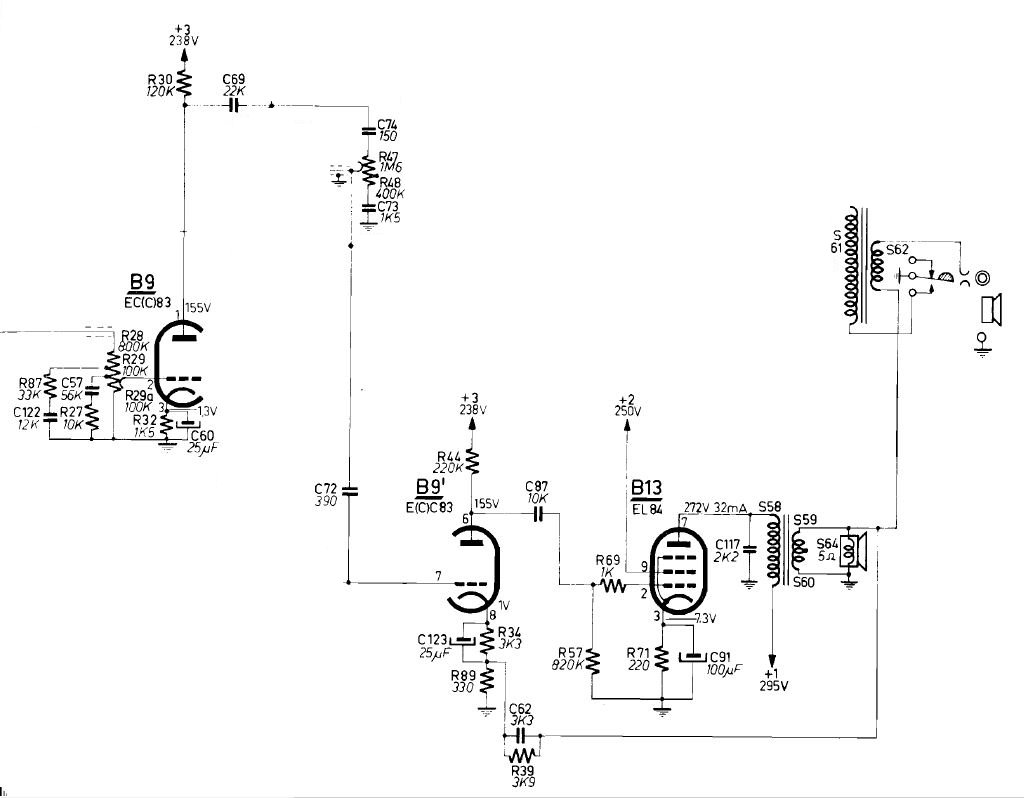
The output stages are two, distinct, one for low and one for high frequencies.
The first stage of the preamplifier is unique and drives both the output stages. It consists of a section of the ECC83 double triode.
On this section is the volume control with two physiological corrections of the frequency response (loudness). At the output of this section are the two Baxandall type tone controls. At this point the bass and trebles are divided.
The bass tone amplifier is of the SRPP (shunt regulated push pull) type, with no output transformer (known to be the critical point of the stadio finale).
This configuration is still used today in some HIGH-END voltage amplifier.
The output transformer limits the frequency response of the entire amplifier. The bass are limited by the primary winding inductance.
The two PL81 output tube of each channel are connected in series with DC-DC coupling. Each PL81 is configured as a triode.
The output is taken from the cathode of the first PL81. The speaker has an impedance of 700 ohms, identical to the average impedance that occurs on the cadhode, so direct coupling (without transformer) between the output stage and the speaker is possible.
Therefore, the Philips BX998A is totally free from all the problems deriving from the output transformers.
This amplifier controls a 26 cm woofer.
The treble amplifier consists of the second section of the ECC83 double triode and a output pentode, EL84, configured in class A.
The output transformer in this circuit has no critical issues anymore since it cannot be saturated by low frequencies. Moreover, this is a high quality transformer, with the winding layers alternating between primary and secondary.
Finally, the damping of the speaker is kept high by the low dynamic resistance of the feedback circuit.
This amplifier controls a 17 cm Mid-Tweeter.
Another feature of the Philips BX998A is the motorized band selection.
On this radio you can hear from nine different possible origins.
Long waves, two bands in medium waves, three bands in short waves, two bands in FM, auxiliary input (Bluetooth).
Given the mechanical complexity, and therefore the fragility, that would have been necessary to build a band selector suitable for Philips, they decided to divide the selector into two separate selectors, one rotating and one slide. The two selectors are mechanically connected to each other.
The rotating switch is operated by a motor which, thanks to a series of switches and cams, rotates the selector to the position determined by the band button that has been pushed.
This mechanism ensures regular rotation and protection of the contacts for a long time.
Of course, the mechanism must be cleaned and lubricated from time to time. Regular maintenance should be done at least every 10 years.
I understand that we live in an era where an 8-month device is considered obsolete, but for these machines it is not like that.
During the rotation of the motor, a Muting circuit start, therefore no annoying noise is reproduced on the speakers.
The tone control system is very efficient. Above the large knobs of the tone control, separate for highs and lows, there are two separate windows for low and trebles.
It is very nice to see the note that goes down in the pentagtam as the basses are accentuated in the window with the FA key and see the note that goes up in the pentagtam as the trebles are accentuated in the window with the treble klef.
The treble control knob is connected to the ferrite in the MF transformers and makes it vary the curve slope of the transformer itself. In this way, when in the AM bands, the trebles are accentuated even before the arrival in the amplifier stage.
Inside the cabinet there is a dipole for FM reception and a ferrite rotating aerial for AM reception.
Ferrite aerial can be rotated from the outside to achieve a perfect tuning of the device in the AM.
In this picture see the rotation mechanism and the position indicator of the aerial.
To reach an excellent reception of short waves, turn the antenna contact downwards (red arrow) and insert the external antenna on the appropriate socket (yellow arrow).
The magic eye has been replaced.

Two speakers are used in this device:
Philips 9758A
Woofer
Diameter 26 cm/10.2"
Frequency response 45-10.000
Impedence 700 ohm
Philips 9768M
Mid-Tweeter doppio cono
Diameter 17 cm/6.7"
Frequency response 95-15.000
Impedence 5 ohm
A connection with external 5 ohm speakers is provided, however leaving all the other speakers active.

2 - MW1 button
3 - LW button
4 - SW1 button
5 - SW2 button
6 - SW3 button
7 - Fine Tuning knob for SW2-SW3
8 - Bass display
9 - Bass knob
10 - Loudness knob
11 - Fine Tuning display for SW2-SW3
1 - ON/OFF switch
12 - Treble display
13 - Treble knob
14 - Tuning knob
15 - MW2 display
16 - MW2 button
17 - AUX button
18 - FM1 button (High Sensibility)
19 - FM2 (High Quality)
20 - MW2 knob
